VLA CASA Pipeline-specline-CASA6.6.1
Introduction
When VLA observations are complete, the raw data need to be calibrated and imaged for scientific applications. This is achieved through various steps as explained in the VLA CASA tutorials. The different calibration procedures are also bundled in a general VLA calibration and imaging pipeline that is described on the VLA pipeline webpage. The pipeline can process continuum and spectral line data. More complex data reduction, like polarimetry, high dynamic range imaging, moving targets (ephemeris), or mosaicking is currently not supported, but might be in the future. The pipeline is supported for Linux and experimental for macOS.
At NRAO, the pipeline is executed on every science scheduling block (SB) that the VLA observes successfully. After some additional quality assessment, the pipeline products will be archived for anyone to use and the PI of the SB will receive a notification. Every PI should assess for themselves if the data quality is adequate for their science. It is possible or even likely that some modification is needed. Examples are additional flagging, different imaging parameters, or applying rest frequencies to spectral line cubes, etc. Some of it can be achieved through modifying the pipeline (cf. VLA pipeline webpage), other changes may require the use of CASA, astropy, or other (radio interferometry) software packages.
The VLA pipeline and VLA pipeline imaging webpages describe how to run, modify, and re-execute the VLA pipeline. There are also instructions on how to restore archived pipeline products as well as a list of known issues. Many steps, in particular, after calibration are very similar to the ALMA pipeline (see also Hunter+ 2023). ALMA also provides tutorials on how to run and modify the pipeline and how to read their weblog on the EU ALMA I-train webpage.
In the following, we provide an example of a VLA pipeline weblog as it would be delivered from NRAO to the user, explain the different pipeline stages, and describe some of the diagnostic information and plots. Frequent issues with VLA data and how to address them with the pipeline are also discussed on the Pipeline: Frequent VLA problems page, where signatures and treatment of problematic data are described.
The Pipeline Weblog
A pipeline run can be inspected through its weblog that is created during the execution and can be launched by pointing a web browser to file:///<path to your working directory>/pipelineTIME/html/index.html. Note that we regularly test the weblog on Firefox but less so on other browsers. So if you don't use Firefox, there's a chance that not all items are displayed correctly. Additionally, some browser security features may prevent the weblog from being displayed. The weblog may actually show a warning and a solution in the browser.
The following discussion is based on a weblog of a K-band spectral line and continuum VLA dataset that can be viewed through the following link:
Pipeline Weblog
Alternatively, the weblog can be downloaded from https://casa.nrao.edu/Data/EVLA/Pipeline/Specline-CASA6.6.1/VLApipe-spec-weblog-CASA6.6.1.tar.gz (149 MB)
and extracted via:
# In a Terminal
tar xzvf VLApipe-spec-weblog-CASA6.6.1.tar.gz
then point your browser to html/index.html (as of CASA 6.6.1 there can be a security setting in Firefox that needs to be set first; the weblog will prompt you with instructions if this is the case [frequently go to "about:config" in Firefox and set security.fileuri.strict_origin_policy to false]). Chrome may not show all items properly unless started like Chrome --args --allow-file-access-from-files /path/to/weblog//html/index.html).
At the top of the landing page one can find the items Home (the index.html landing page), By Topic and By Task that provide navigation through the pipeline results.
Home Screen
The Home page of the weblog (Fig. H-1) contains essential information such as the project archive code, the PI name, and the start and end time of the observations. The CASA and pipeline versions that were used for the pipeline run are also listed on this page, as well as a table with the MS name for the entire observation, receiver bands, number of antennas, on source time, min/max baseline lengths and their rms, and the file size BEFORE CALIBRATION (after processing and adding the MODEL and CORRECTED_DATA columns, the file size triples).
The data were processed with earth orientation parameters that were available at the time of the processing. The pipeline uses predicted parameters when current ones are not available. The respected file versions for predicted and evaluated earth orientation parameters are listed under "IERSpredict" and "IERSeop2000", as provided by the International Earth Rotation and Reference System Service (IERS). Note that it usually takes a few months until the IERS re-evaluates and publishes updated earth orientation parameters. While the actual numbers change numerically after obtaining new parameters, the differences for VLA data are usually small and scientifically insignificant.
Since we also include calibration, spectral line, continuum, and target imaging, the weblog displays four MeasurementSets: the full one used for calibration, one that separates the science targets from the main MS (*_targets.ms), and further separations into continuum data and spectral line spectral windows (spws) (*targets_cont.ms, *targets_line.ms). Note that the *targets_cont.ms contains spectral line spws, but any strong line has been flagged.
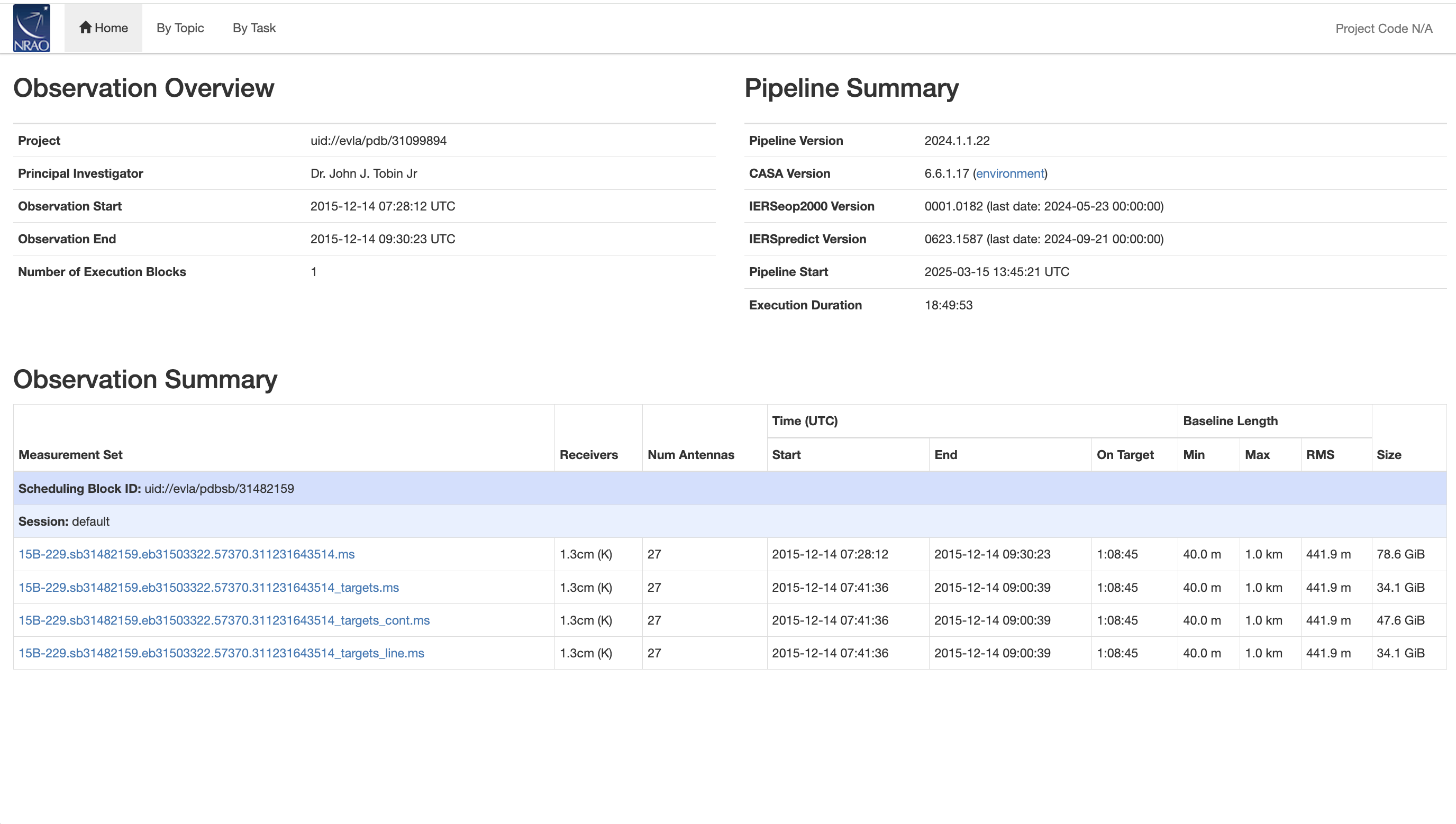
Overview Screen
An Overview of the observations (Fig. O-1) can be obtained by clicking on the MS name. As mentioned above, we look at the first MS, which is the full MS that is used for calibration. The other MSs show analogous information.
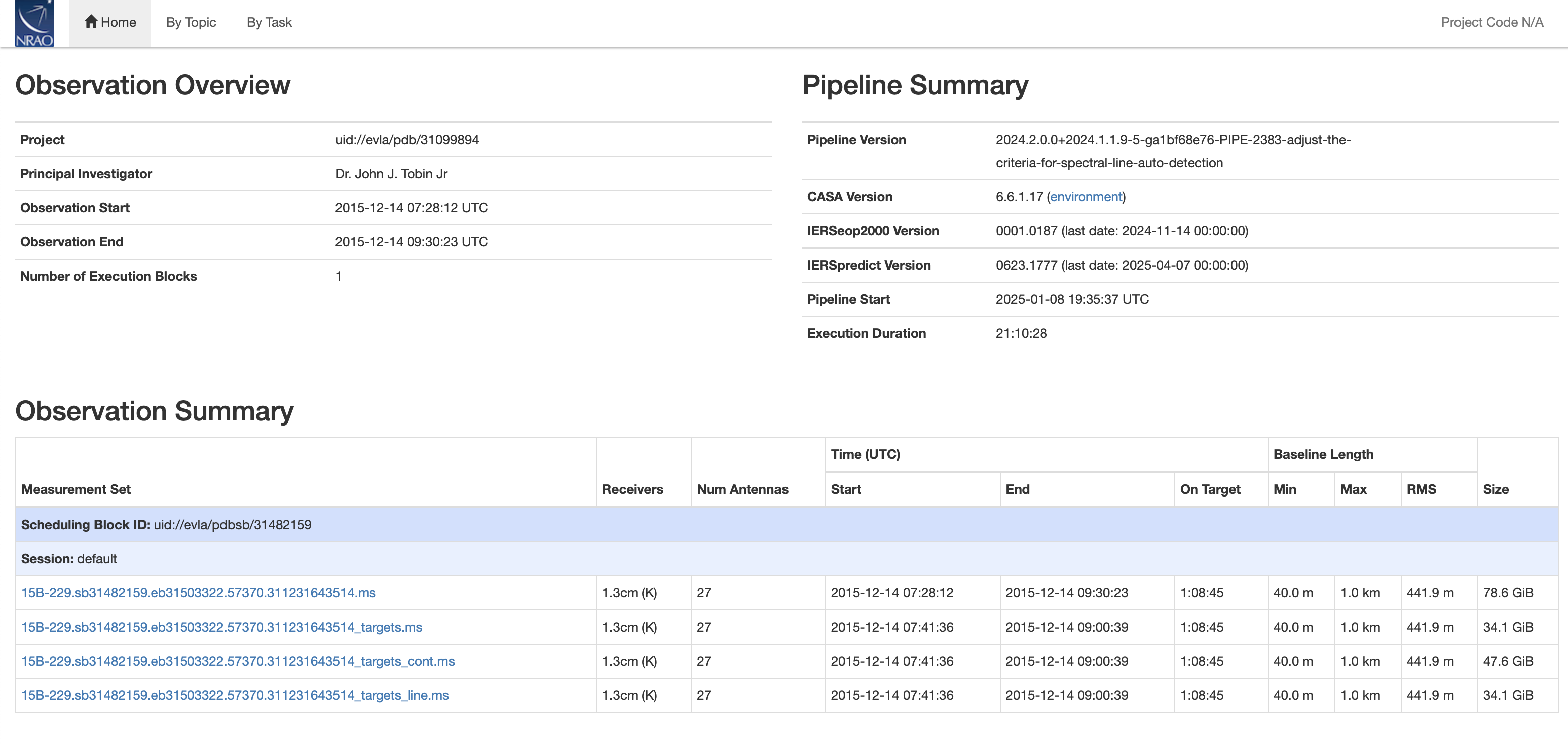
This page provides additional information about the observation. It includes Observation Execution Time (date, time on source in UTC), Spatial Setup (science target and calibrator field names), Antenna Setup (min/max baseline lengths, number of antennas and baselines), Spectral Setup (band designations, including VLA baseband information; science bands include most calibrators, but exclude pointing and setup scans), and Sky Setup (min/max elevation). The page also provides graphical overviews of the scan intent, the field ID observing sequence, and the distribution of spws over frequency. A plot with weather information is also included. Clicking the blue headers provides additional information on each topic.
The Spatial Setup page (Fig. O-2) lists all sources and fields (where a source is a field with additional information, see definition of the SOURCE table). Names, IDs, positions, and scan intents are listed for each source/field. Ephemeris information is also given on this page.
The number of mosaic pointings is mostly only relevant for ALMA data, as the VLA is typically writing a different field name for each pointing center.
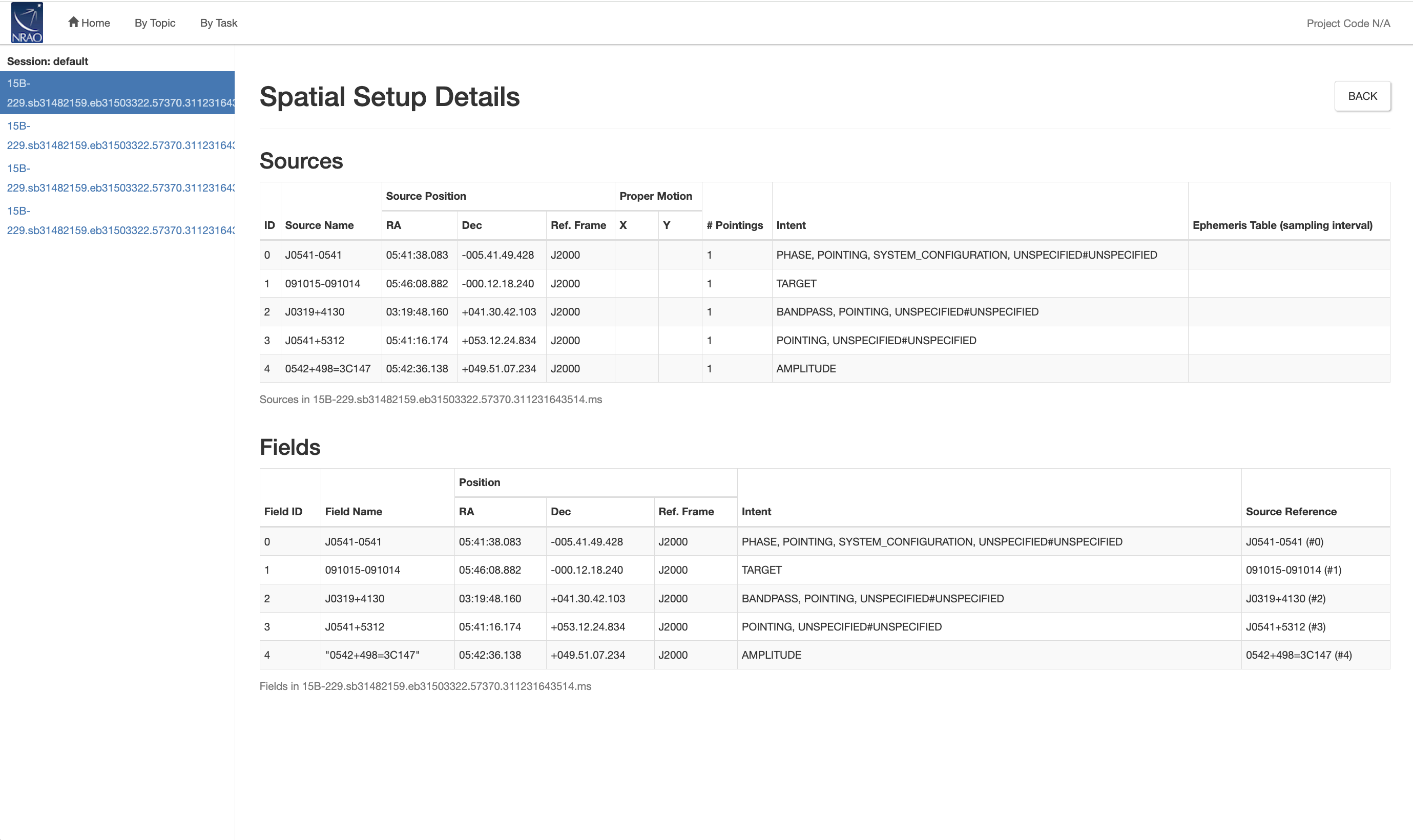 |
The Antenna Setup (Fig. O-3) page lists the locations of all antennas (antenna pad name and offset from array center) and contains graphical location plots for the array configuration (one linear and one logarithmically scaled for better separation of close antenna labels). A third plot shows a representative uv-coverage. On a second tab, baseline lengths are listed and the 'percentile' column provides a rough indication of how many baselines are shorter than that in each row (Fig. O-4).
Note that antenna IDs are not the same as antenna names. Antennas IDs are assigned when the data are imported to CASA. Thus, antenna ID 1 may not be the same as antenna 'ea01'. The Antenna setup page here shows the mapping between IDs and names.
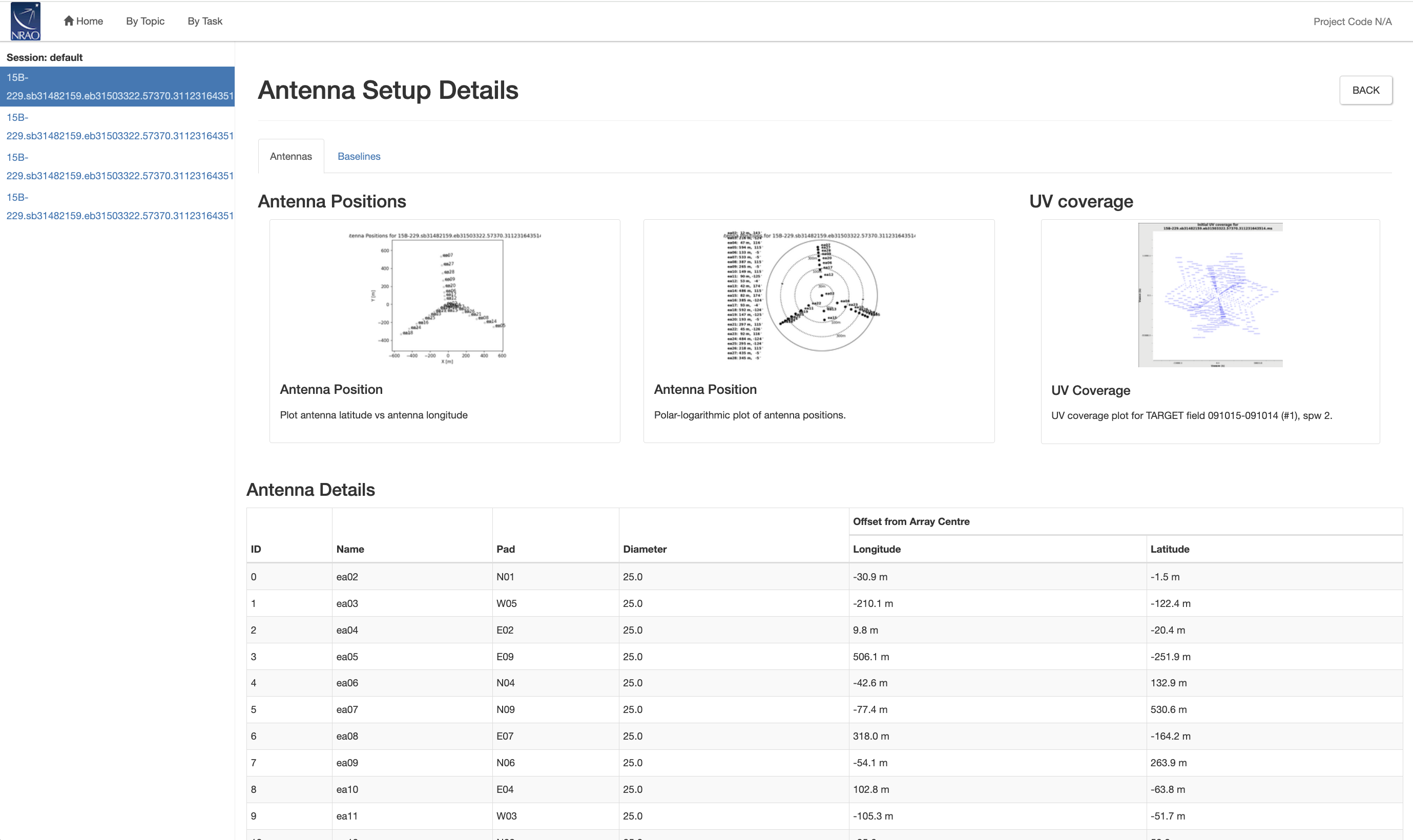 |
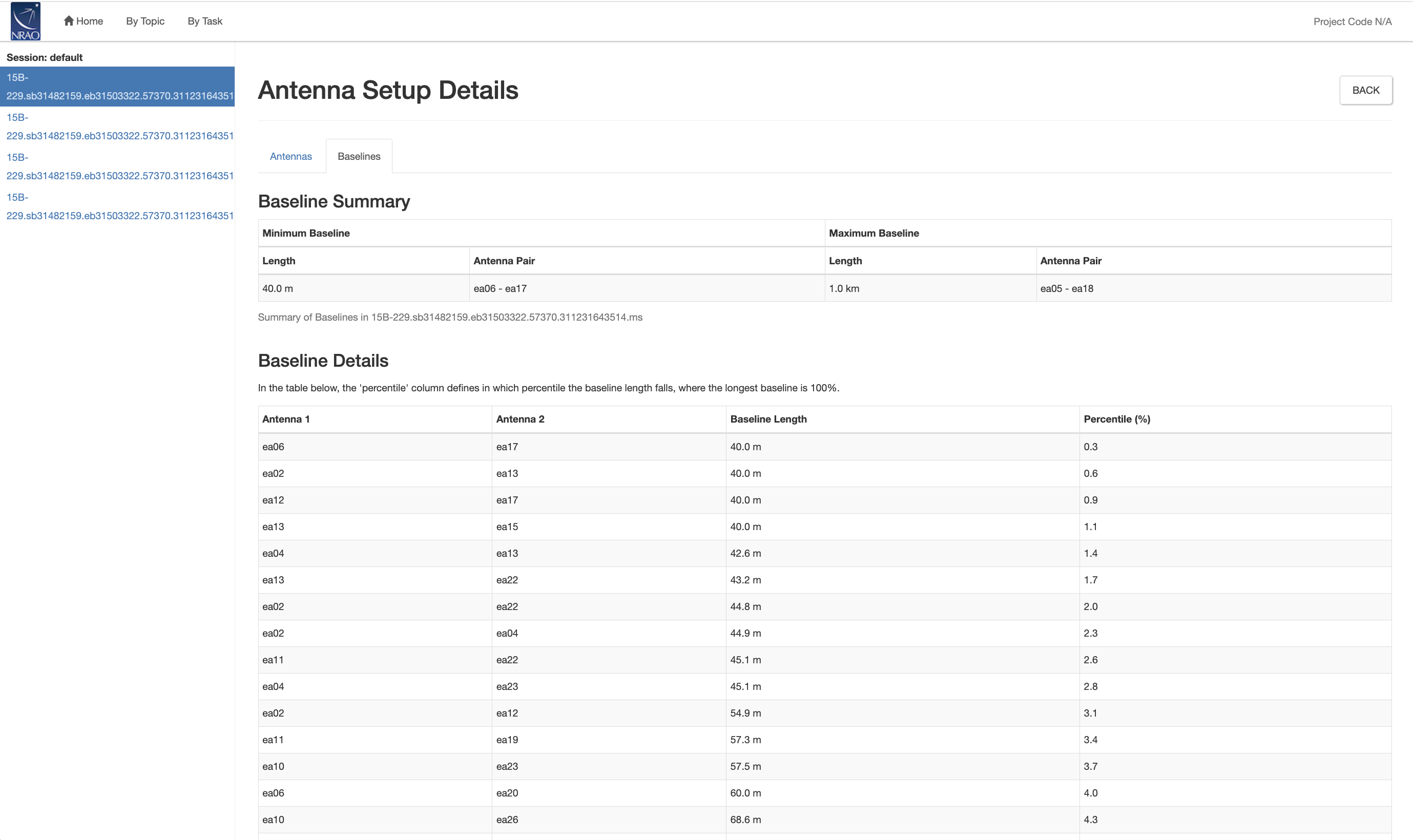 |
The Spectral Setup page (Fig. O-5) contains all spectral window descriptions, including start, center and end frequencies, the bandwidth of each spectral window (spw), as well as the number of spectral channels and their widths in frequency and velocity units. The list also includes correlator setups such as polarization products, bits, frequency band and band type, and the baseband. The 'Median Feed Receptor Angle' is only relevant for ALMA data. The type is taken from the hifv_importdata stage (see below), where the pipeline tries to identify continuum and spectral line spws, based on the bandwidth and channel number.
The real id is the spw id of each SB; the virtual id is a renumbered identifier when multiple SBs are combined (currently only an ALMA option).
Note that Science Windows contain all spws that are used for calibration. Setup and pointing scans are not part of science windows but they are available under All Windows together with their intents.
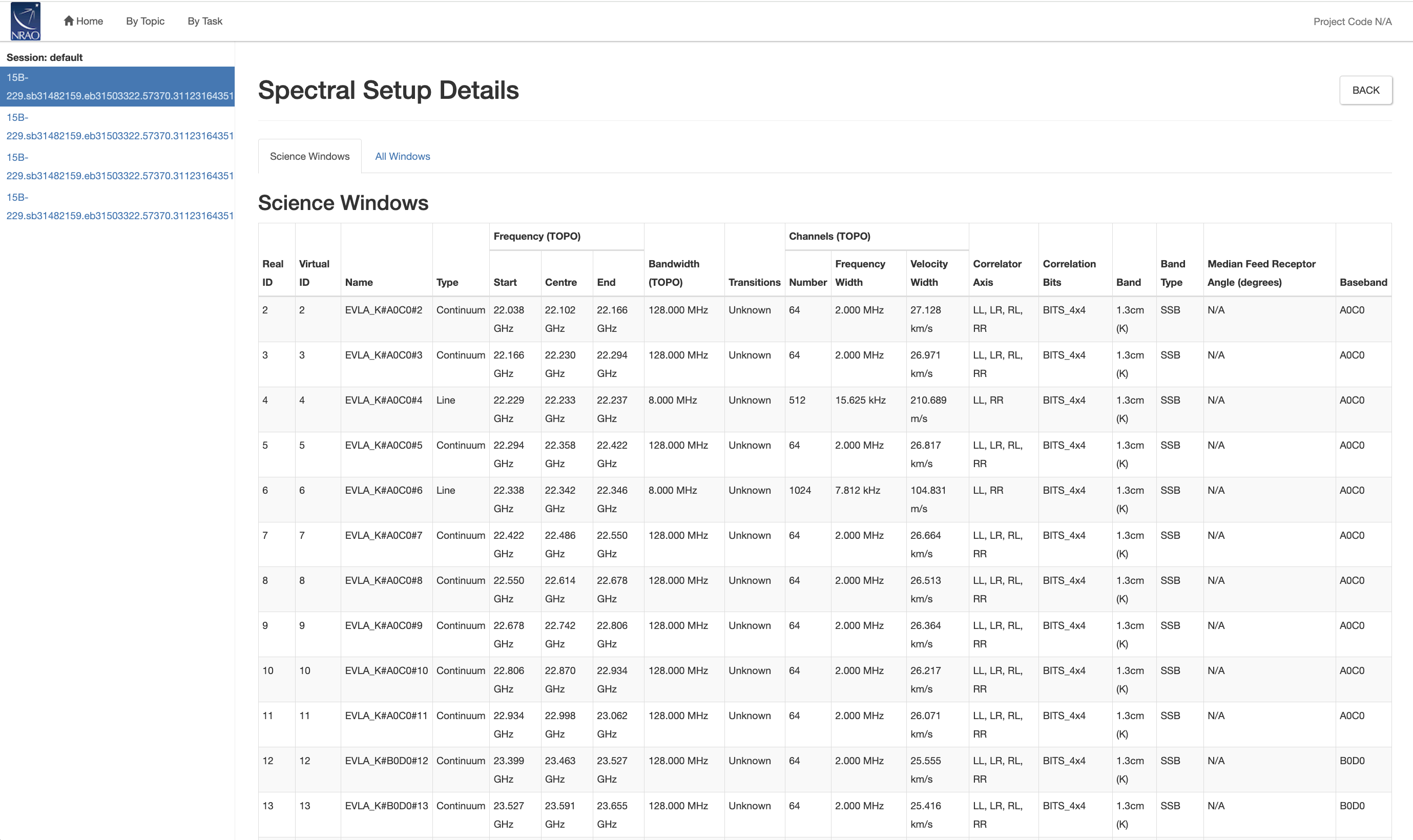 |
Clicking the Sky Setup page (Fig. O-6) leads to Elevation versus Azimuth and Elevation versus Time plots for the entire observation. The temporal plots are colorized by field id. The page also contains a representative uv-coverage and a solar elevation plot is also shown.
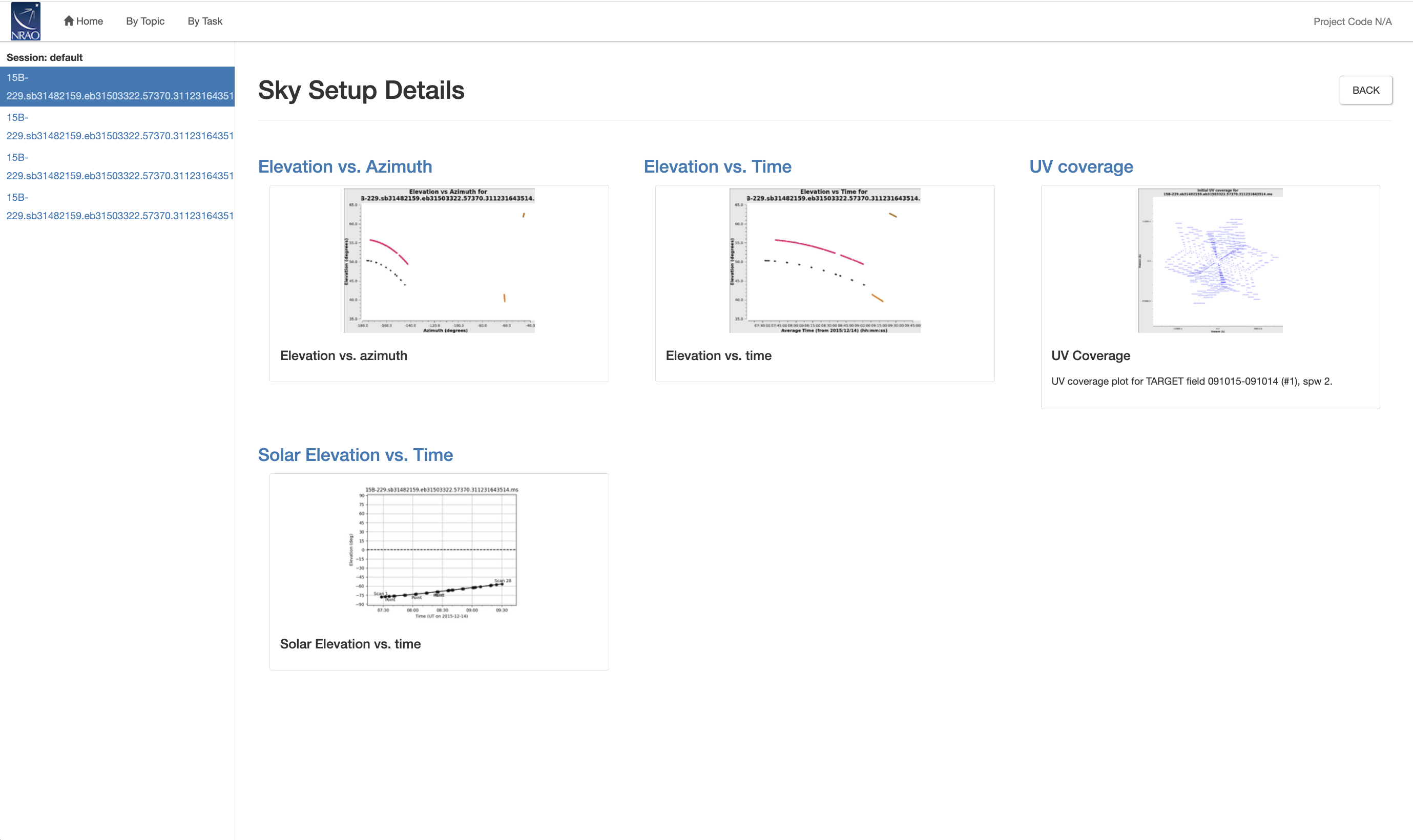 |
Scans (Fig. O-7) provides a listing of all scans, including start and stop time stamps, durations, field names and intents, and the tuning (spw) setup for each. Again Science Scans and All Scans can be inspected in separate tabs. (Note that the PI decided to lengthen the cycle time between calibrator and target beyond what we recommend at NRAO; cf. the Guide to Observing with the VLA).
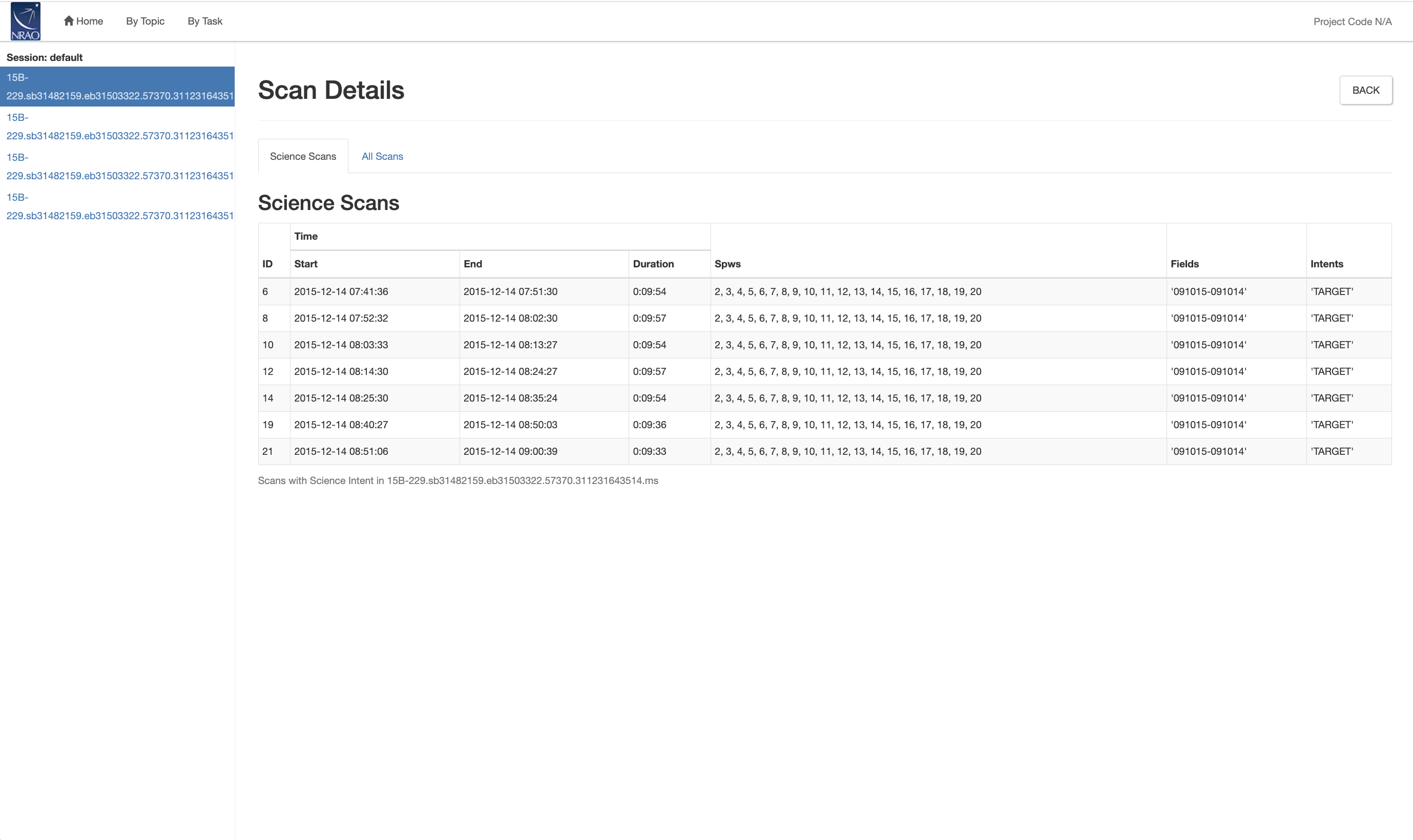 |
Most of the above information can also be accessed by the 'LISTOBS OUTPUT' button. The link leads to the output of the CASA listobs task, which summarizes the details of the observations (Fig. O-8), including the scan characteristics, with observing times, scan ids, field ids and names, associated spectral windows, integration times, and scan intents. Further down, the spectral window characteristics are provided through their ids, channel numbers, channel widths, start and central frequencies. Sources and antenna locations are also part of the listobs output (On some browsers the listobs text is best readable when opened in a new tab without line wrapping).
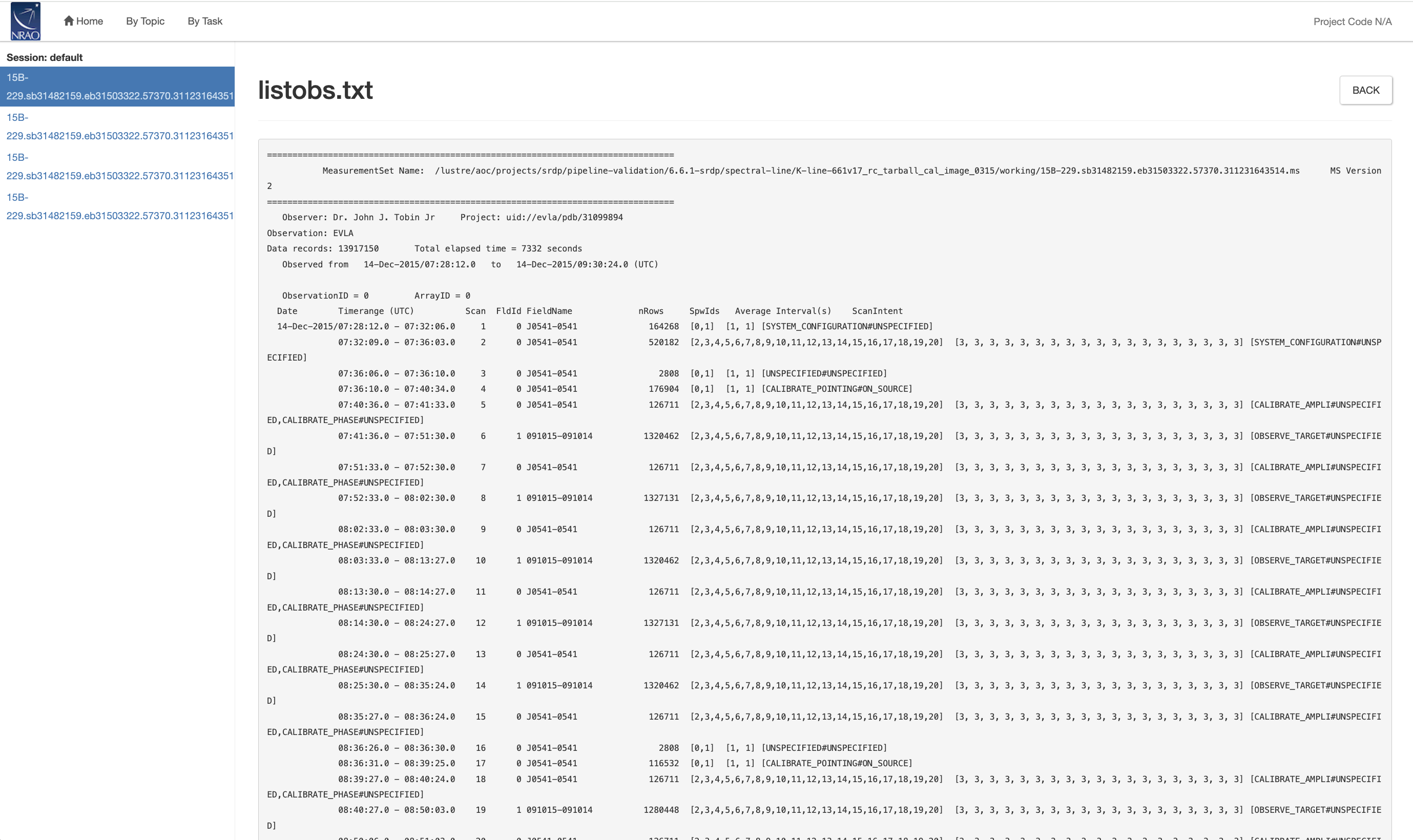 |
By Topic Screen
The top-level By Topic link leads to a page that provides basic pipeline summaries such as warnings, the four lowest QA scores (see below), and flagging summaries as functions of field, antenna, and spectral window (spw; Fig. TP-1). Links are provided to jump directly to the pipeline step that issued the warning or low score.
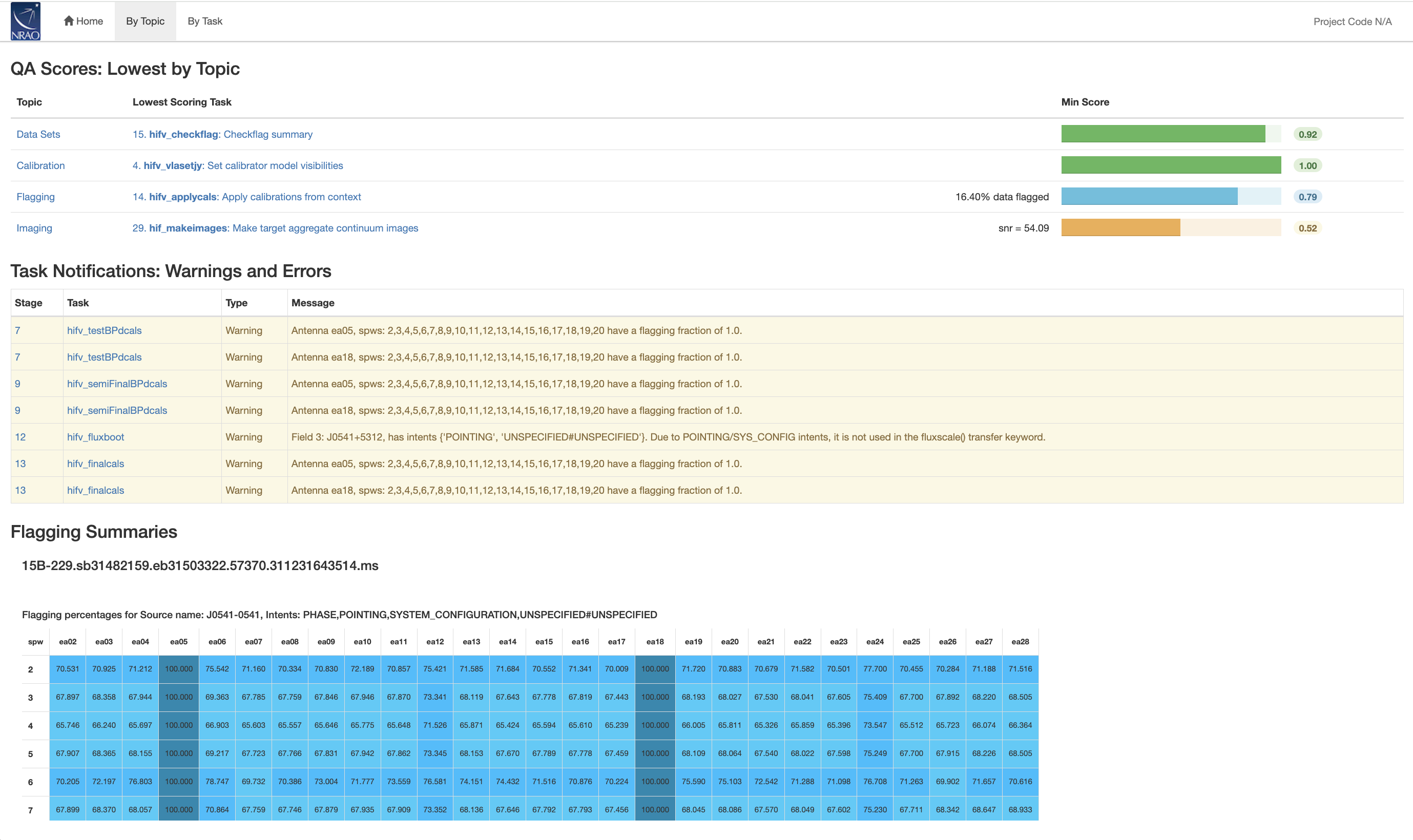
By Task Screen: The Pipeline Heuristic Stages
The calibration pipeline is divided into 41 individual pipeline heuristic stages with heuristic ('hif' or 'hifv' for heuristics interferometric [vla]) tasks listed under the By Task tab (Fig. T-1a T-1b). Each stage has an associated score for success. If there are informational messages, warnings, or errors in tasks, they are indicated by '?', '!', and 'x' icons near the task names, respectively. Note that the number of stages can vary, e.g. when excluding the hif_exportdata steps that are only required for NRAO archiving purposes.
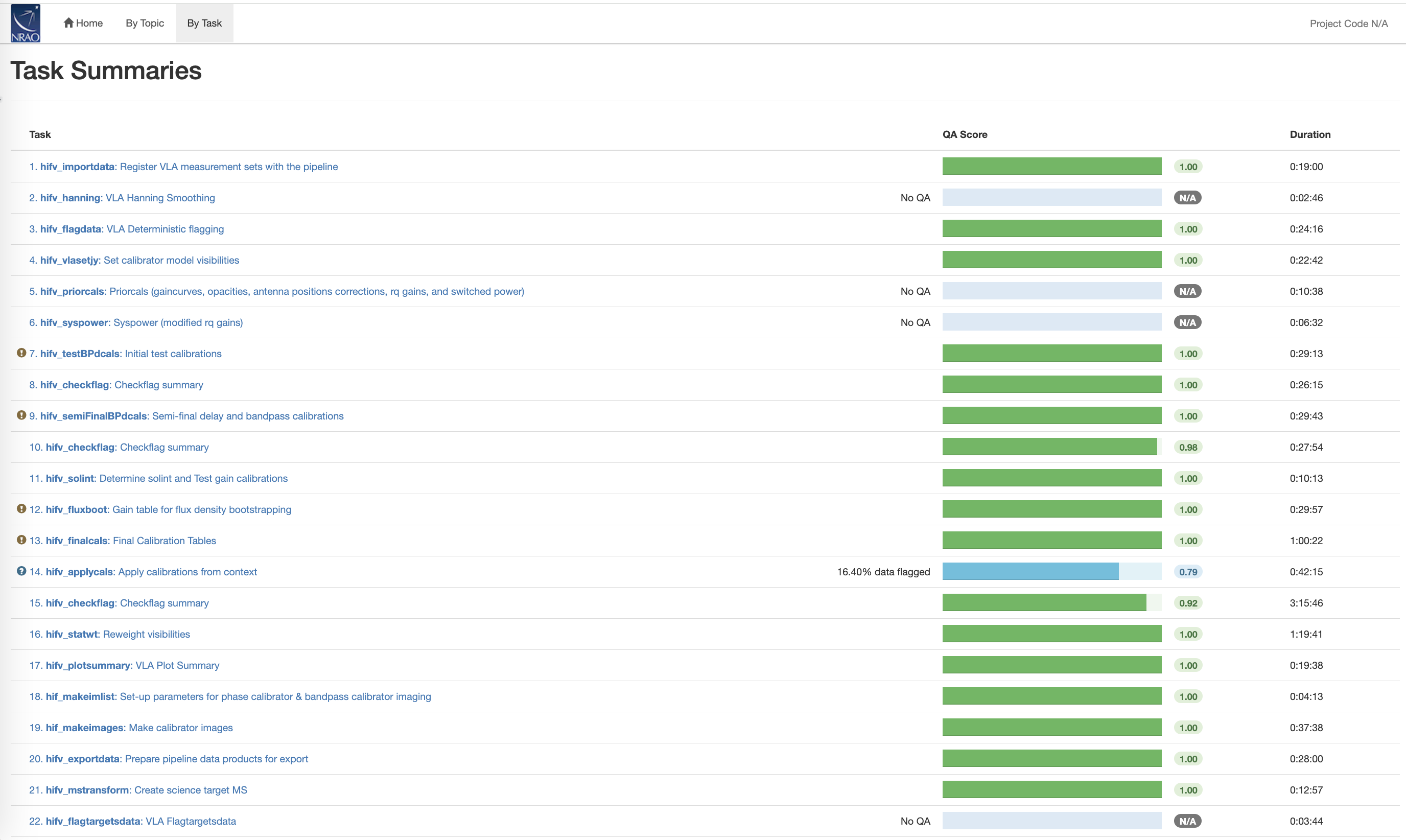 |
 |
To obtain more details on each stage, click on the individual task name. Task sub-pages contain task results such as plots or derived numbers. Common to all pages is information on the Pipeline QA ('Quality Assessment'), the heuristic task Input Parameters, Task Execution Statistics (benchmarks), and the CASA logs. Those sections provide information on the triggered heuristics, as well as the actual CASA task execution commands and their return logger messages.
The QA scores have the following meaning:
- 0.9-1.0 Standard/Good: green color - the stage appears to have completed successfully
- 0.66-0.90 Below Standard: blue color - the stage has identified some issues, but they are not likely to affect the results substantially. It is still worth a check though.
- 0.33-0.66 Warning: yellow color - there are serious issues identified in this stage. The results should be inspected carefully. Intervention may be needed.
- 0.00-0.33 Error: red color - there are severe problems with the data processing. It may or may not be possible to rescue the data.
The Individual Stages
Stage 1. hifv_importdata: Register VLA measurement sets with the pipeline
In the first stage, the raw SDM-BDF is imported into the VLA pipeline (Fig. S1-1). An MS is created and basic information on the MS is provided, such as SchedBlock ID, the number of scans and fields, science targets, and the size of the MS. The MS is also checked for suitable scan intents and a summary of the initial flags is calculated (check the "CASA logs" attached to the bottom of the page). This stage populates most of the Overview screen (see above).
hifv_importdata attempts to identify spectral line and continuum line windows. Any spw that is more narrow or has more channels than a typical continuum spw of 128MHz will be labeled as a spectral line spw. The identification is also shown on the Overview page - Spectral Setup (See also Fig. O-5). If the automated spectral line spw identification is not correct, it can be turned off and individual spws can be specified in the task hifv_importdata manually (keyword specline_spws). Details are described in the VLA Pipeline.
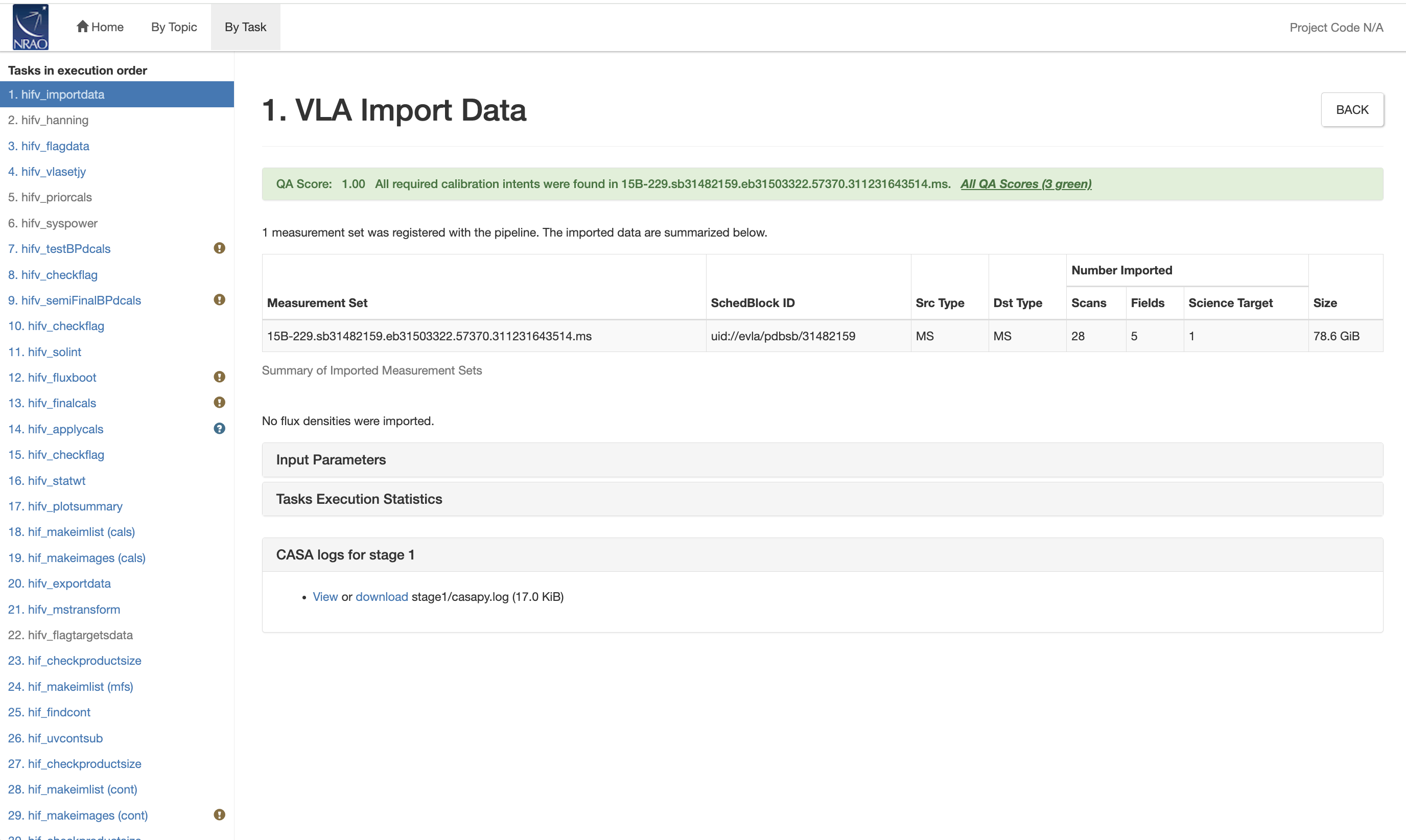 |
CHECK for: any errors in the import stage. Warnings will also be issued for missing, necessary scan intents or if the data had previously been processed. This is usually encountered when the pipeline is run on an MS rather than an SDM. Also check if the spw assignments are correct, as displayed in the Overview, or the following hifv_hanning stage. Adjustments in the ''hifv_importdata'' keyword ''specline_spws'' might be needed.
QA: If the INTENT PHASE or FLUX are missing, the score will be set to 0. An existing processing history will set it to 0.5.
Stage 2. hifv_hanning: VLA Hanning Smoothing
This stage Hanning-smooths the MS. This procedure reduces the Gibbs phenomenon (ringing) when extremely bright and narrow spectral features are present and spill over into adjacent spectral channels. Gibbs ringing is typically caused by strong RFI or a strong maser line. As part of the process, Hanning smoothing will reduce the spectral resolution by a factor of 2 while maintaining the same number of channels. (Note: this means that data in adjacent channels will no longer be independent.) The first and last edge channel will be flagged. Hanning smoothing is turned off when any spw was frequency-averaged inside the WIDAR correlator. For such data, Hanning smoothing cannot correct for the Gibbs phenomenon anymore and would only add additional smearing. Given the assignments in the hifv_importdata stage, hifv_hanning now attempts to alleviate the Gibbs effects for spws that were identified as continuum, leaving spws with spectral line emission untouched to preserve the spectral resolution for these typically weak lines. Spectra line spws at known maser frequencies, however, will trigger Hanning smoothing as the Gibbs phenomenon can be extreme (the keyword maser_detection in hifv_hanning can be used to override this behavior; for details, see the VLA Pipeline page). Fig. S2-1 shows an example.
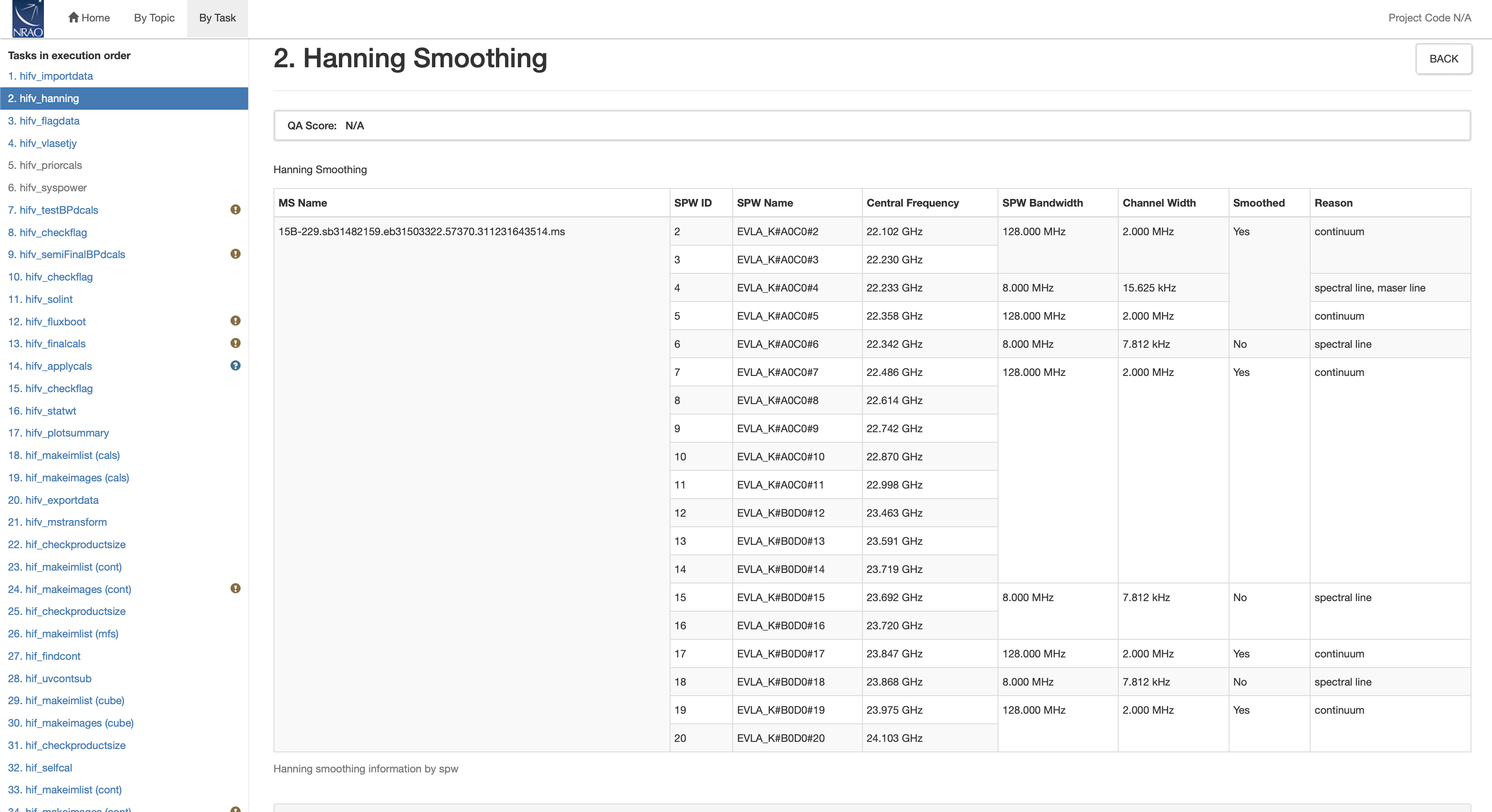 |
CHECK for: Make sure the spws that are supposed to be processed (typically continuum and maser line spws) are receiving Hanning smoothing and those that should not (typically thermal line spws) do not.
QA: N/A
Stage 3. hifv_flagdata: VLA Deterministic flagging
This stage applies flags that were generated by the VLA online system during the observations. The flags include antennas not on source (ANOS), shadowed antennas, scans with intents that are of no use for the pipeline (such as pointing and setup scans), autocorrelations, the first and last 1% edge channels of each spectral window (with a minimum of 1 channel), clipping absolute zero values that the correlator occasionally produces, quacking (i.e. flagging start or end integrations of scans; the pipeline will flag the first integration after a field change), and flagging the end 20MHz of the top and bottom spw of each baseband (when the baseband is <1GHz, the baseband flagging will be disabled). "Agent Commands" is the actual list of flagging commands that is sent to the CASA task flagdata (Fig. S3-1). The flags are reported as a fraction of the total data for the full dataset as well as broken up into the individual calibrator scans and target data (according to their intents). A plot is provided that displays the online antenna flags as a function of time (Fig. S3-2).
A flagging template can also be provided to the pipeline which applies user defined flags to the data (see The VLA Pipeline Webpage). These templates are created by a user before starting the pipeline. They are also prepared by NRAO staff for improved quality when needed.
In our example (Fig. S3-1), the target sources start with 0.906% flagged data that are due to Hanning smoothing, which flags the first and last channel of each spw (2 out of 64 channels in our case). The deterministic flagging stage adds various ANOS, baseband, and other flags (e.g. subreflector rotation, like the error in ea18 as plotted in Fig. S3-2) for a total 1.432% on the target. No flagging template was applied.
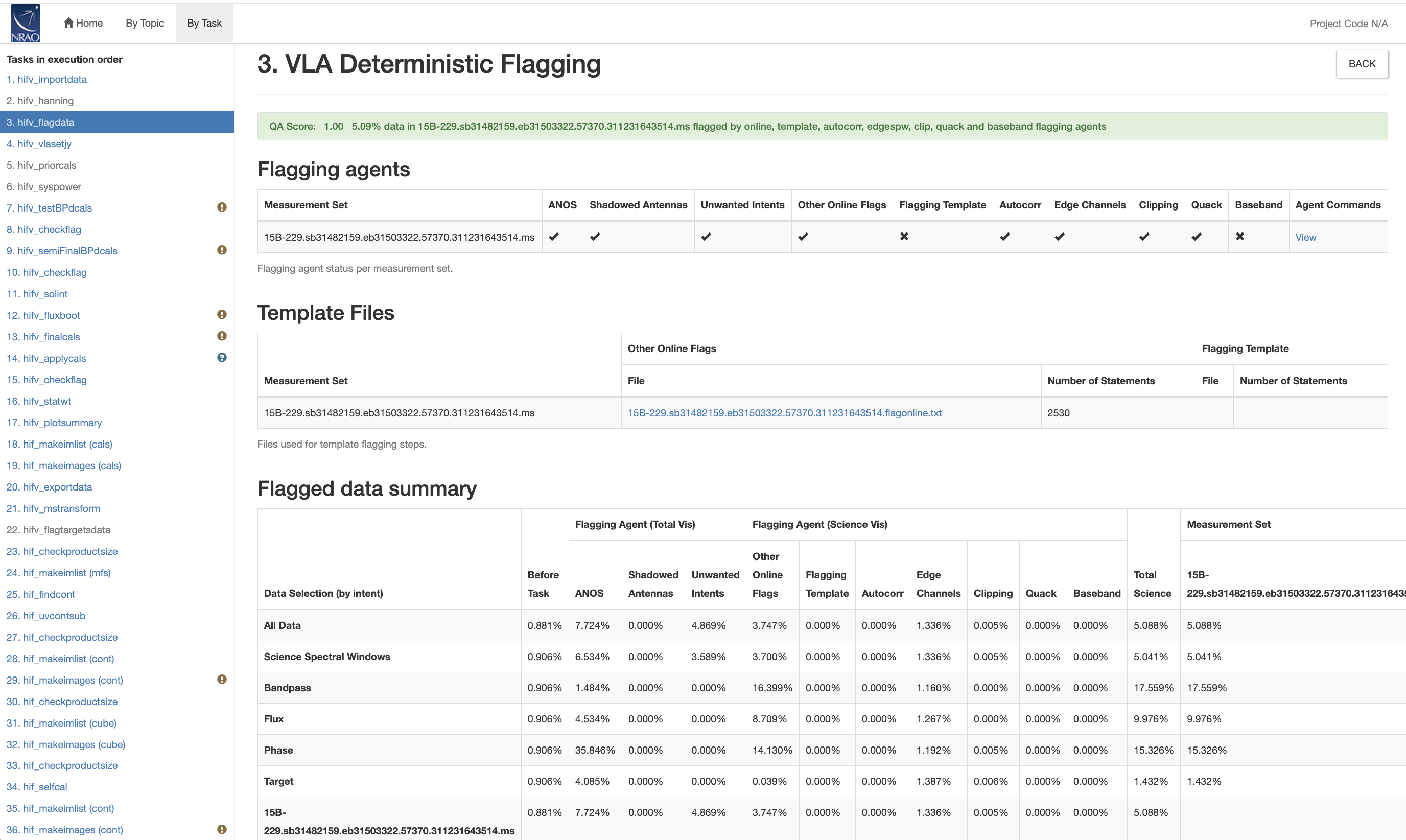 |
The graphical overview of the system online flags, i.e. ANOS, Focus and Subreflector errors (typically adjustments between scans), Fig. S3-2, shows that a subreflector error took out the bandpass and flux calibrators on ea18, and a focus error took out the calibrators on ea05. Both antennas are therefore unusable for the following calibration. Those flags are also shown in stages 7 and 9, that determine the bandpass calibrations.
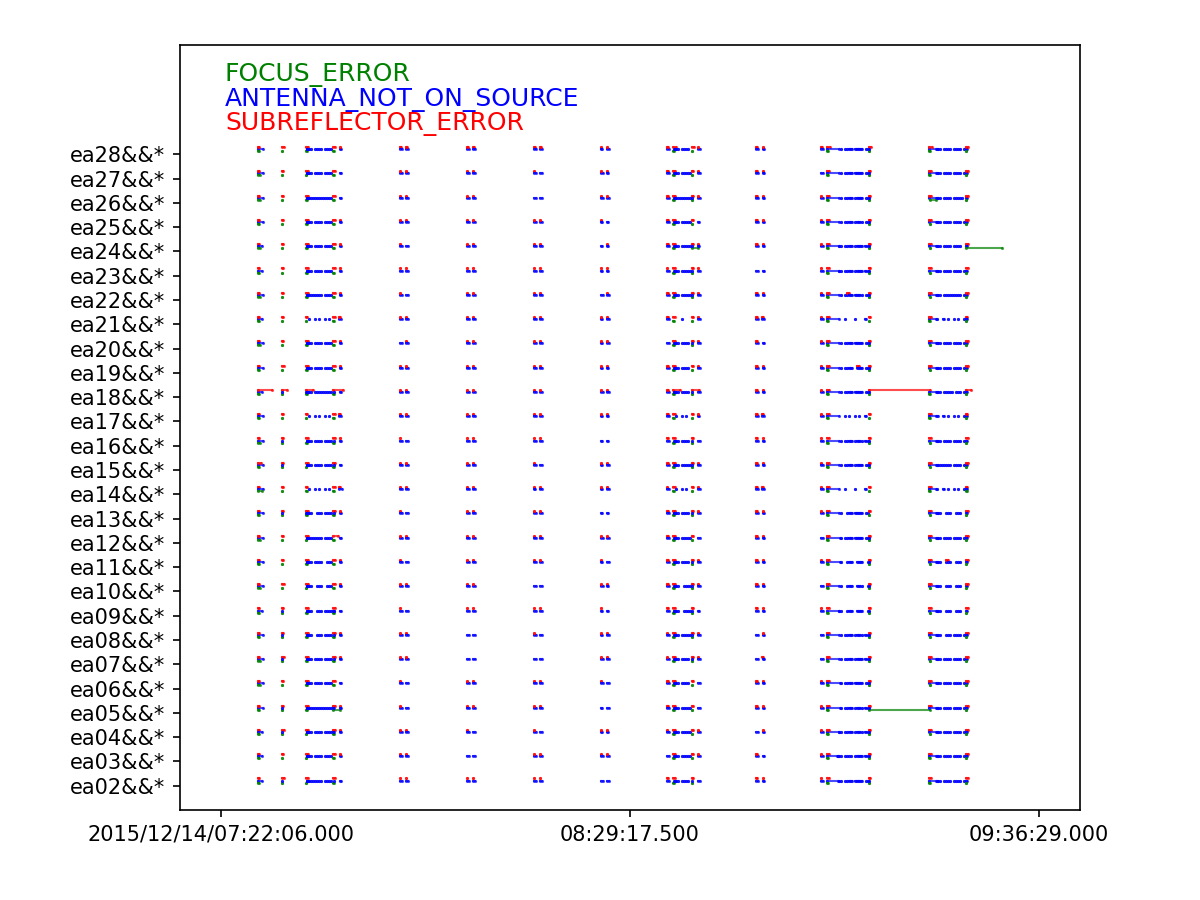 |
CHECK for: the percentage of the flags. If a very large portion (or even all) of the visibilities of the calibrators are flagged, try to identify the reason. Also have a quick look at the graph of the online flags to understand whether the system behaved normally or if there was an unusually high failure of some kind.
QA: Determined by the percentage of incremental flagging where 0 < score < 1 is the score range for 60% < fraction flagged data < 5%.
Stage 4. hifv_vlasetjy: Set calibrator model visibilities
Stage number 4 calculates and sets the calibrator spectral and spatial model for the standard VLA flux density calibrators (3C48, 3C138, 3C147, or 3C286 with a CALIBRATE_FLUX scan intent). The task page (Fig. S4-1) lists the calculated flux densities for each spw. It also contains plots of the amplitude versus uv-distance for the models per spw that are calculated and used to specify the flux density calibrator characteristics (Fig. S4-2). Our example uses 3C147, and for this array configuration and band the source has a clear substructure given the shape of the uv-distance amplitudes. This is what the models are correcting for. The spectral index is visible through the colored spws that are at different flux density levels.
If the scan intent CALIBRATE_FLUX is absent the pipeline will not run. If the calibrator is not a standard VLA flux density calibrator, the absolute flux density scale calibration will be on an arbitrary level.
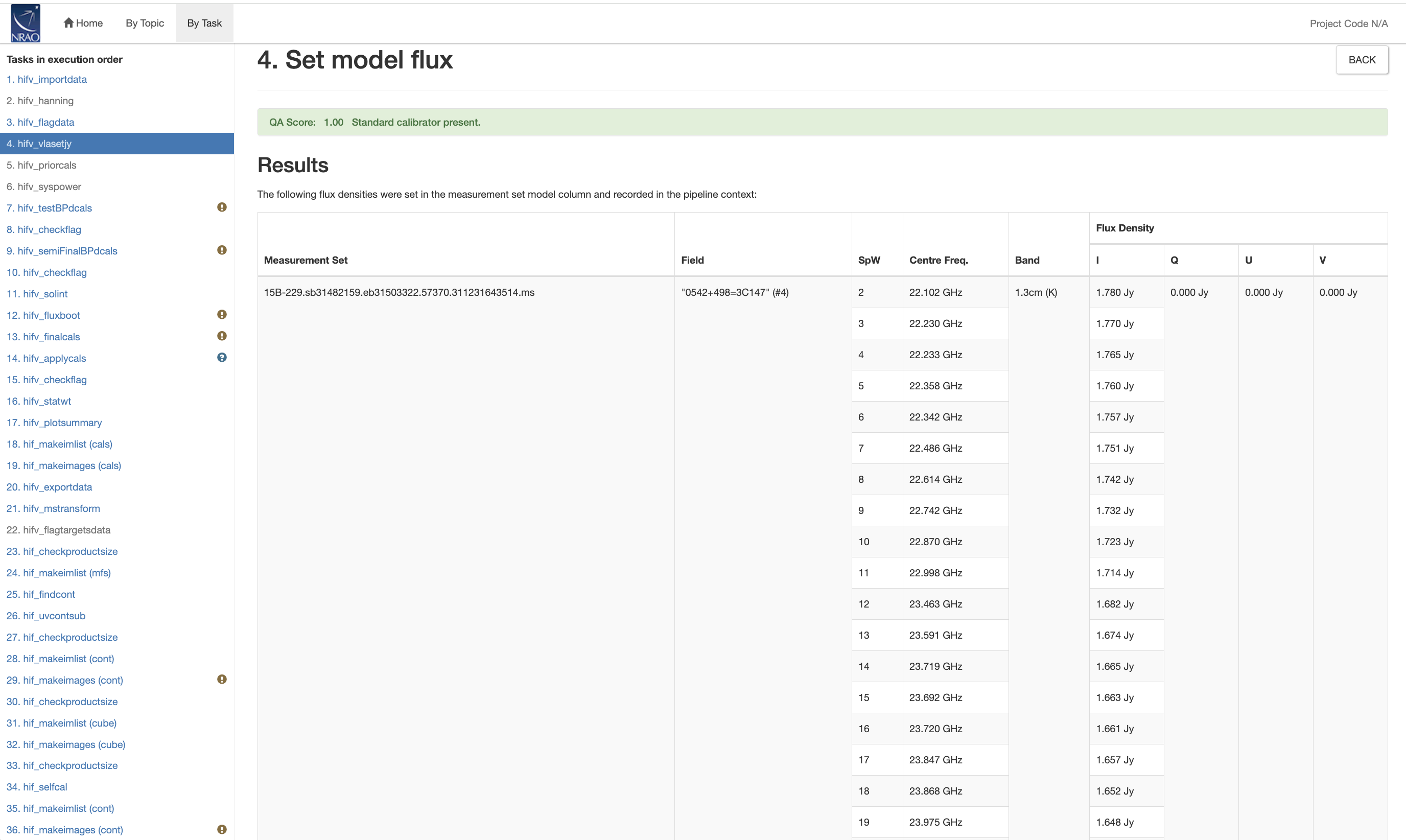 |
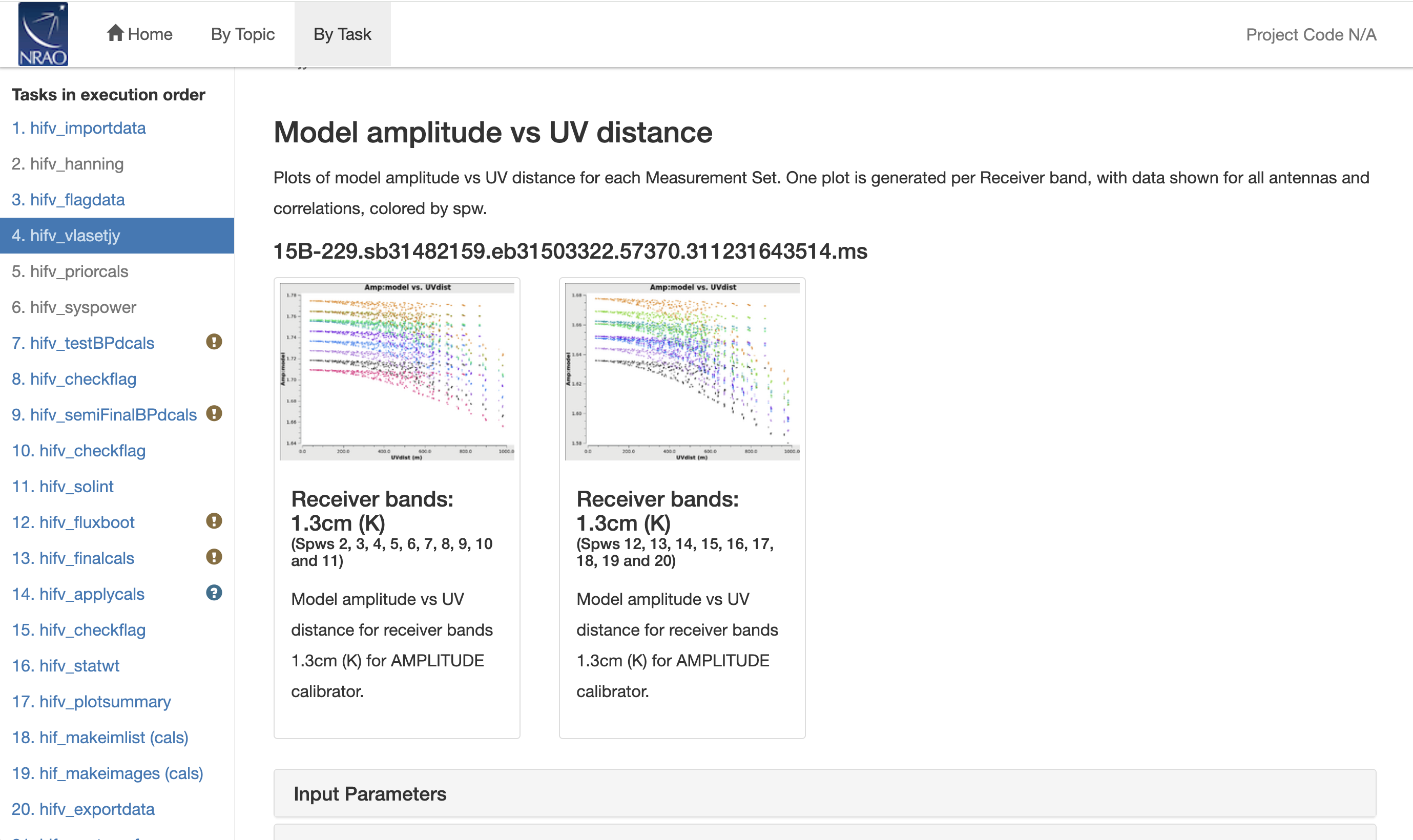 |
CHECK for: Any unexpected flux densities or model shapes.
QA: If the flux calibrator is not one of the VLA flux standards (3C48, 3C138, 3C147, 3C286), the score will be 0.5.
Stage 5. hifv_priorcals: Priorcals (gaincurves, opacities, antenna positions corrections and rq gains)
Next, the prior calibration tables are derived. They include gain-elevation dependencies, atmospheric opacity corrections, antenna offset corrections, and requantizer (rq) gains. They are independent of the calibrator observations themselves and can be derived from ancillary data such as antenna offset tables, weather data, antenna elevation, and Total Electron Content (TEC) plots. Switched power measurements are provided but currently not used in the pipeline (see also next stage).
Opacities are calculated per spw and plotted together with additional information on the weather conditions during the observation (Fig. S5-1a). For K-band (and above) they are significant, in particular around the water line near 22.2 GHz.
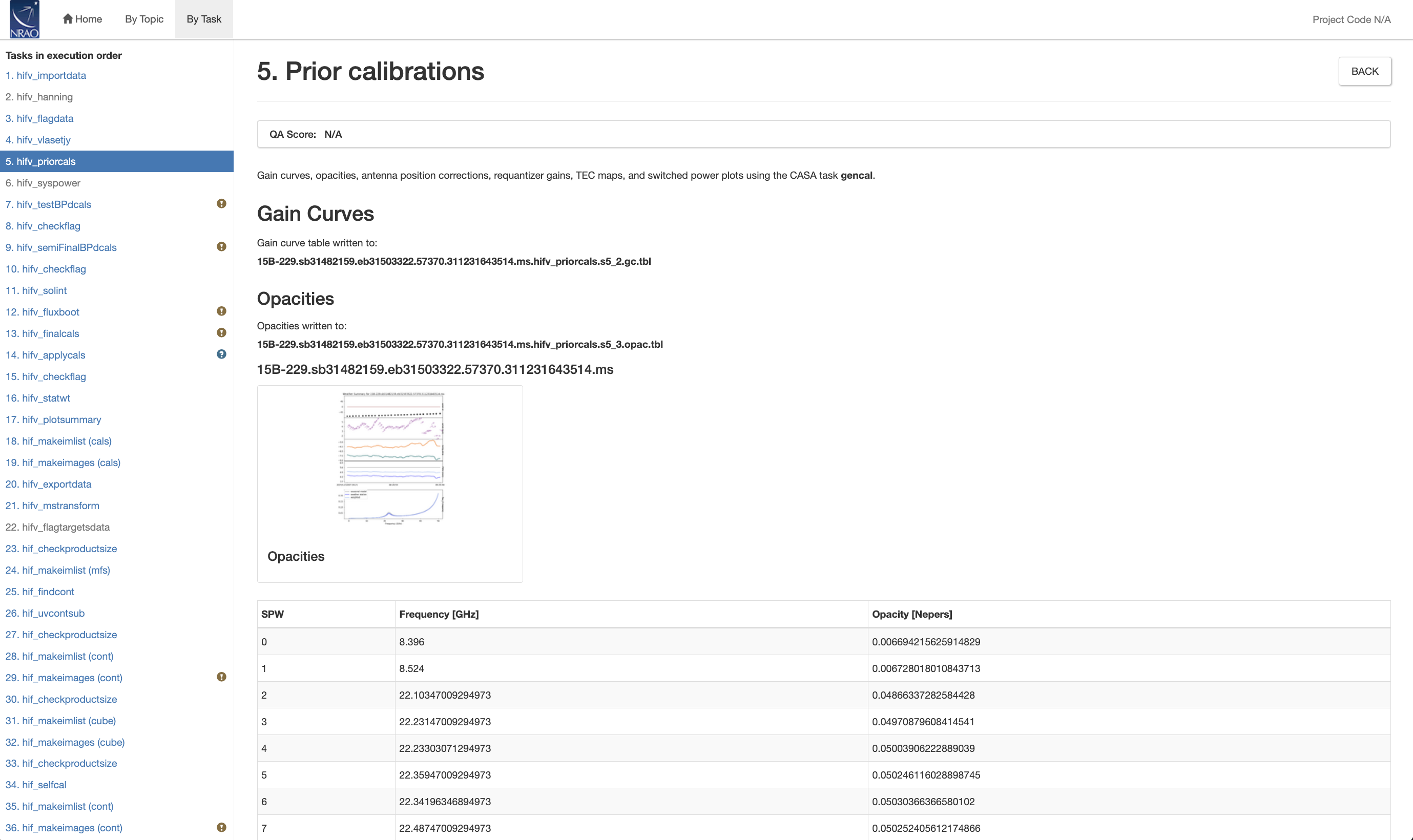 |
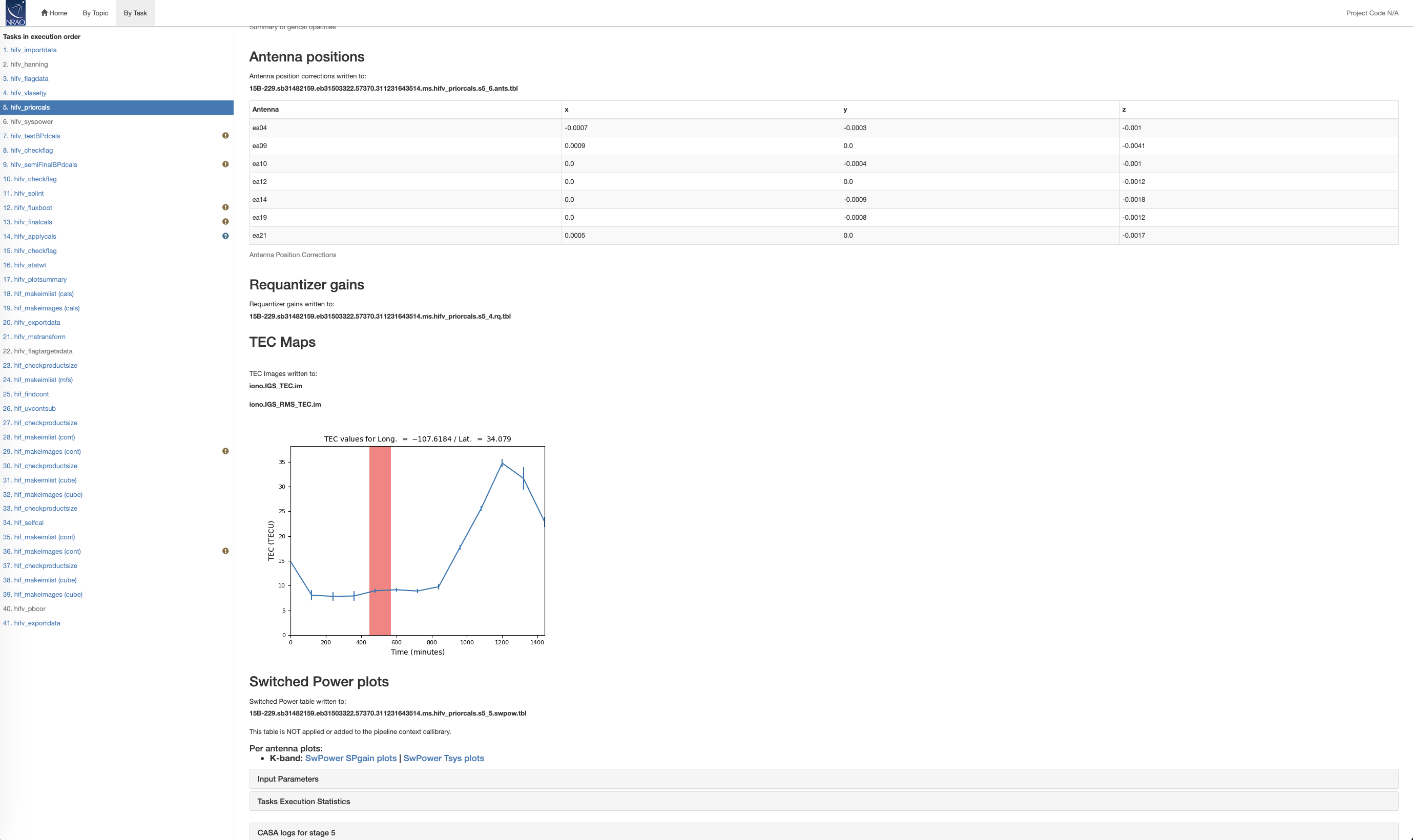 |
The antenna positions are usually updated within a few days after an antenna was repositioned during the cycle (Fig. S5-1b). For our case, 7 antennas have updated small positional corrections that will be taken into account at this step of the calibration.
The TEC of the ionosphere will cause some phase scatter in the observations for lower frequency data. This can be corrected for when the TEC is known, e.g. via the NASA service that monitors this quantity via GPS. This service, however, is only available some time after the observation has occurred. If available, the TEC is displayed as shown in Fig. S5-1b. The TEC corrections, however, are not applied by default, but if desired, they can be applied to the data in this stage by the following call in the casa_pipescript.py script:
hifv_priorcals(apply_tec_correction=True)
Finally, the page also shows switch power plots, which is the response of each antenna to repeated noise injections (switched power). This can be used to calibrate the system, to estimate the system temperature, and to evaluate non-linearities due to strong RFI. More detail can be found in the following stage 6 hifv_syspower.
CHECK for: extreme or unrealistic opacities. Also check that the antenna offsets are within a reasonable range (reasonable values are usually less than +/- 0.0200 meters). There should only be updates for a few antennas.
QA: N/A; but a warning will be issued when more than 50% of antennas need position corrections, or when the weather station data are absent for observations at K-band frequencies and above.
Stage 6. hifv_syspower: Syspower (modified rq gains)
The switched power at the telescope is a good way to see if the data suffer from compression, ie. non-linearity of the receivers in the presence of strong RFI. The main page shows an overview of the switched power values Pdiff (measured power with injected noise - power without injected noise) in various representations (cf. Fig. S6-1). Outliers in the first and dropouts in the last plot may indicate compression. The subpages show the switched power and Pdiff values per antenna and polarization for each antenna (Fig. S6-2 and S6-3).
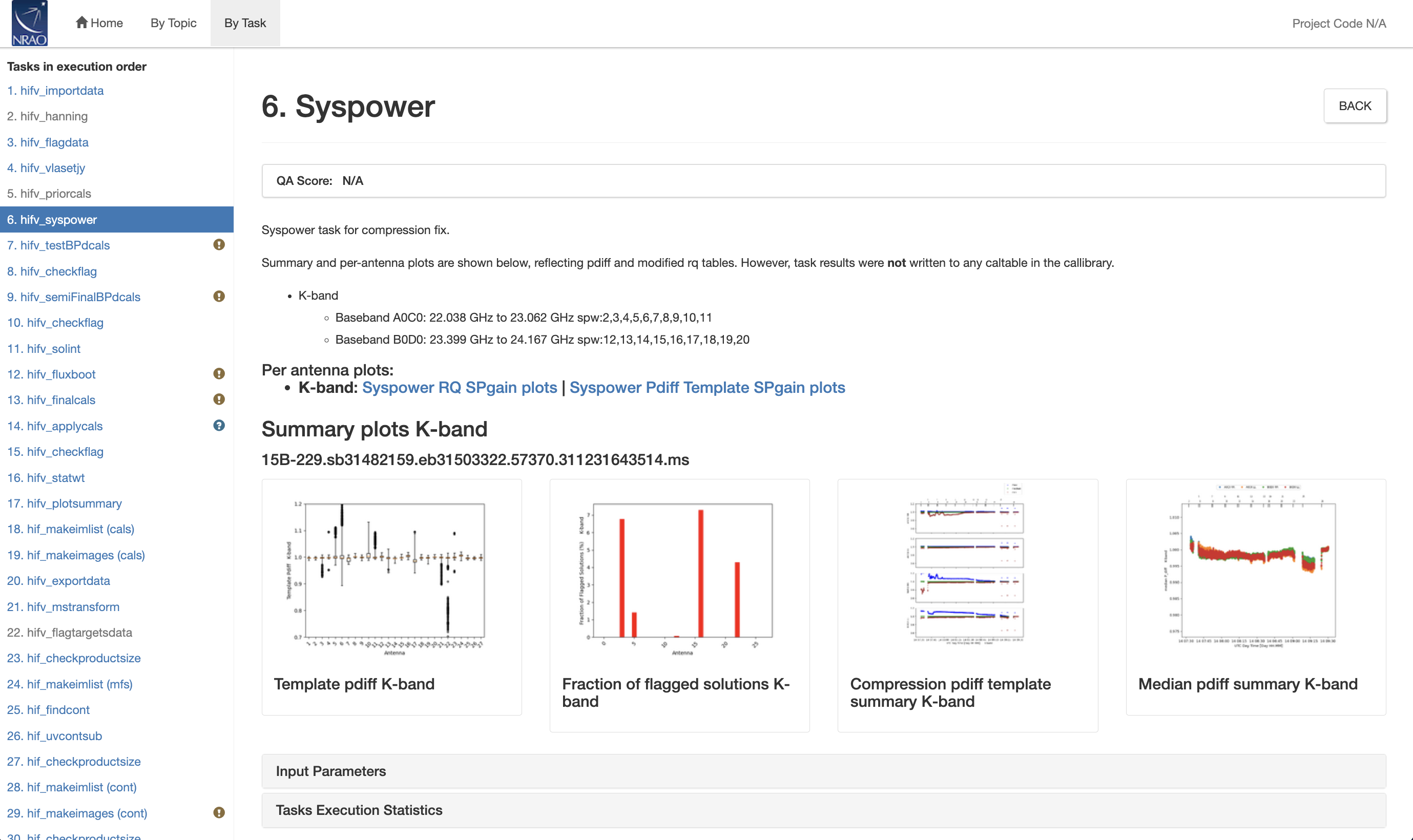 |
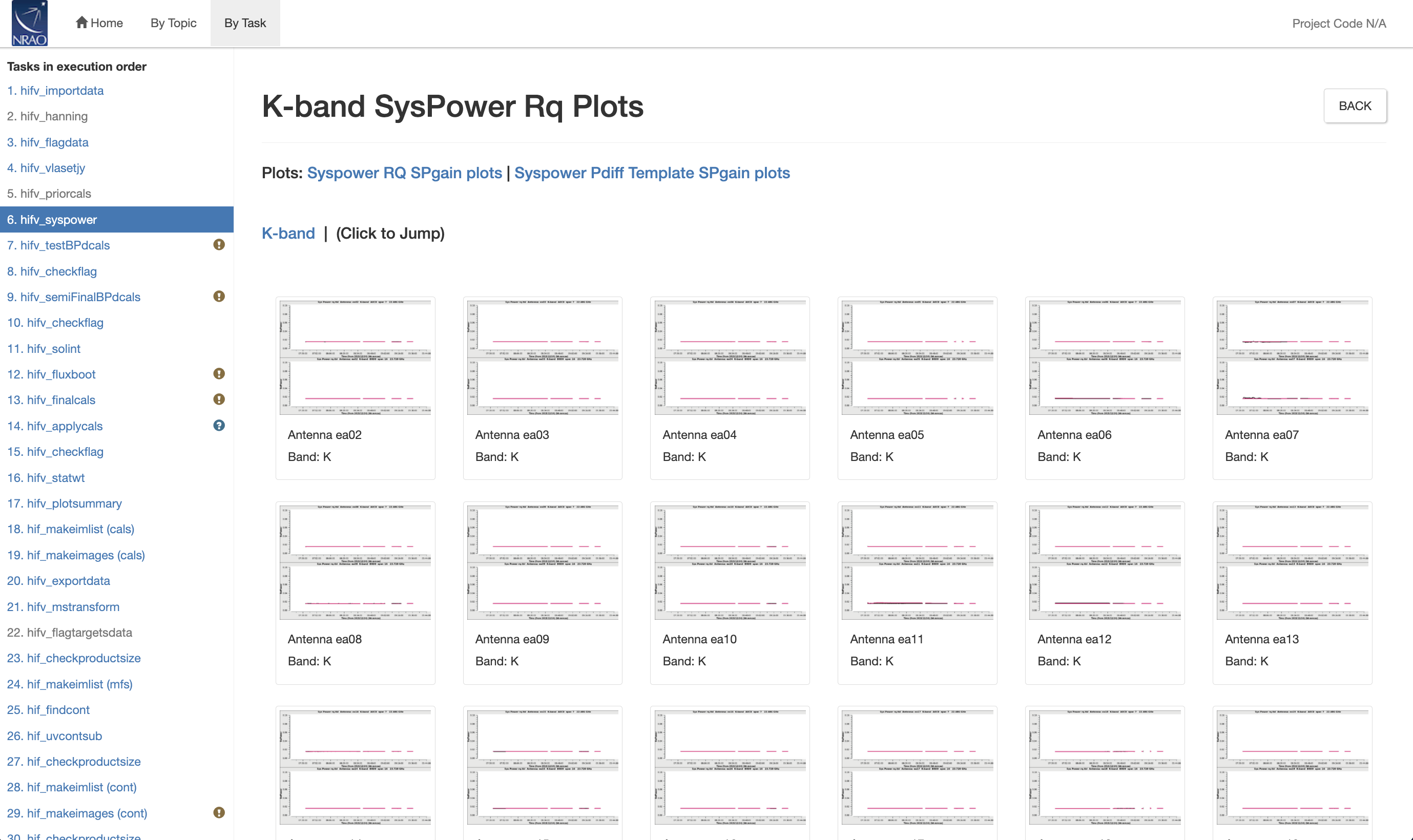 |
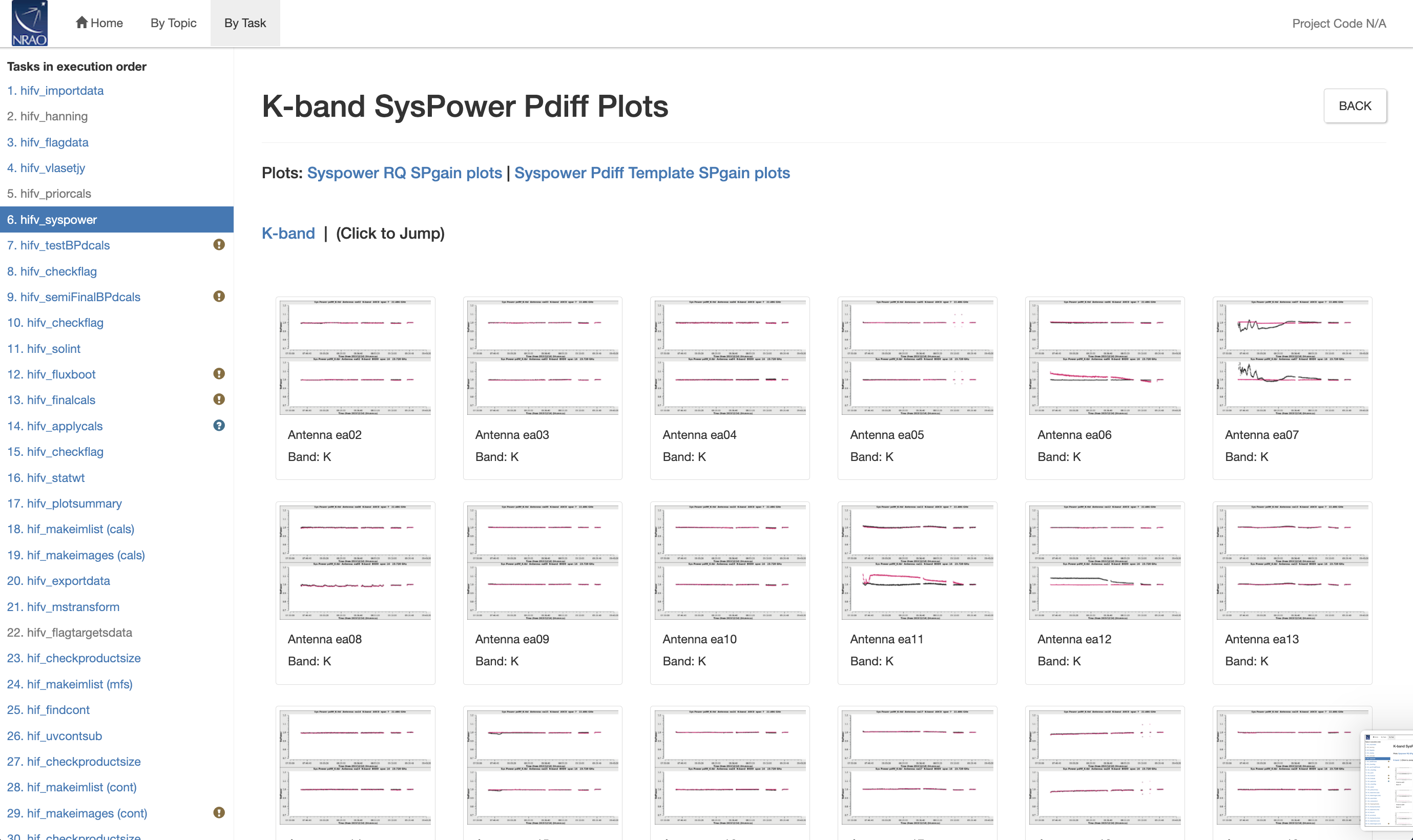 |
For weak non-linearities in the 8bit samplers, the pipeline can apply a correction via the call
hifv_syspower(apply=True)
in casa_pipescript.py (for more detailed options, see the VLA Pipeline page). The correction is performed for power differences (Pdiffs) that are between 0.7 and 1.2 by default, values outside those ranges will have their values (and subsequently data) flagged. Expanding the range of Pdiffs corrected is not expected to result in a more accurate correction. By default the pipeline does not apply compression correction and this page is only informative. The algorithm cannot provide a reliable fix for 3bit data and should only be invoked for 8bit sampled data. In addition, NRAO does not recommend to apply syspower corrections to K-band and higher frequency data.
CHECK for: outliers and dropouts in the plots. If compression is observed, a correction can be applied to the data.
QA: N/A
Stage 7. hifv_testBPdcals: Initial test calibrations
Now it is time to determine the delays and the bandpass solutions (gain and phase) for the first time (based on the bandpass calibrator). Applying the initial solution will make it easier to identify RFI that needs to be flagged. There will be a couple of similar iterations for the calibration tables in the following pipeline stages to eventually obtain the final set of calibration tables.
The plot on the main page (Fig. S7-1a/b) shows the bandpass calibrator with the initial bandpass solutions applied. In the main plot, the spectral line spws can be identified as their noise per-channel is typically larger. For visualization purposes, those spectral line spws are also displayed below on their own, different scaling. At the top, there are links to other plots showing delay, gain amplitude, gain phase, bandpass amplitude, and bandpass phase solutions for each antenna. Note that the pipeline will typically switch reference antennas (based on flagging percentage and location within the array), and therefore phase solutions of reference antennas may not be perfectly zero and may show some steps. When delays are more than +/-50ns it will be worth examining the data more closely. Some additional flagging may be needed.
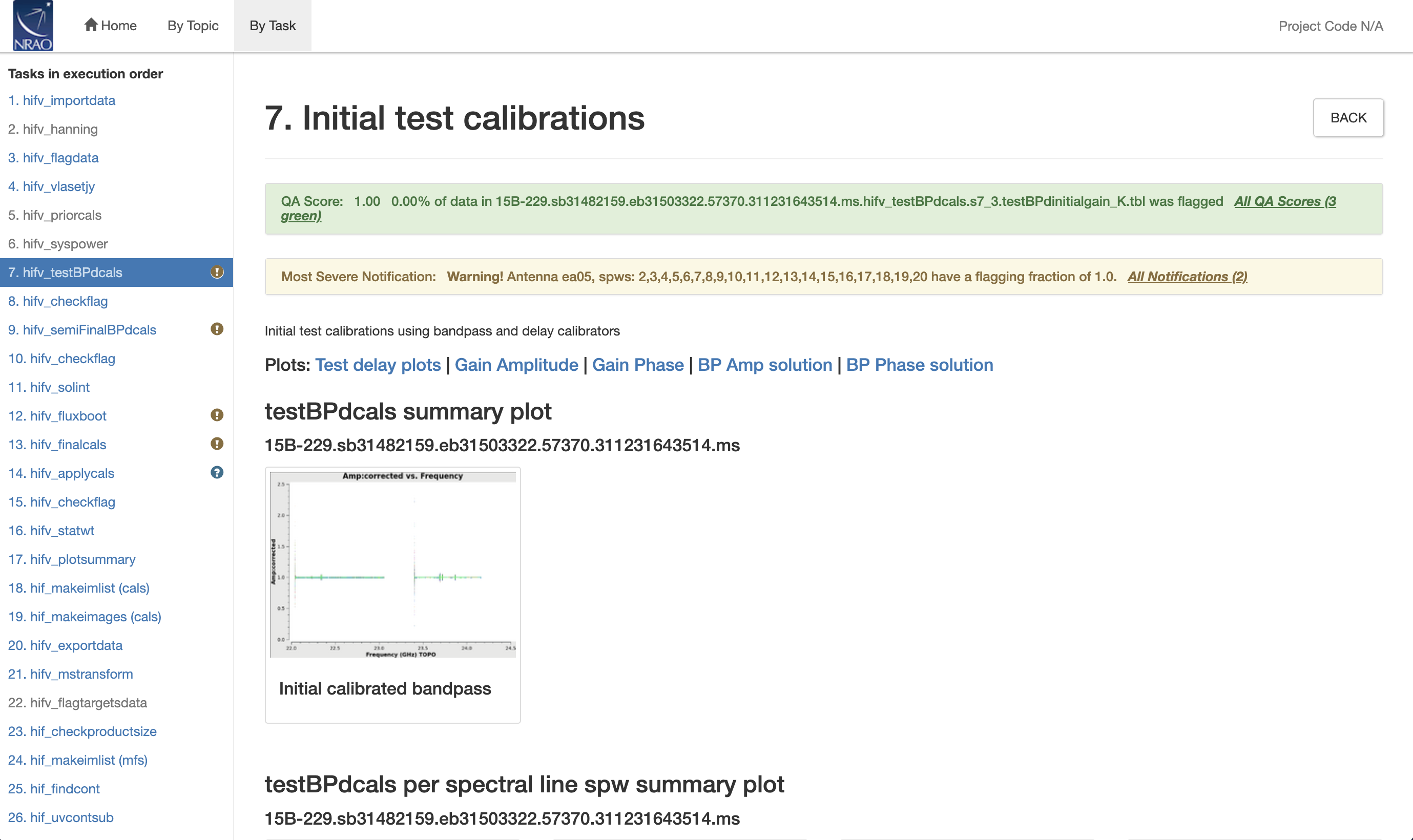 |
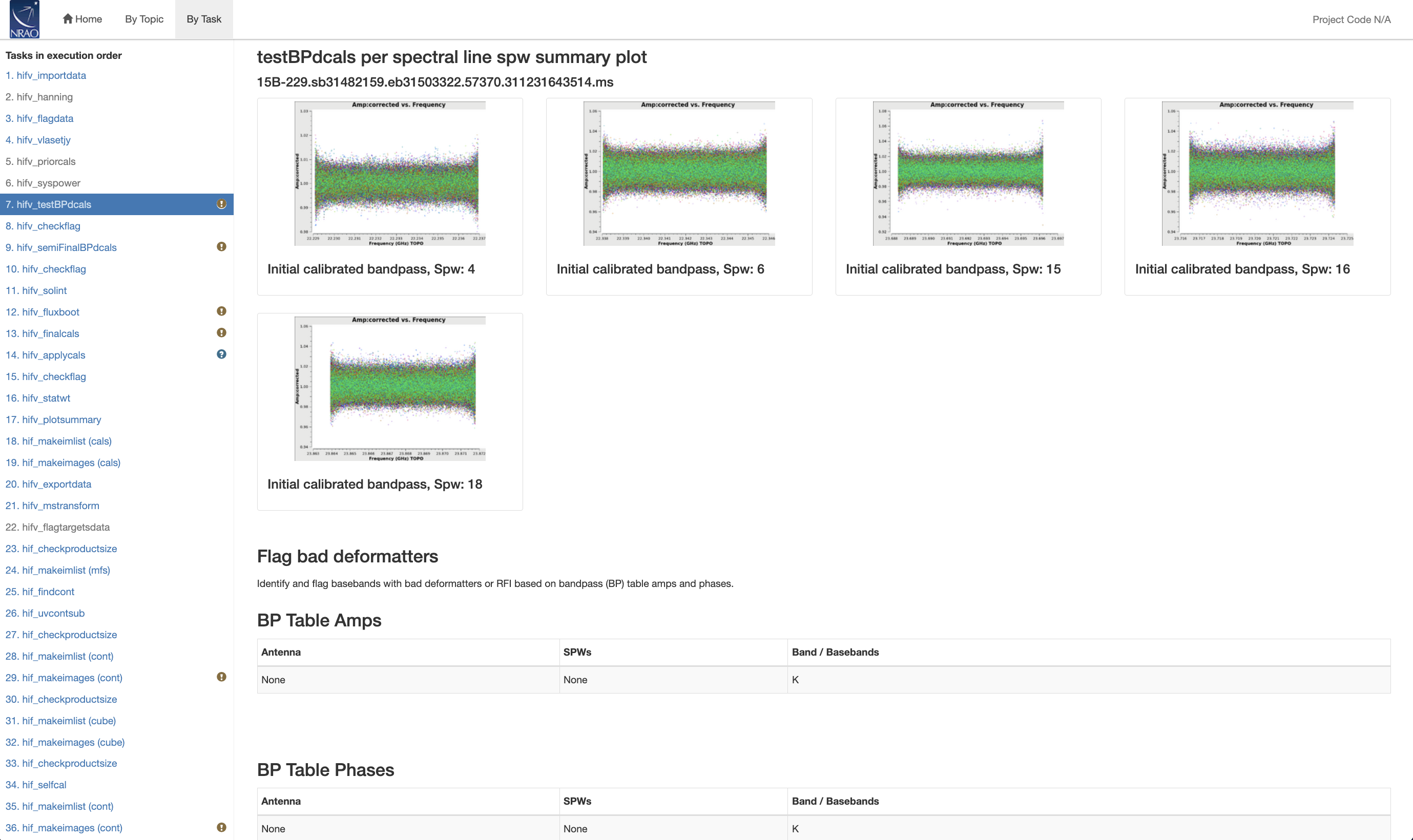 |
The gain amplitude and phase solutions are derived per integration and they are used to correct for decorrelation before any spectral bandpass solutions are calculated (note that later stages do not show this plot anymore). The latter are determined over a full solution interval, usually for all bandpass scans together. Bandpasses should be smooth although they can vary substantially over wide frequency bands. The bandpass (BP) phase solutions are derived after systematic slopes were accounted for by the delay solutions.
Let's have a look at the errors. On the screen, they can be expanded (Fig. S7-2) and we see that the QA score is 1.0, with some flagging fractions and the largest delays noted. ea05 and ea18, however, were already flagged in the hifv_flagdata stage, hence the '!' in the task list.
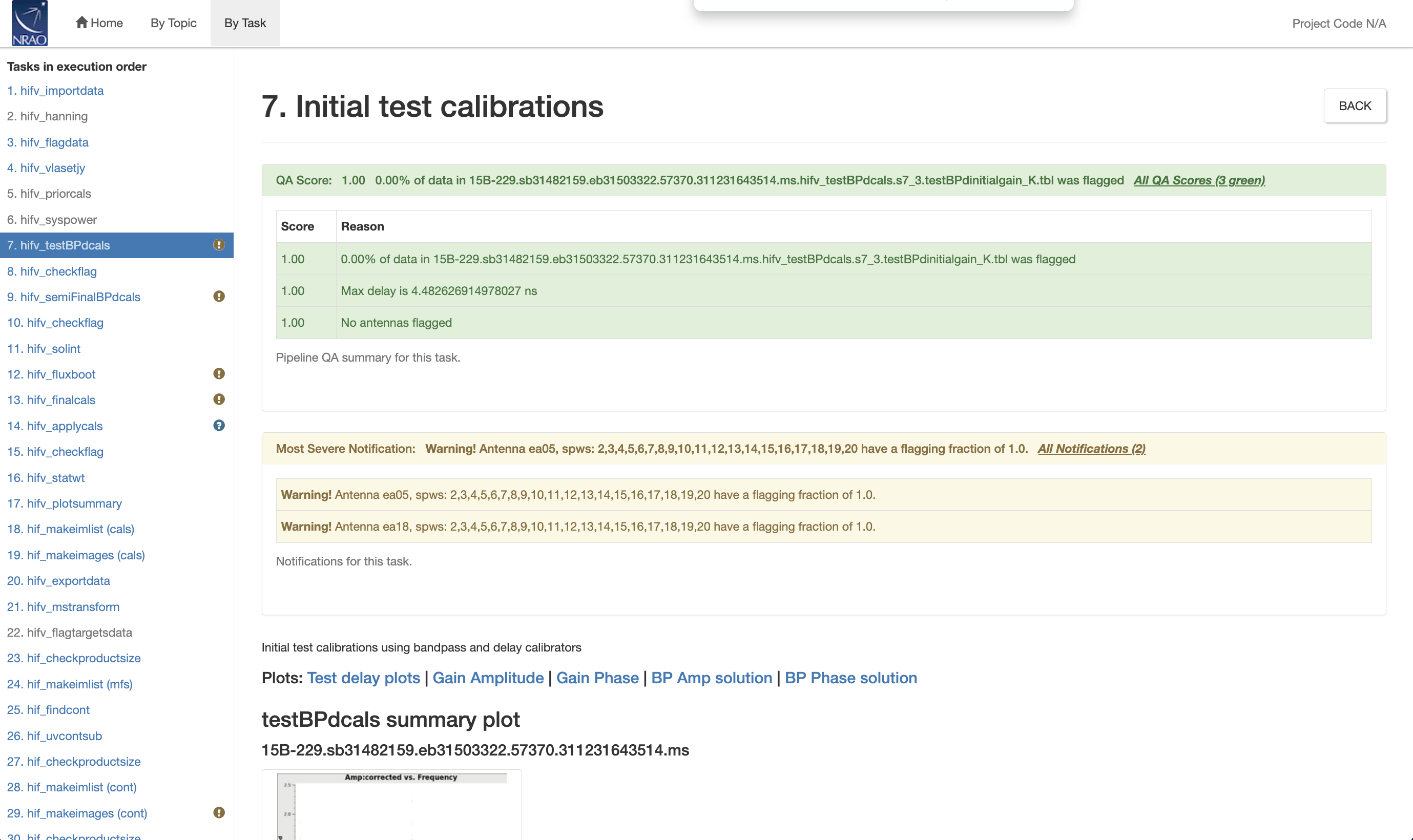 |
The subplots for delay, gain amplitude (as a function of time), gain phase, bandpass (BP) amplitude (as a function of frequency), and BP phase are shown in Figs. S7-3 to S7-7.
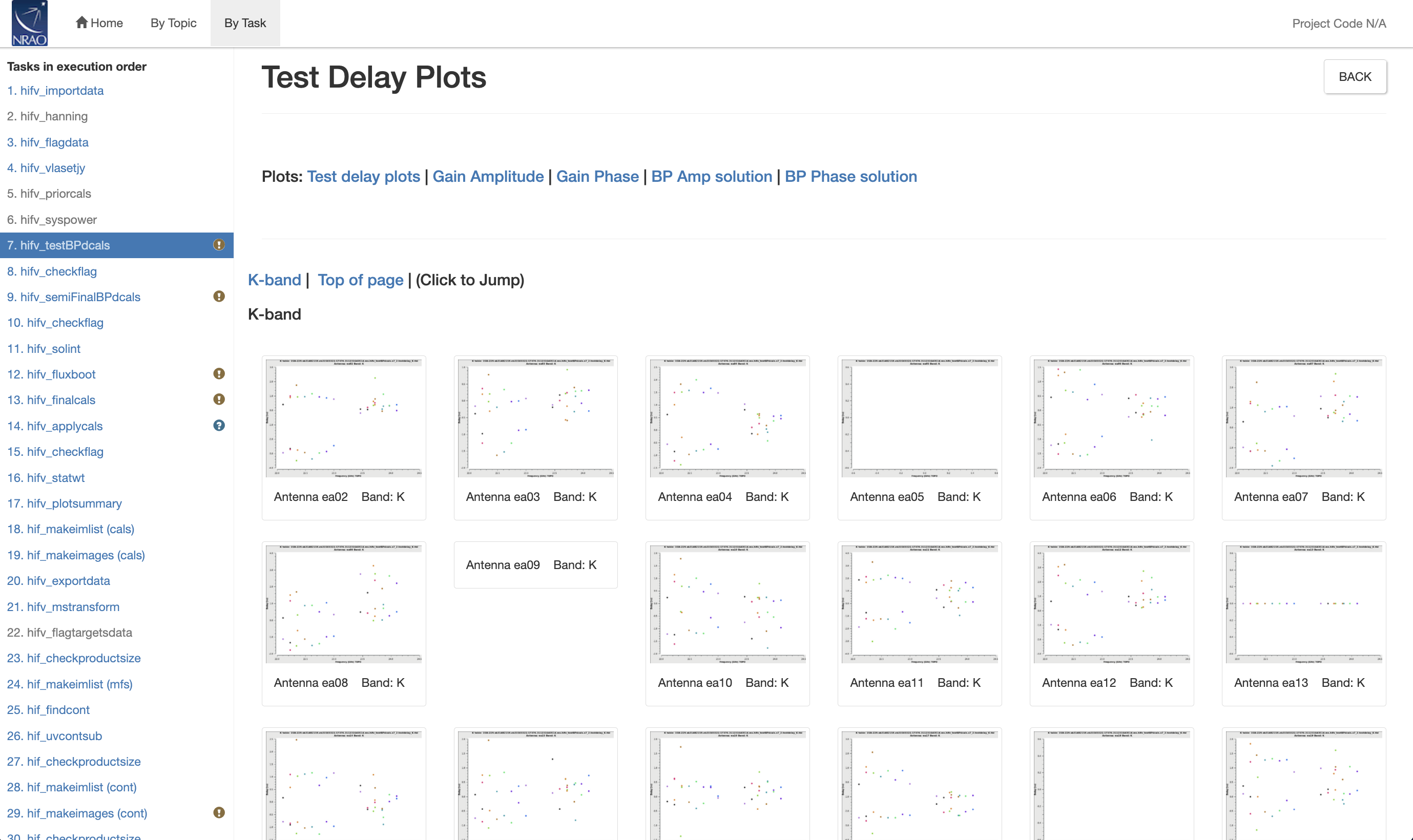 |
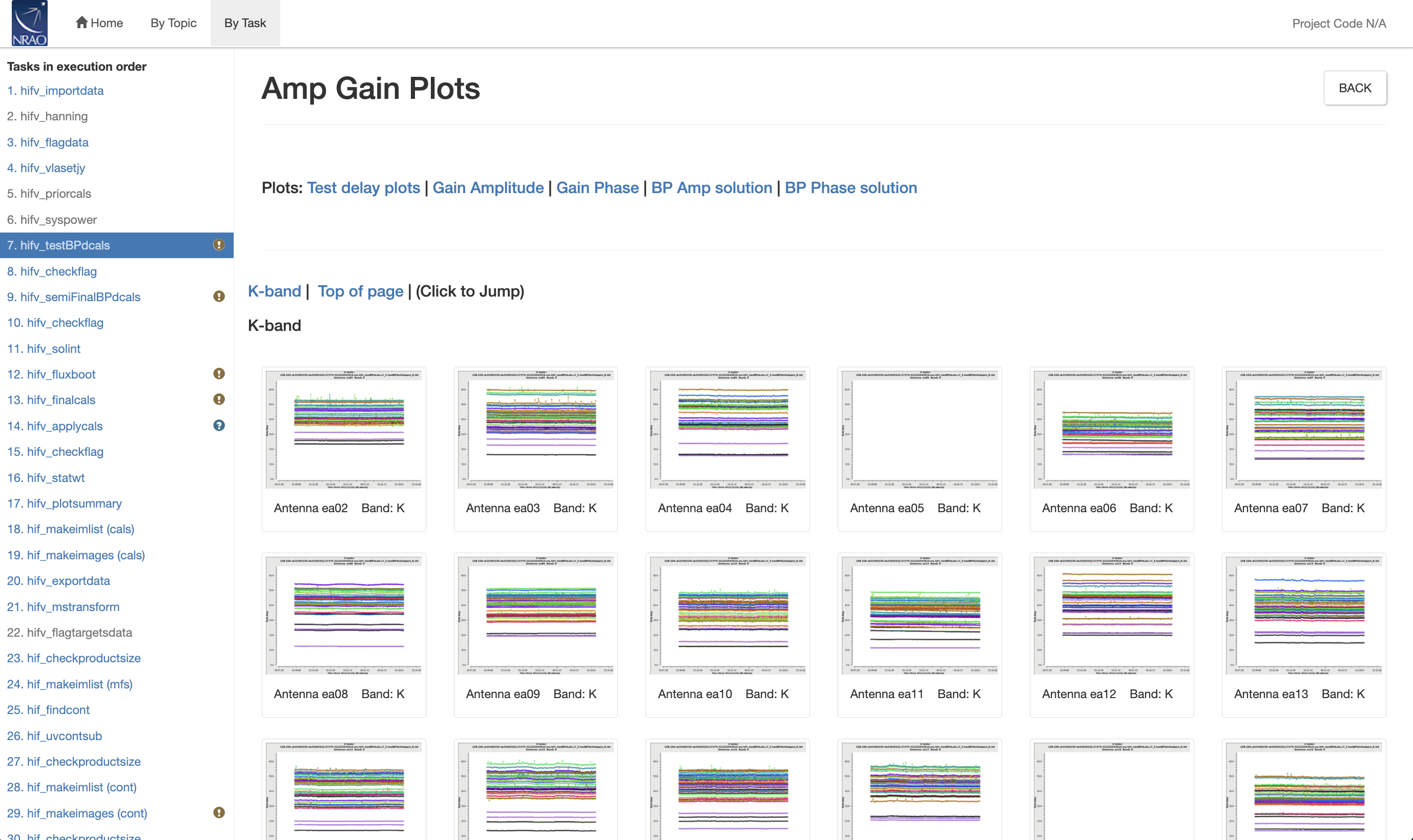 |
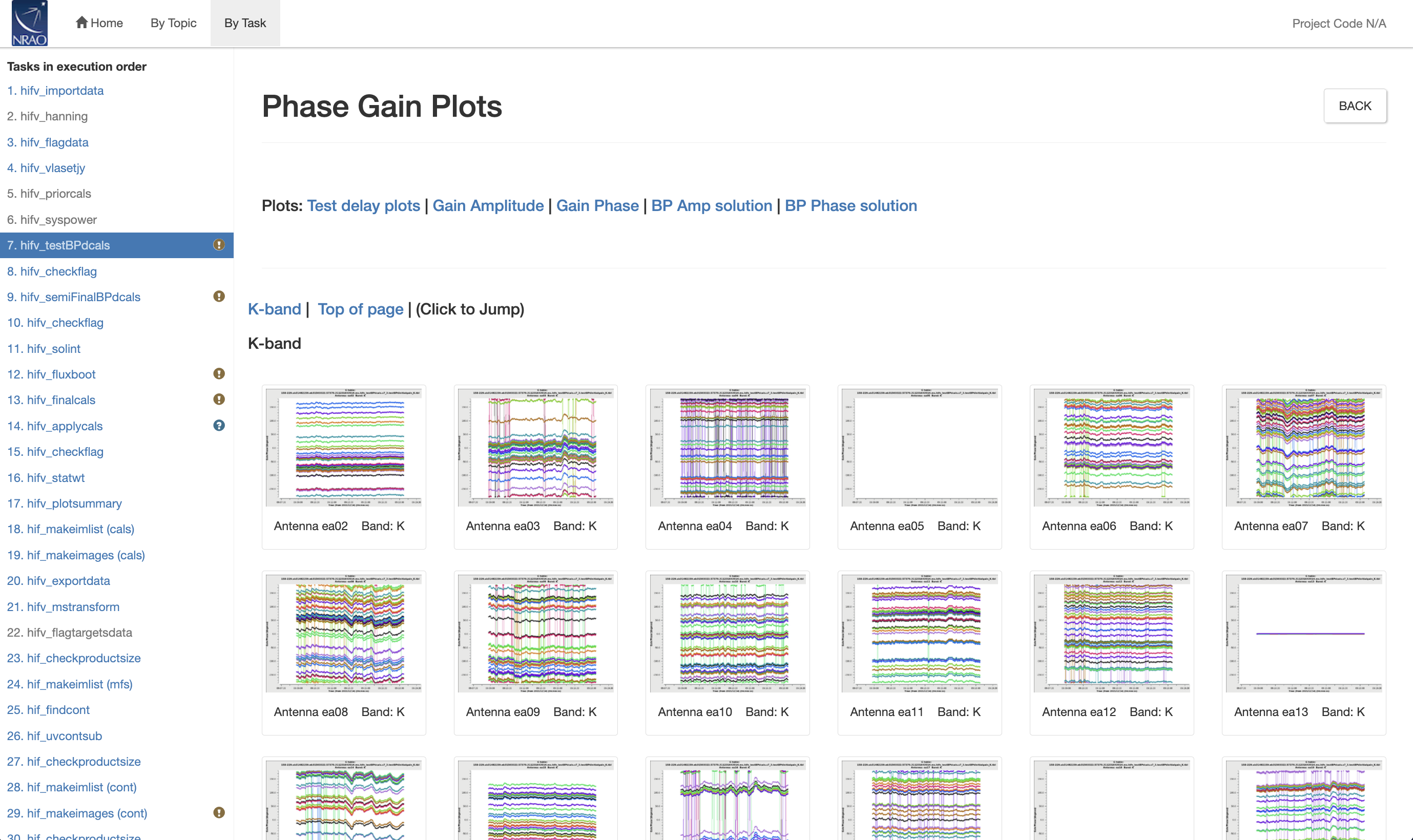 |
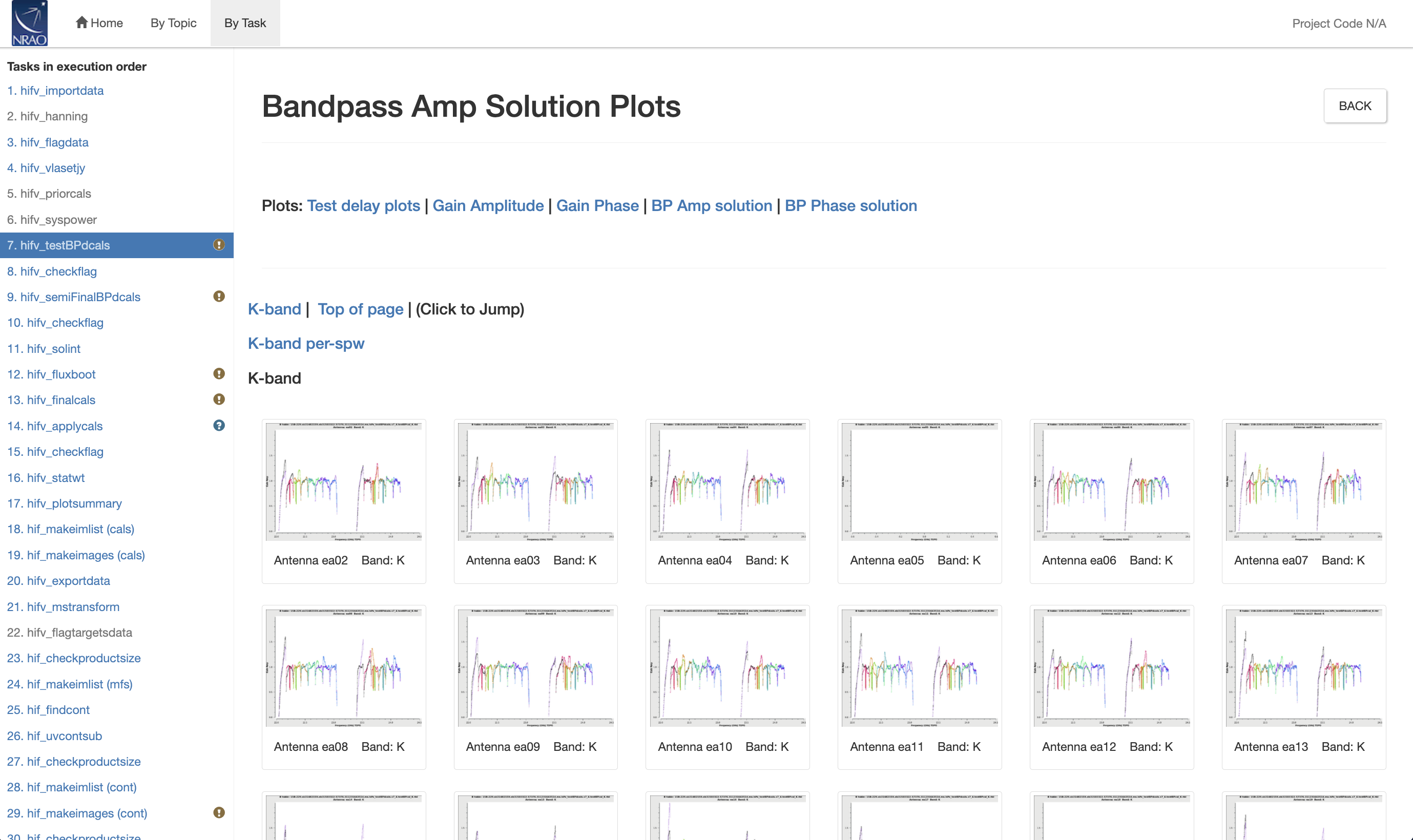 |
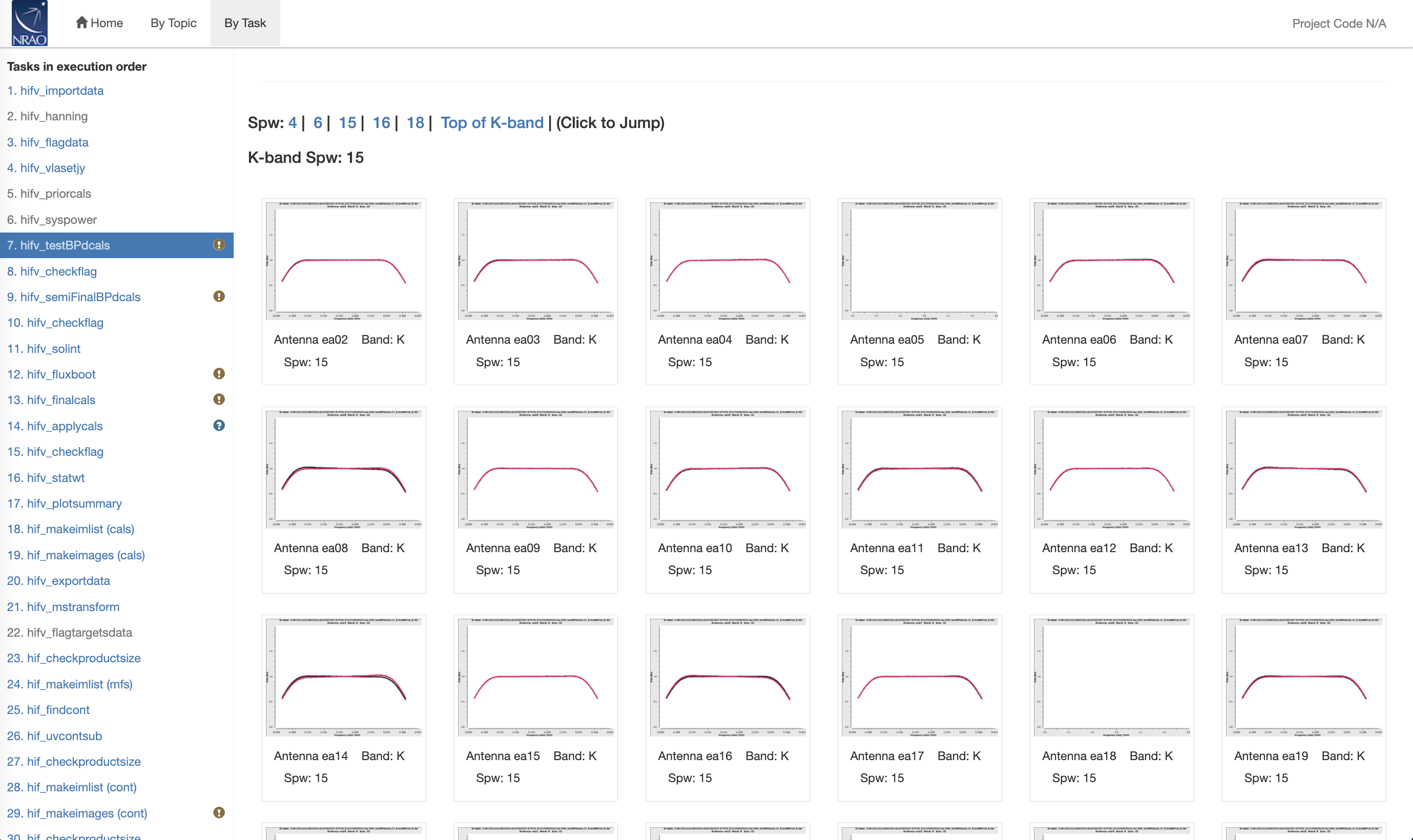 |
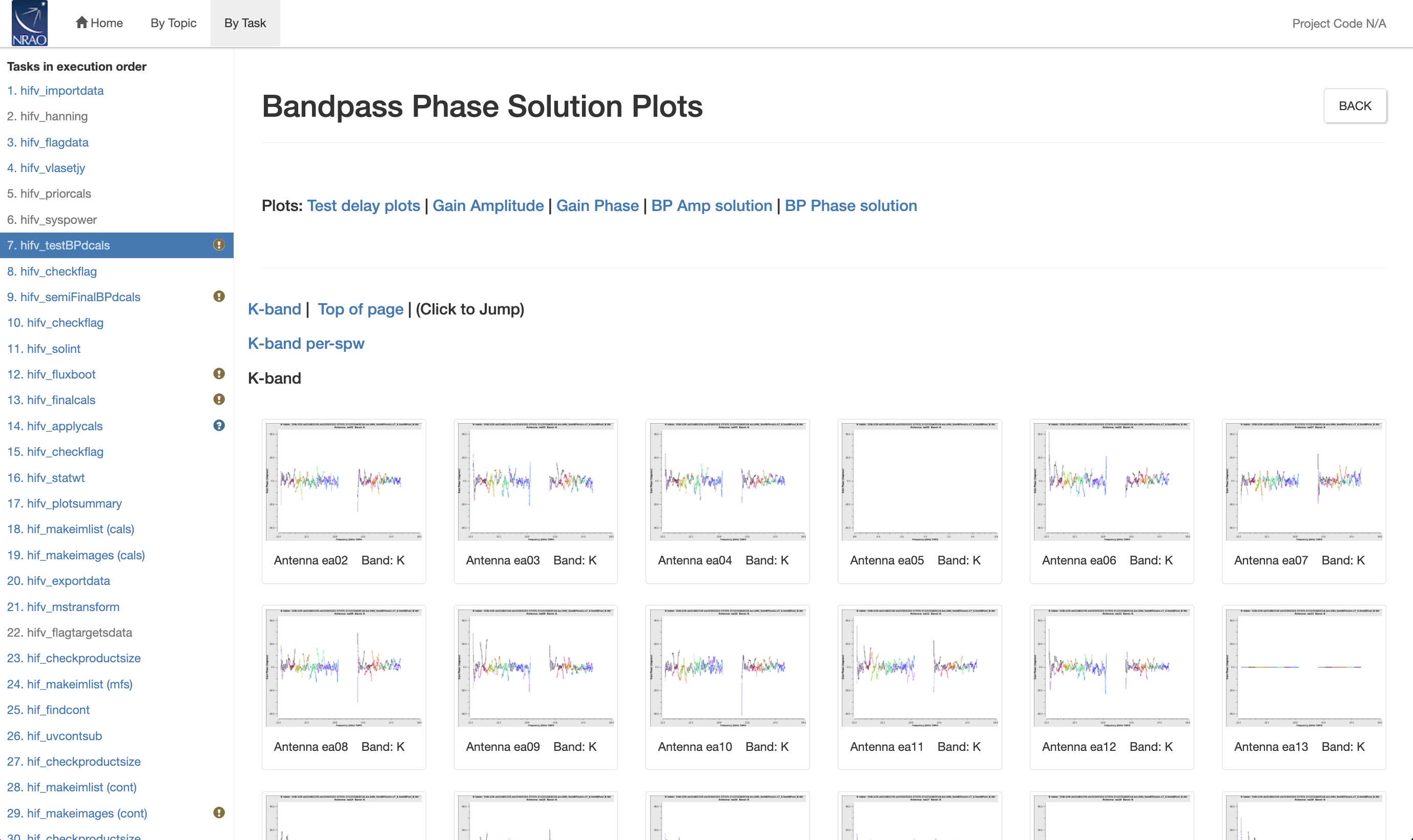 |
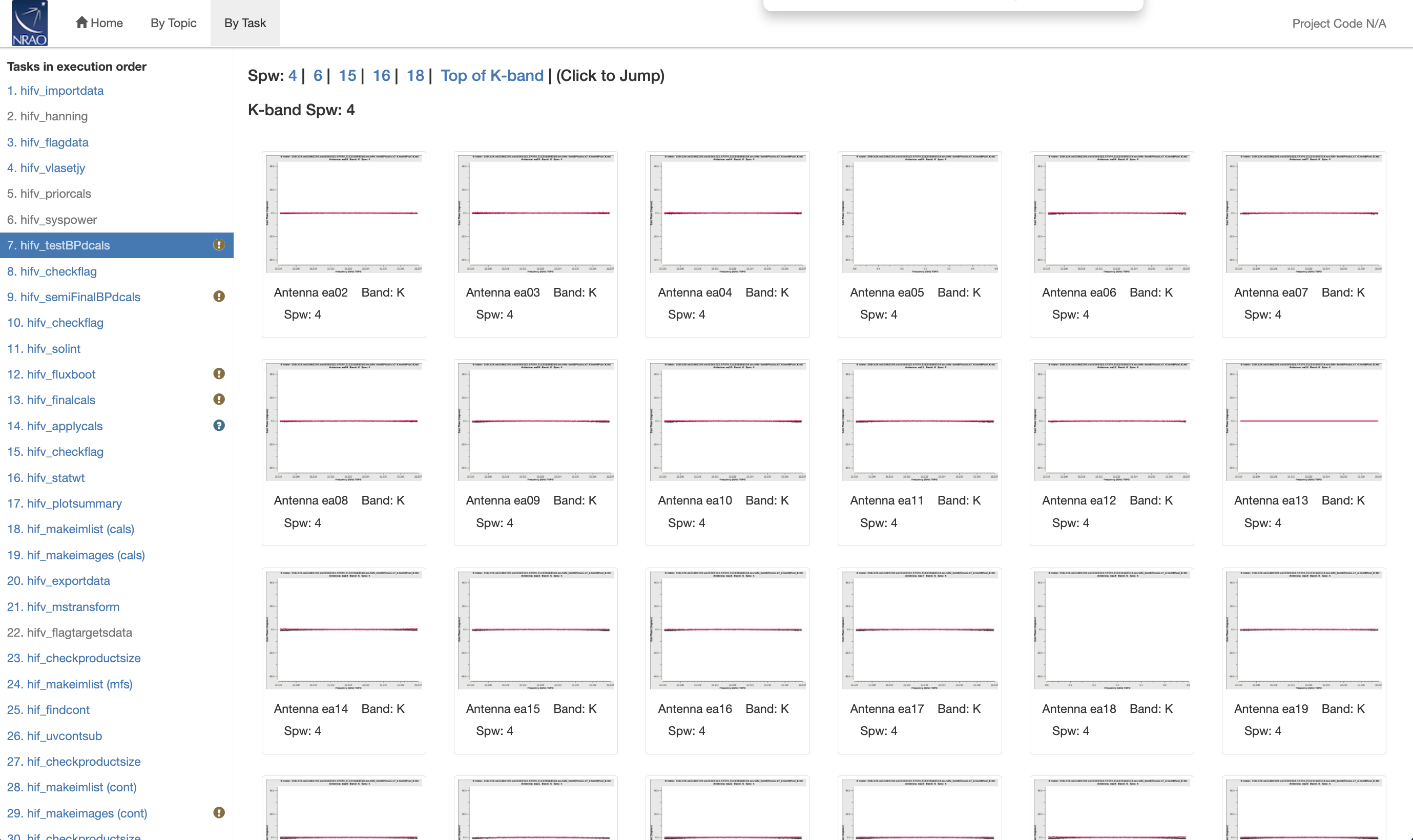 |
For visualization purposes, spectral line windows are plotted separately from the continuum spws in BP amps and phases (cf. Fig. S7-6b, S7-7b).
This initial bandpass calibration went well. Phases for ea13 are flat and zero, meaning that this antenna was selected by the pipeline as a reference antenna. Some gain phase plots show vertical lines; this is just the -180deg to 180deg phase wrap visualization issue, not a problem with the data.
Flagging bad deformatter data
Included in this stage is the detection and removal of data transmission problems (aka 'bad deformatter' issue). A description of the effect is provided on the Pipeline: Frequent VLA problems page. No DTS problem was identified as shown in Fig. S7-1b.
CHECK for: strong RFI and whether it was eliminated in later flagging stages or not (especially via a comparison with the output plots of stage 13). Also check for jumps in phase and/or amplitude away from spectral window edges. If there are phase jumps for all but the reference antenna, maybe a different choice for the reference antenna should be considered. Also watch out for extreme delays of tens of ns and for very noisy data.
QA: checks are performed for the presence of delay and bandpass solutions for all science spws and antennas. The fraction of failed bandpass solutions changes the score to 0 < score < 1 for 60% < failed solutions < 5%. The score is furthermore reduced by 0.1 for every antenna where delays exceed >200ns.
Stage 8. hifv_checkflag: Flag possible RFI on BP calibrator using rflag
Rflag as part of CASA's flagdata is a threshold-based automatic flagging algorithm in CASA. Tfcrop is a 2D (frequency/time) flagging algorithm that works on uncalibrated data. A combination of the two algorithms is run on the bandpass calibrator to remove relatively bright RFI and to obtain improved bandpass calibration tables later on. The plots in Fig. S8-1 show the data before and after flagging on the same scale. The third plot auto-scales the plot after flagging. Note that this plot does not distinguish between continuum and spectral line spws. Some of the vertical features are actually due to increased noise per channel in spectral line spws and not RFI.
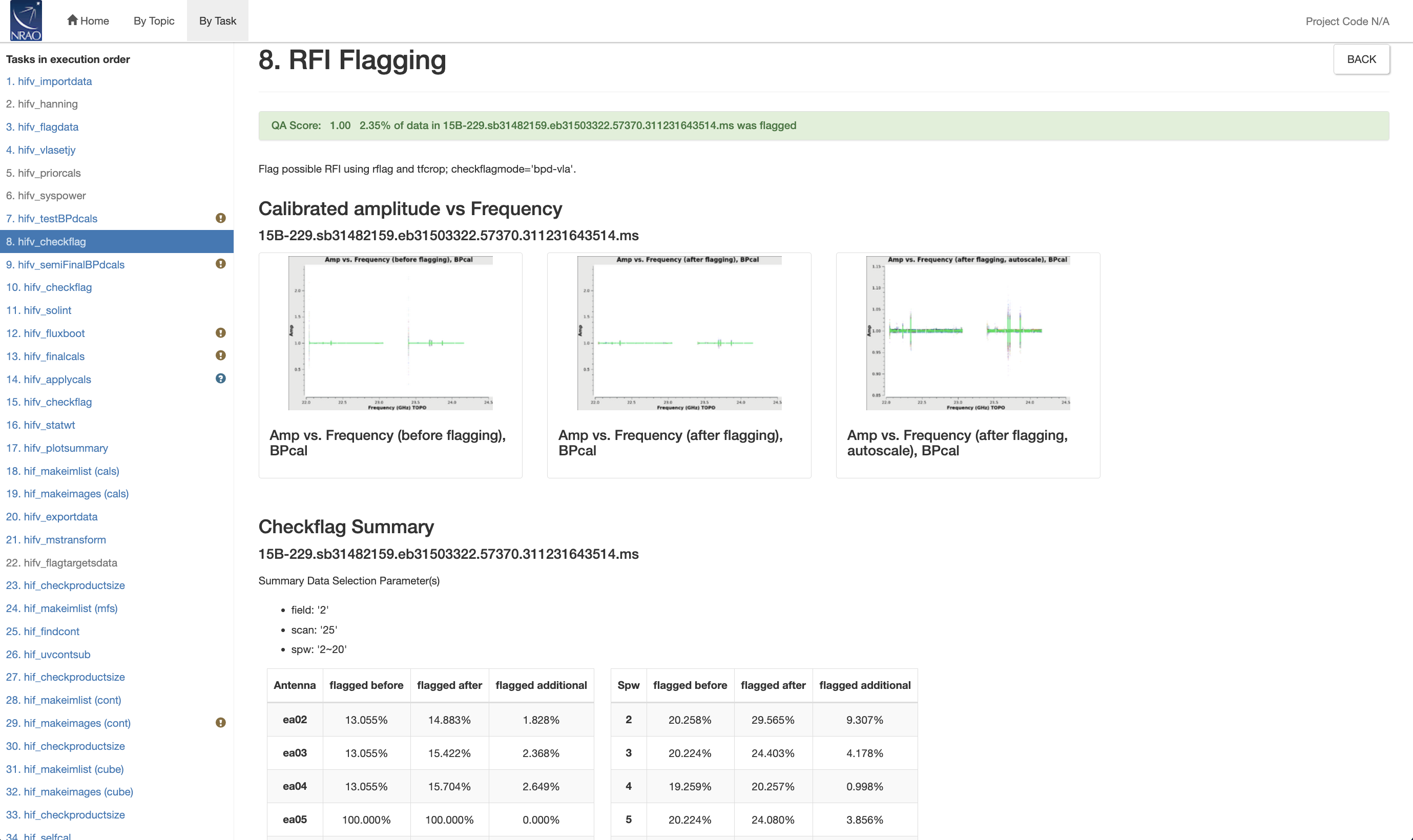 |
The pipeline flagging works as follows: To start with, all data are treated as continuum. Flags will be calculated with the above CASA flagdata routines, and applied to all data. After calibration, however, in stage 21 hif_mstransform, all flags that were applied to the spectral line spws are reverted to those before this stage 8. Only the continuum flags remain.
CHECK for: RFI removal in the diagnostic plots and subsequent processing stages. Check if there are specific antenna/spw combinations that have high flagging percentages, and which may be better flagged entirely.
QA: determined by the percentage of incremental flagging where 0 < score < 1 is the score range for 60% < fraction flagged data < 5%.
Stage 9. hifv_semiFinalBPdcals: Semi-final delay and bandpass calibrations
Now that some RFI was flagged, stage 7 is repeated here at stage 9, which results in better bandpass and delay solutions (Fig. S9-1). The notification is the same as in stage 6. The solutions on the main page are now applied to all calibrators not only the bandpass. This shows up as data at different flux density levels in Fig. S9-1.
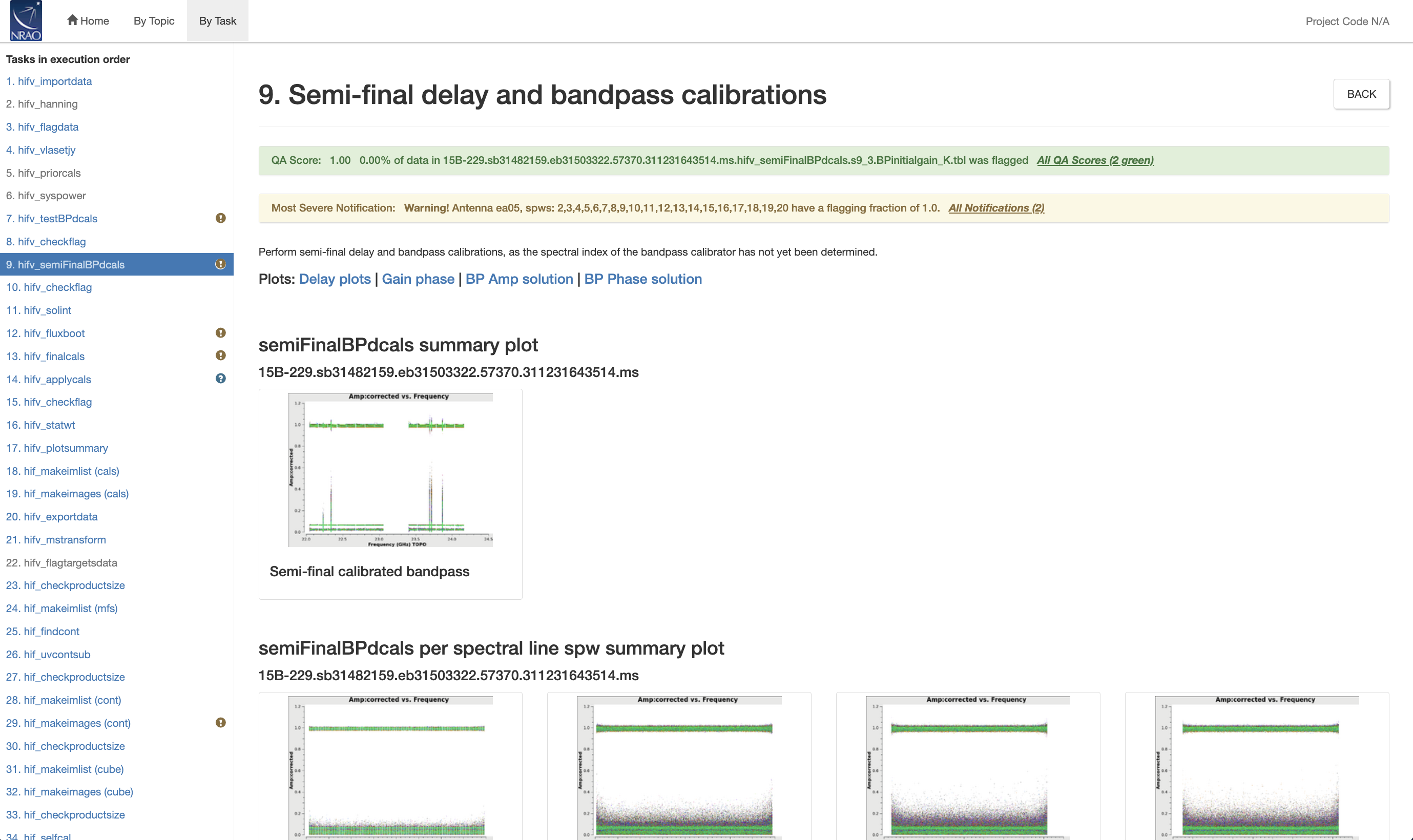 |
CHECK for: strong RFI and whether it was eliminated in later flagging stages or not (especially via a comparison with the output plots of stage 13). Also check for jumps in phase and/or amplitude away from spectral window edges. If there are phase jumps for all but the reference antenna, maybe a different choice for the reference antenna should be considered. Also watch out for extreme delays of tens of ns and for very noisy data.
QA: checks are performed for the presence of delay and bandpass solutions for all science spws and antennas. The fraction of failed bandpass solutions changes the score to 0 < score < 1 for 60% < failed solutions < 5%. The score is furthermore reduced by 0.1 for every antenna where delays exceed >200ns.
Stage 10. hifv_checkflag: Flag possible RFI on all calibrators using rflag
Once more, tfcrop and rflag are executed, this time on all calibrator scans (Fig. S10-1). For the bandpass, after the bright RFI has been removed in stage 7 and a new bandpass solution has been applied in stage 8, a new flagging threshold will account for weaker RFI, which will be removed here in stage 9. With more RFI flagged, the spectral line spws show up as vertical features more prominently.
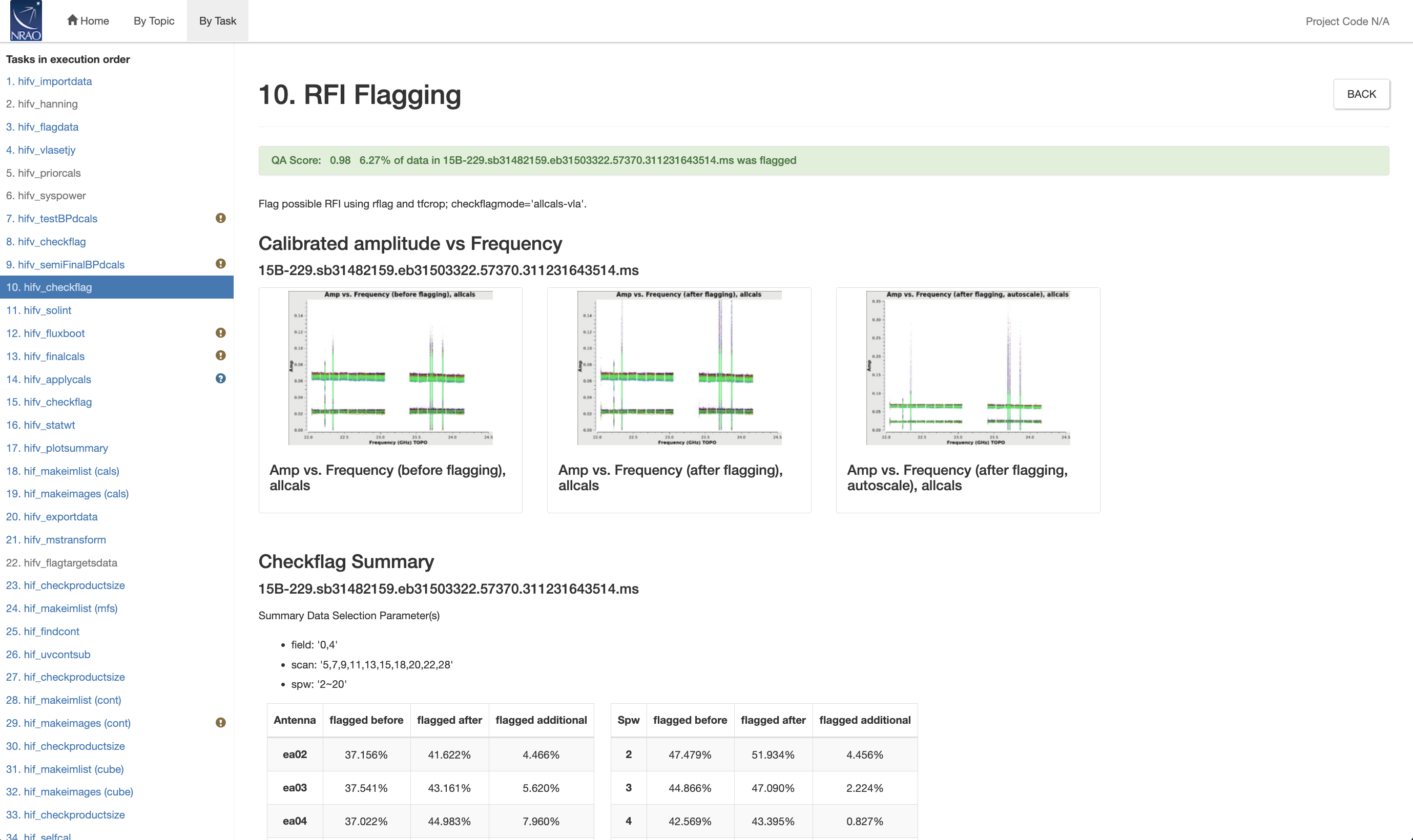 |
CHECK for: RFI removal in the diagnostic plots and subsequent processing stages. Check if there are specific antenna/spw combinations that have high flagging percentages, and which may be better flagged entirely.
QA: determined by the percentage of incremental flagging where 0 < score < 1 is the score range for 60% < fraction flagged data < 5%.
Stage 11. hifv_solint: Determine solint and Test gain calibrations
For the final calibration, the pipeline determines the shortest and longest applicable solution intervals (solint). Typically the short solint is a visibility integration (dump) time interval; the longest of those are used when they differ during the observations. The long solint is derived from the average length of the longest gain calibration scan.
In our case (Fig. S11-1) the longest solution interval, capturing the length of gain calibrator scans after flagging, is 39s. The short solution interval is 'int', which corresponds to one integration length, or 3s (cf. the overview page).
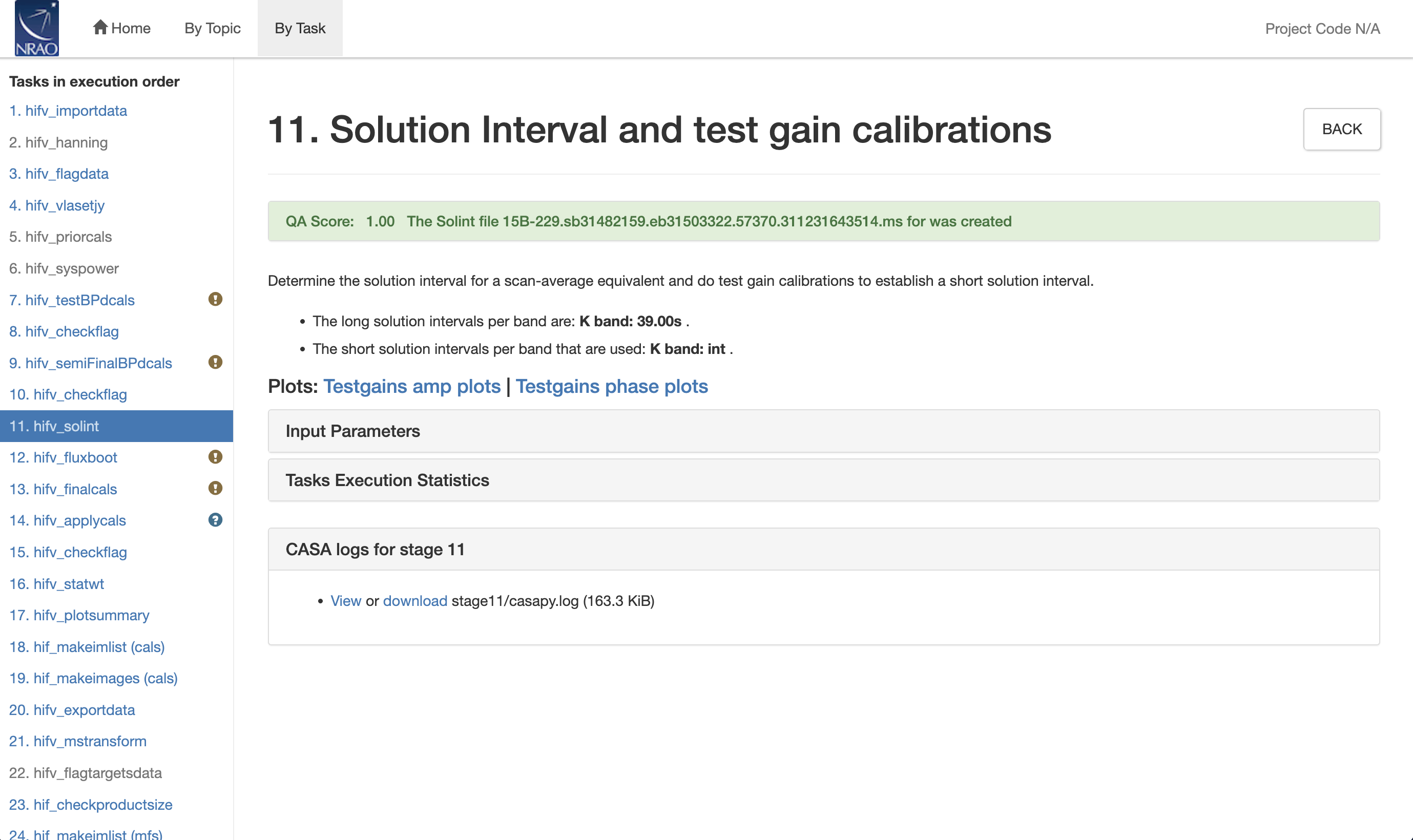 |
Initial temporal gain and phase solutions are calculated for each antenna, spectral window, and polarization using these time intervals (Fig. S11-2 and S11-3).
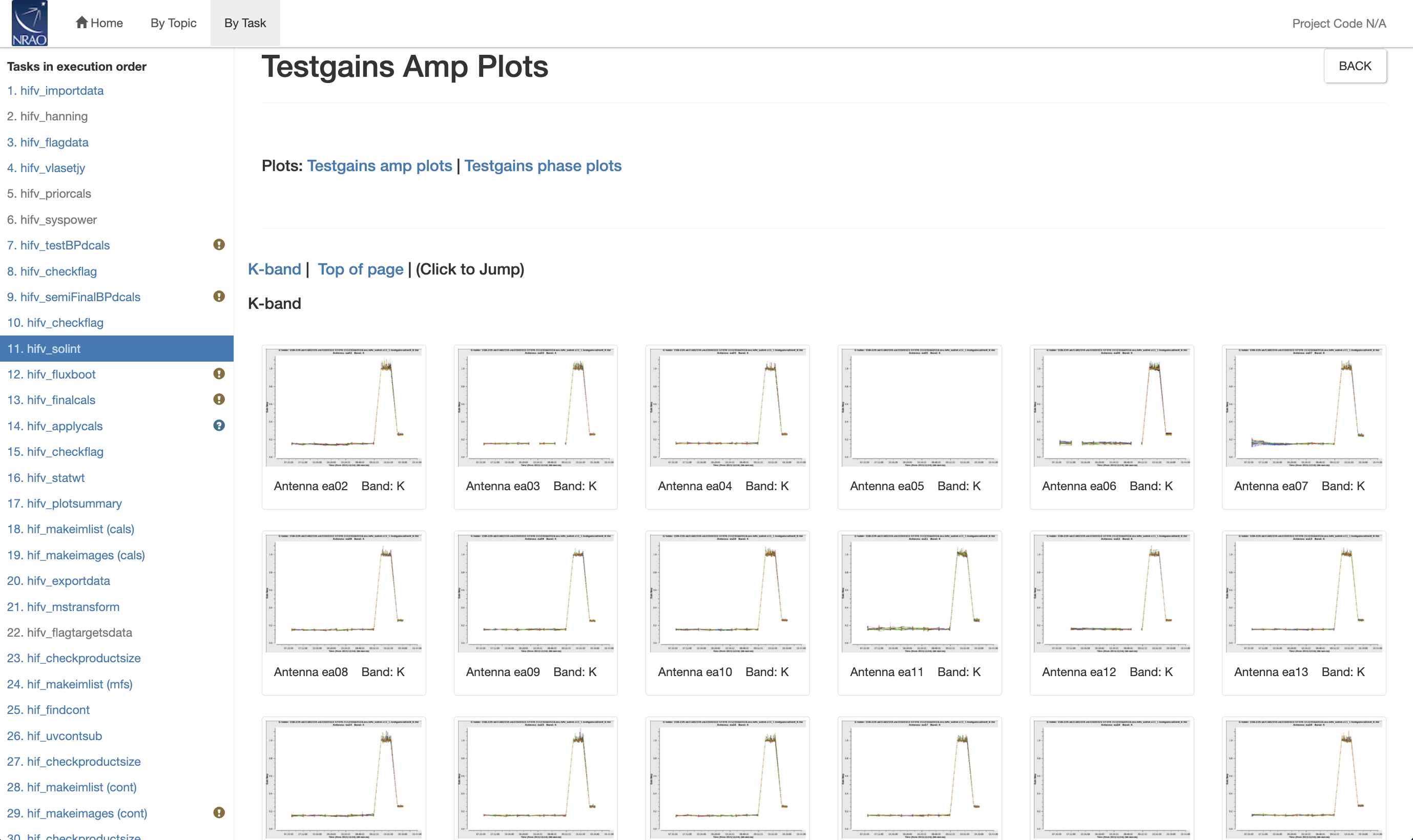 |
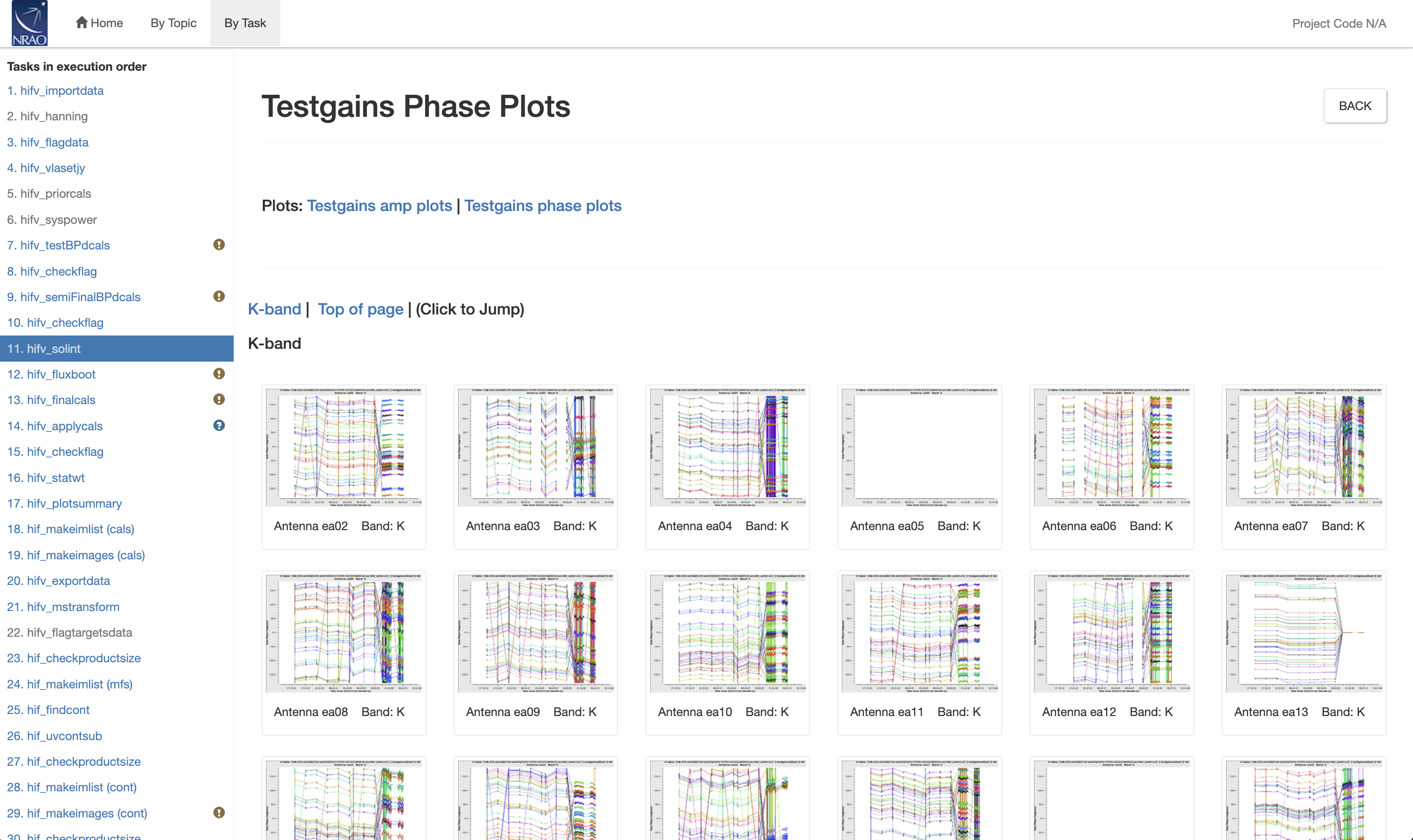 |
For the phases, we don't see an obvious reference antenna anymore. This is due to the flexible application of the reference antenna. Ea11 and ea20 appear to be contenders for the reference antenna at different times (cf. Fig. S11-4 and S11-5), but it turns out that the reference antenna was chosen much more flexibly for each spw and time interval (cf. the CASA log in Fig. S11-6, visible when clicking the link at the bottom of the page).
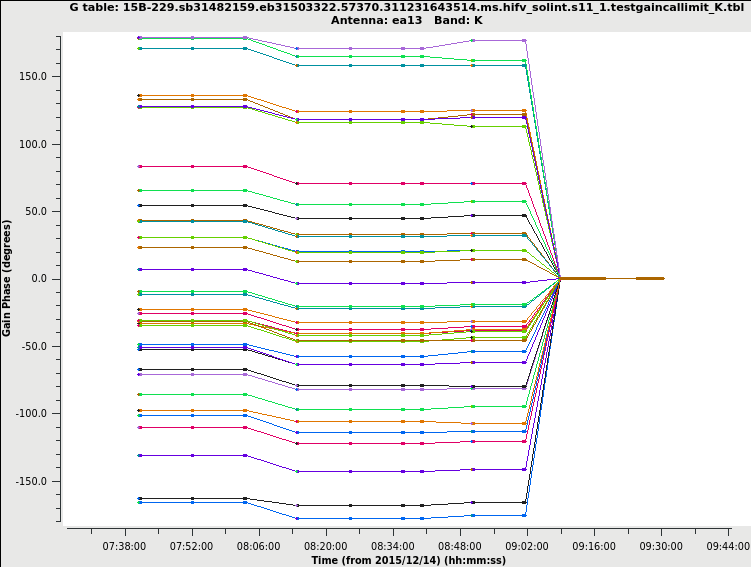 |
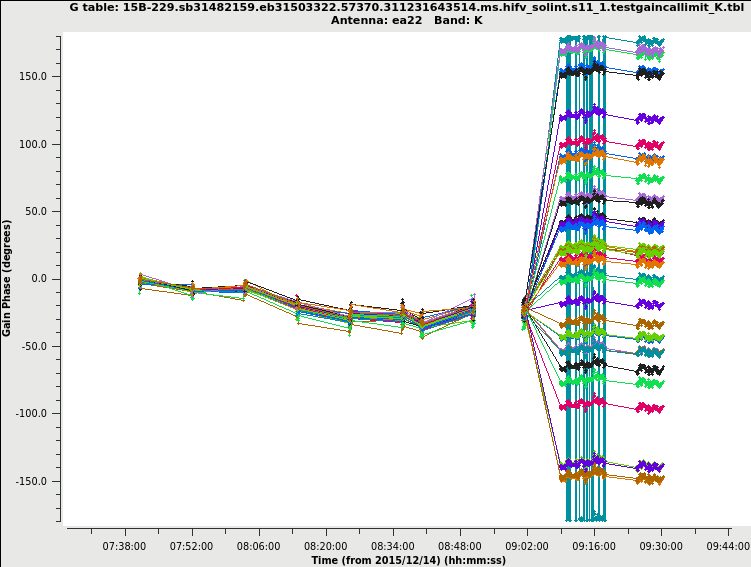 |
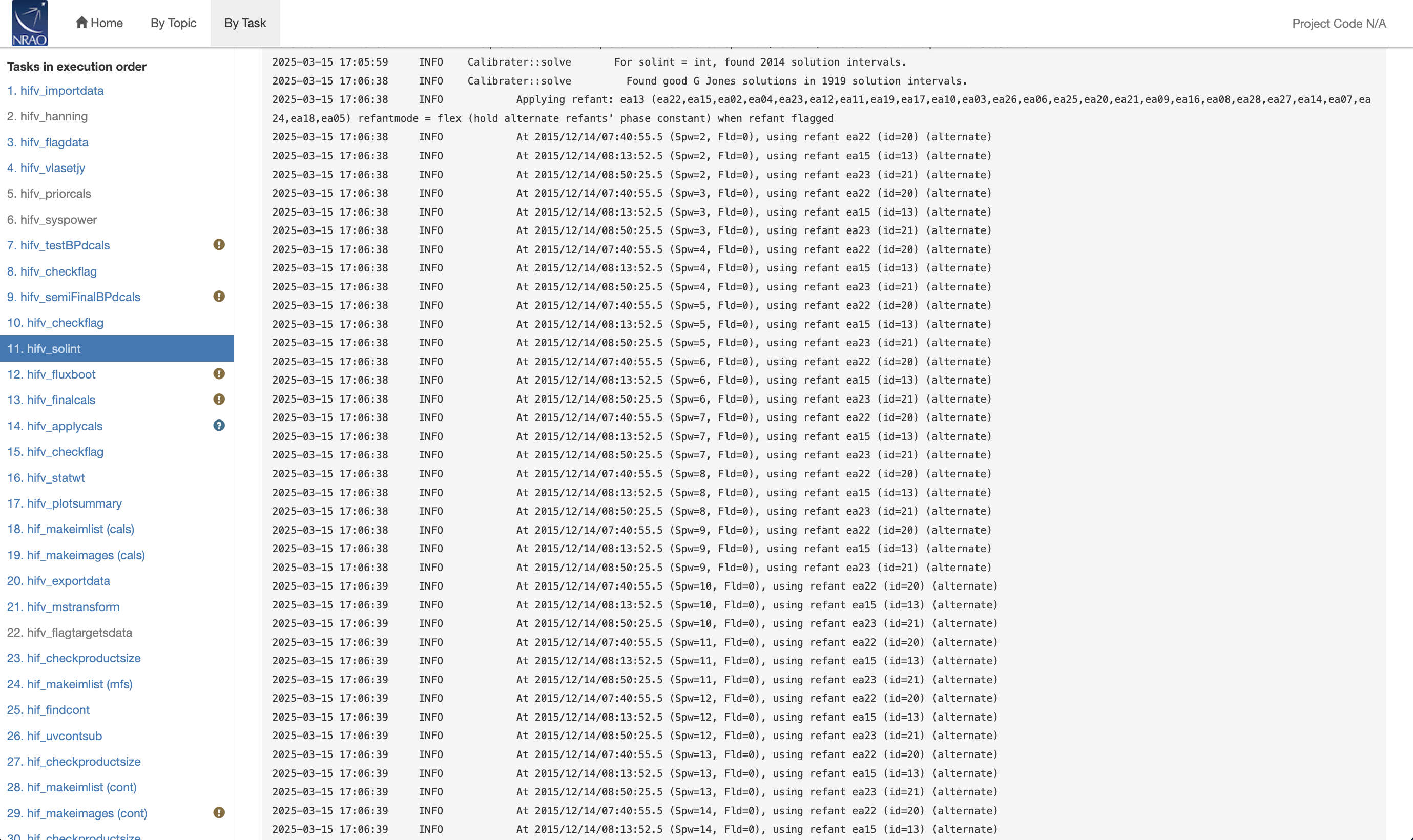 |
Given the plotting algorithm, lines only connect the exact same setup (antenna spw, pol, etc). Flagged data will not be connected. The plots therefore sometimes look different in their visual appearance with connected lines sometimes even criss-crossing.
CHECK for: consistency with the data. The short solution interval should be close to the (longest) visibility integration time and the long solution interval should be close to the longest gain calibration scan length. Gains should be smooth with little variations in time (where larger gain variations are more likely to occur for higher frequencies), phases should not show any jumps and should be relatively smooth in time (where larger phase variations are likely to occur for higher frequencies and longer baselines).
QA: N/A; but a warning will be issued when the long and short solint values are the same +/- one integration.
Stage 12. hifv_fluxboot: Gain table for flux density bootstrapping
Now, the flux densities are bootstrapped from the flux density calibrator to all other calibrators, including the complex gain (amplitude and phase) calibrator. To do so, polynominal functions are fitted for the secondary calibrators and the absolute flux densities are determined for each spw. They are then inserted in the MODEL column via setjy and reported for each spectral window.
For our example, the pipeline derives frequency-dependent flux densities between 26.6 and 25.7 Jy for 'J0319+4130' and 0.62 to 0.59 Jy for 'J0541-0541', the two calibrators that are observed with a BANDPASS or PHASE intent. All data also receive polynomial fits, which are pretty flat for those sources at the observed frequencies (Fourth panel of Fig. S12-1. The third panel shows the (very small) residual errors of the fits. A gaintable ('fluxgaincal.g') is generated based on these numbers and shown in the first plot, based on the source model that is shown in the second plot. If the plots show RFI or badly calibrated data, it is possible to edit the 'fluxgaincal.g' file using e.g. plotms. The VLA pipeline webpage has instructions on how to insert an edited table into the calibration run.
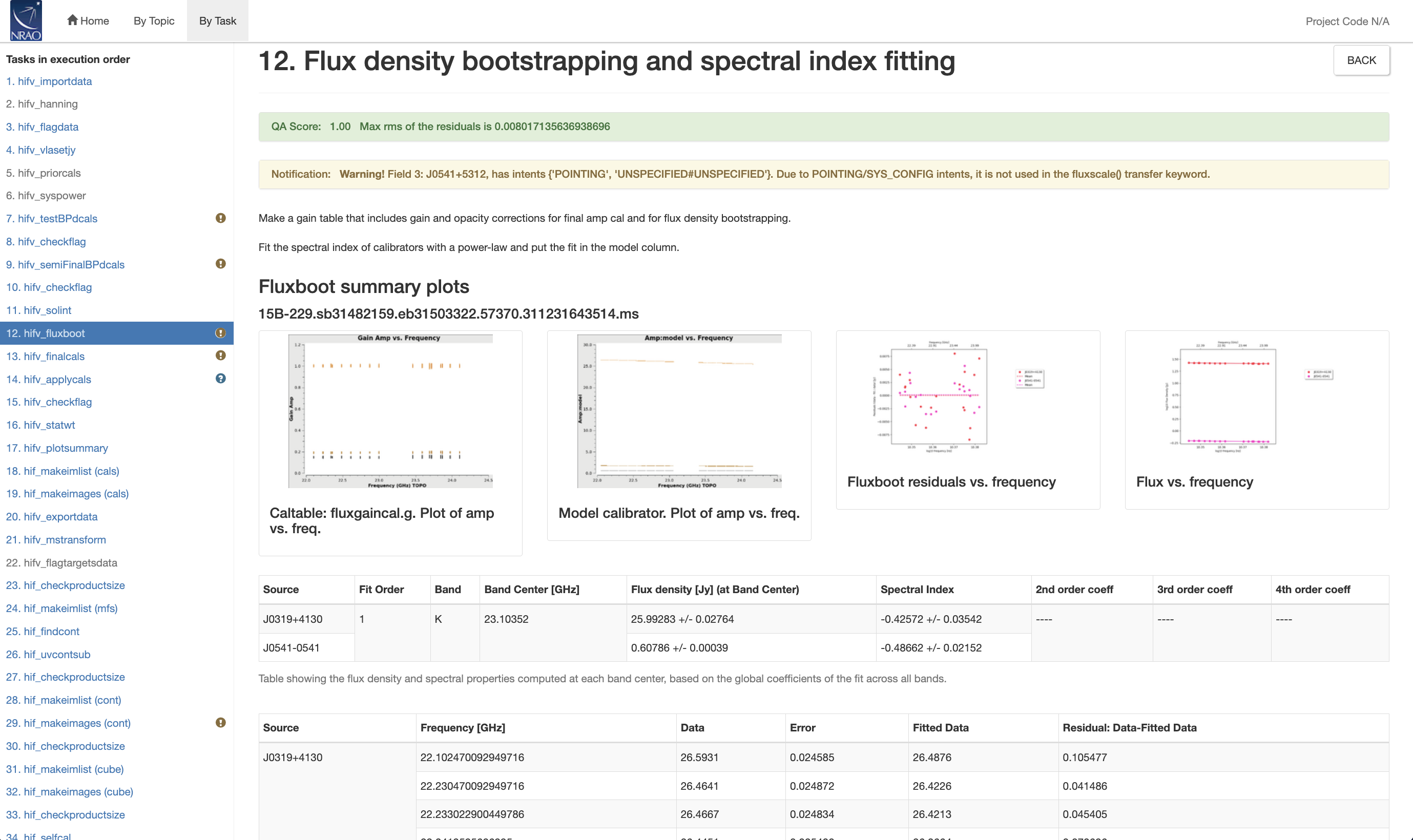 |
CHECK for: that the flux density values are close to the known values for the calibrator. Check the VLA calibrator manual at https://science.nrao.edu/facilities/vla/observing/callist for consistency. Since most calibrator sources are time variable AGN, some differences to the VLA catalog are expected. In particular, at higher frequencies they could be different by up to tens of percent.
QA: based on the S/N and maximum residual of the fit. A fraction of 0.01 is deducted from a max score of 1.0 for each residual that is more than 1 sigma away from the mean. This value is calculated per source and normalized over all sources.
Stage 13. hifv_finalcals: Final Calibration Tables
The final calibration tables are now derived. Those are the most important ones given that they are actually applied to the data in stage 14. The tables, which contain antenna based solutions, are: Final delay (Fig. S13-1), bandpass (BP) initial gain phase (Fig. S13-2), BP Amp solution (Fig. S13-3), BP Phase solution (Fig. S13-4), Phase (short) gain solution (Fig. S13-5), Final amp time cal (Fig. S13-6), Final amp freq cal (Fig. S13-7), and Final phase gain cal (Fig. S13-7).
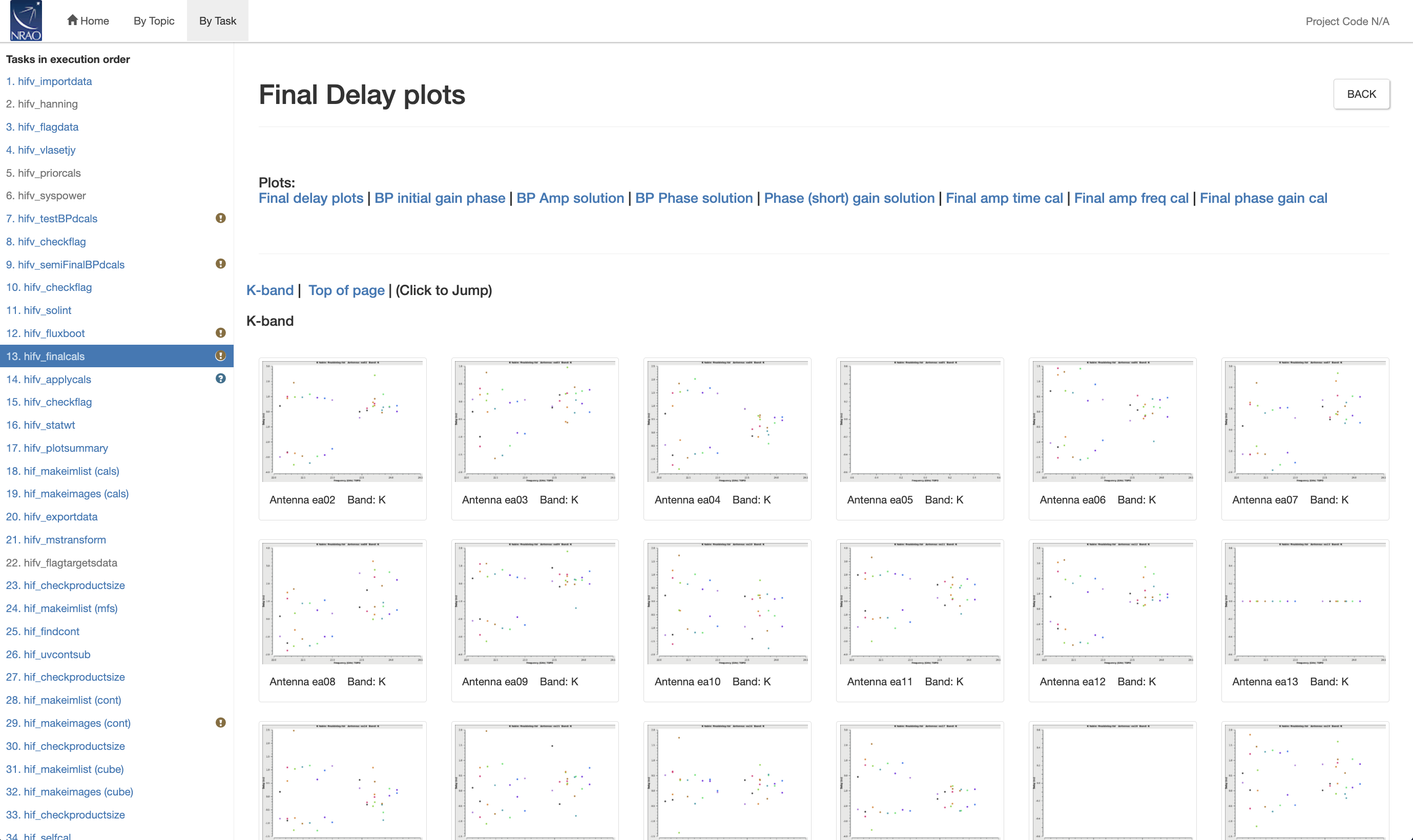 |
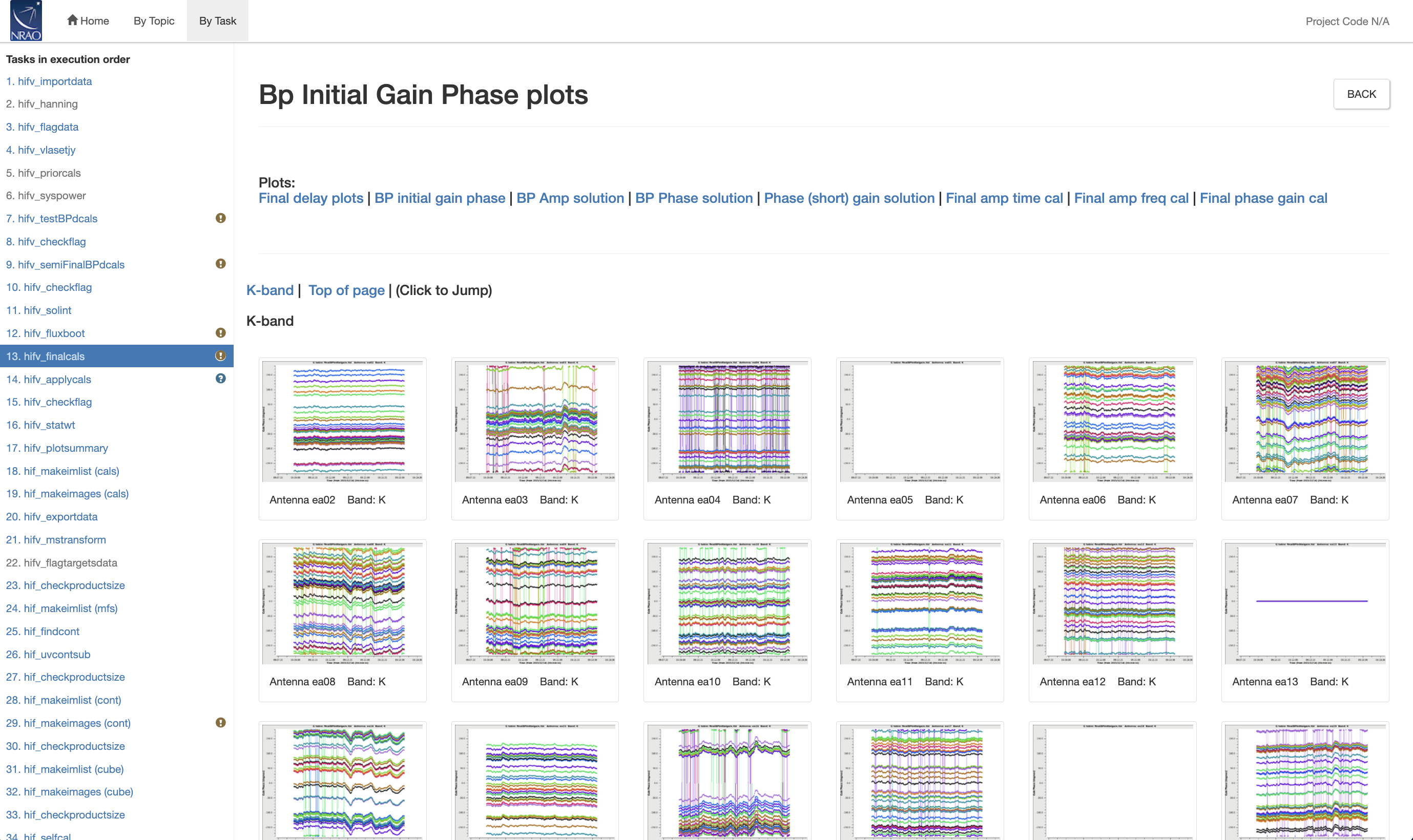 |
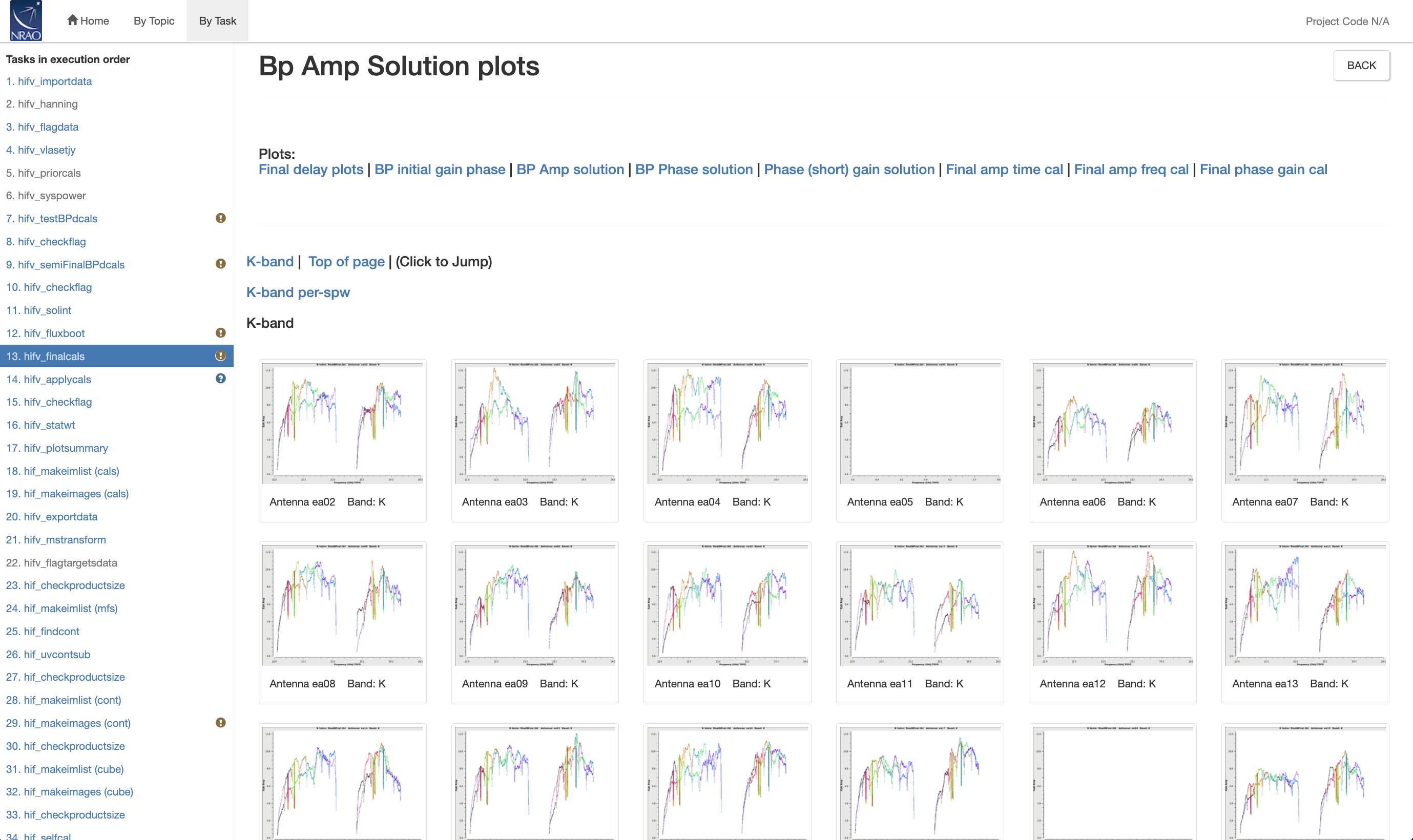 |
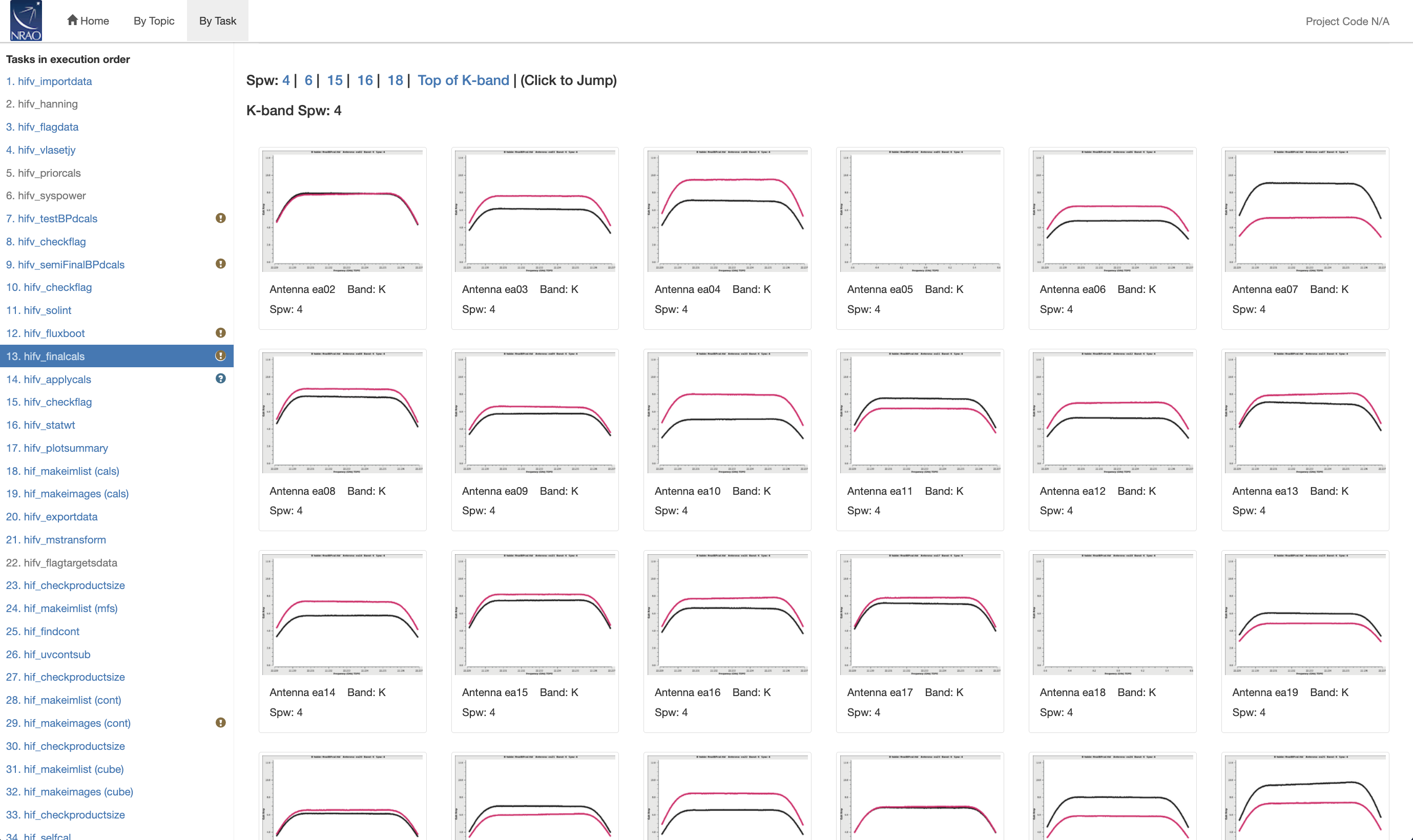 |
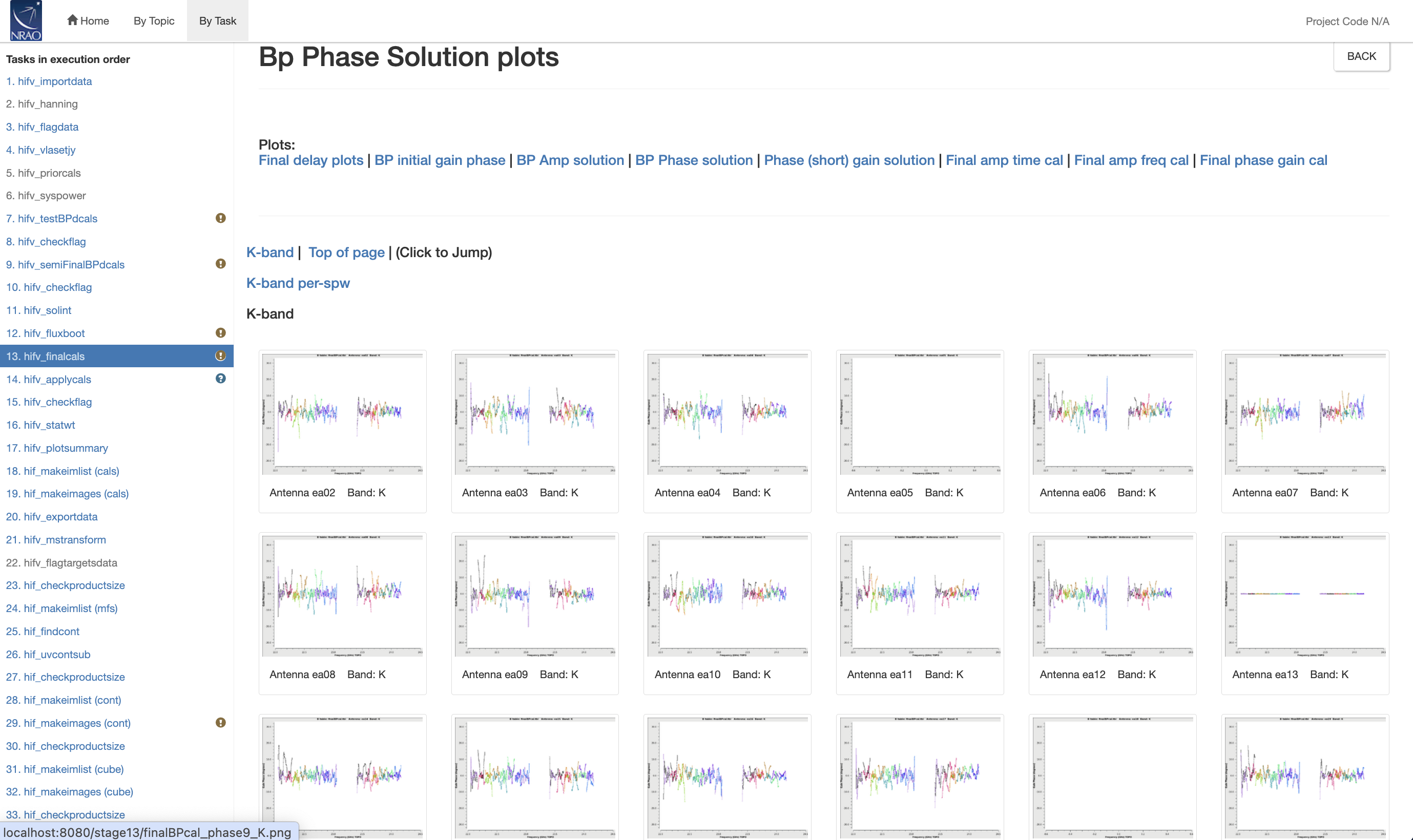 |
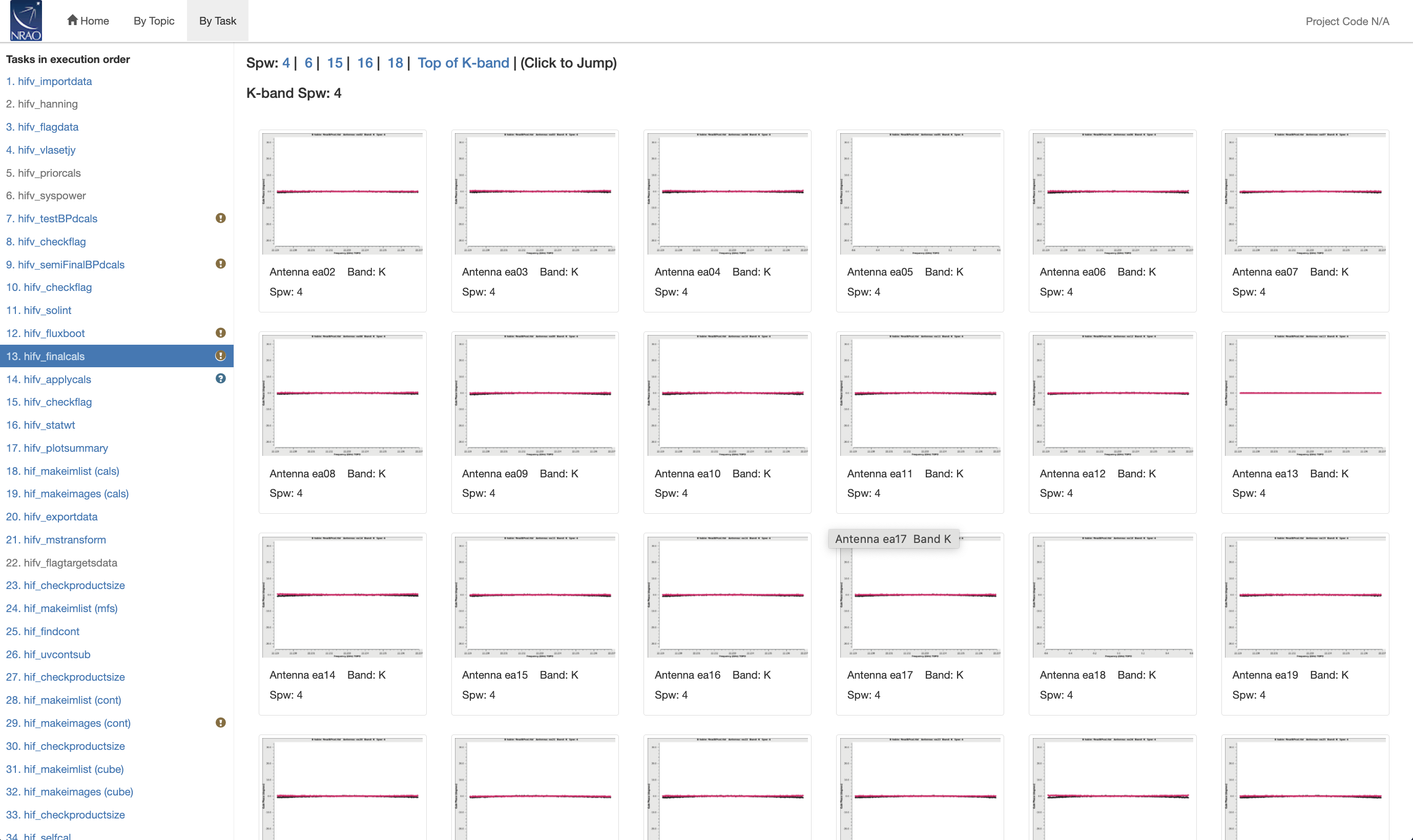 |
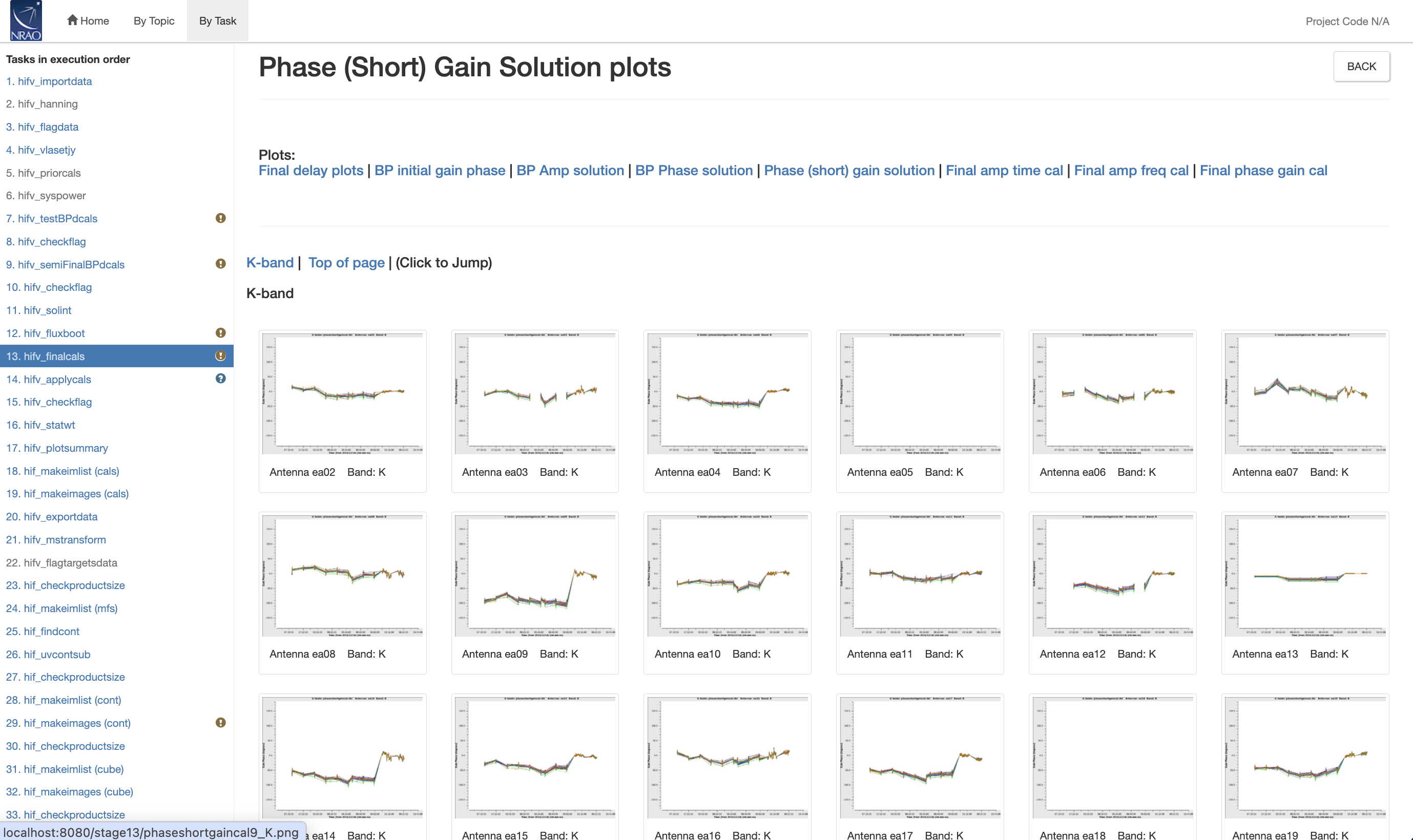 |
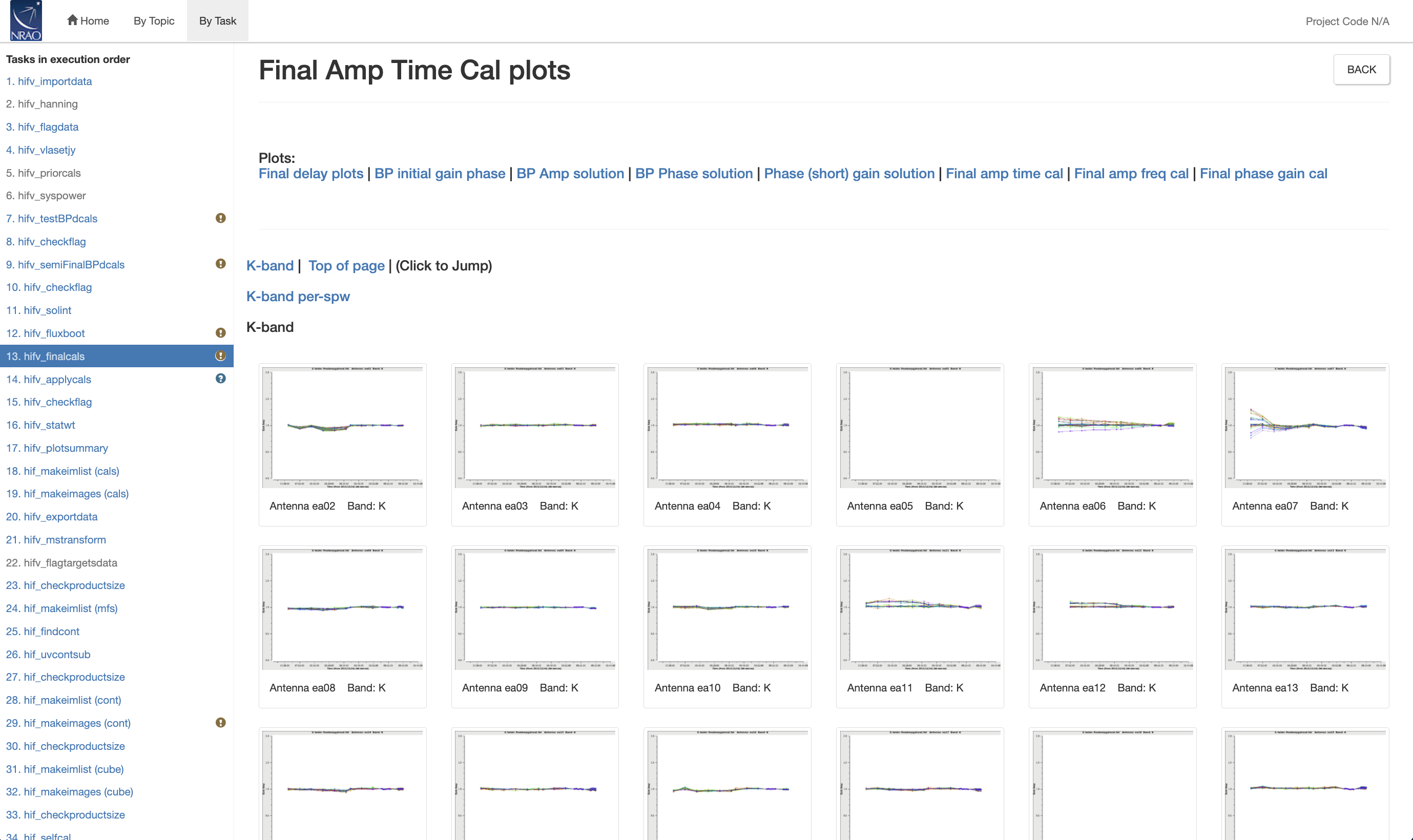 |
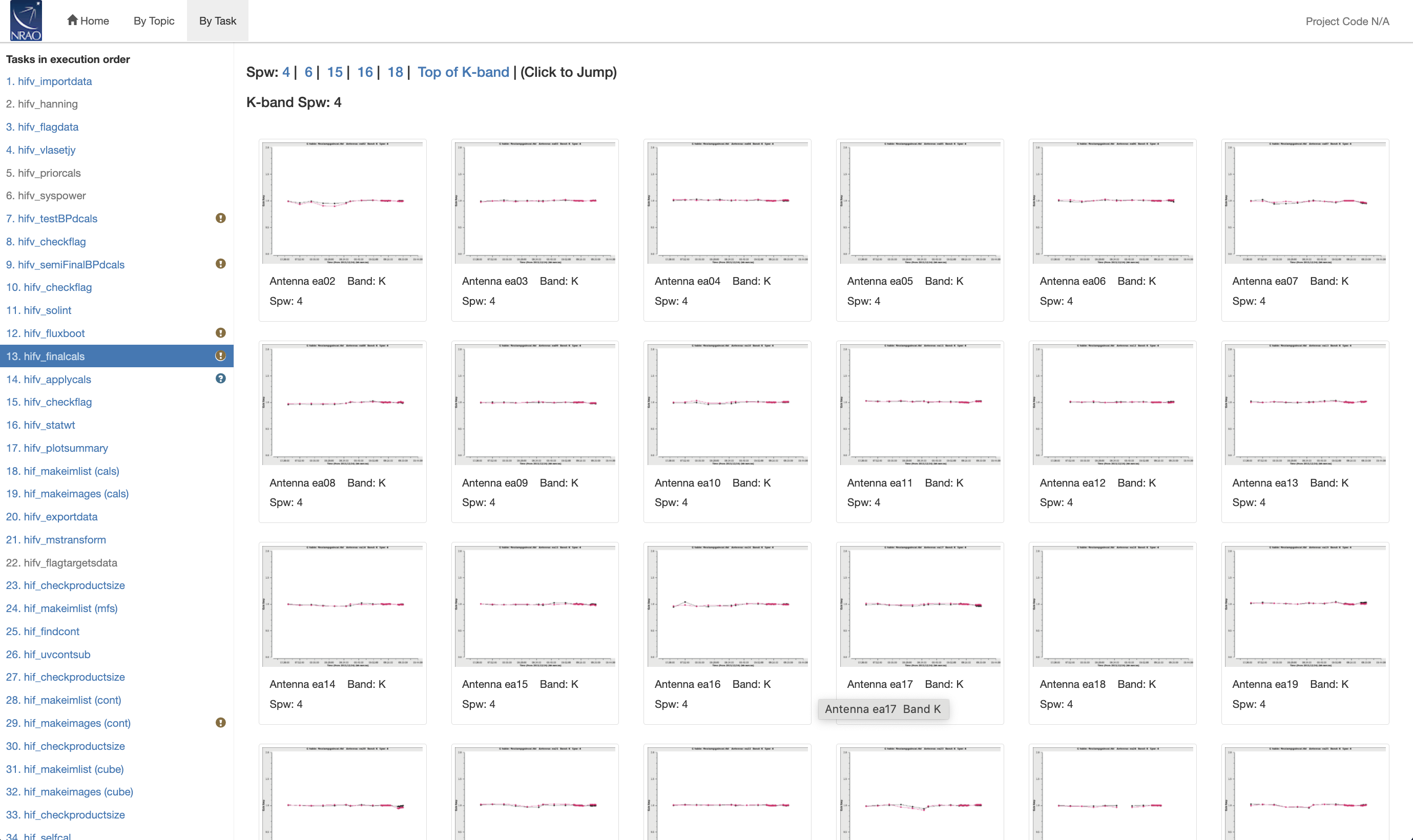 |
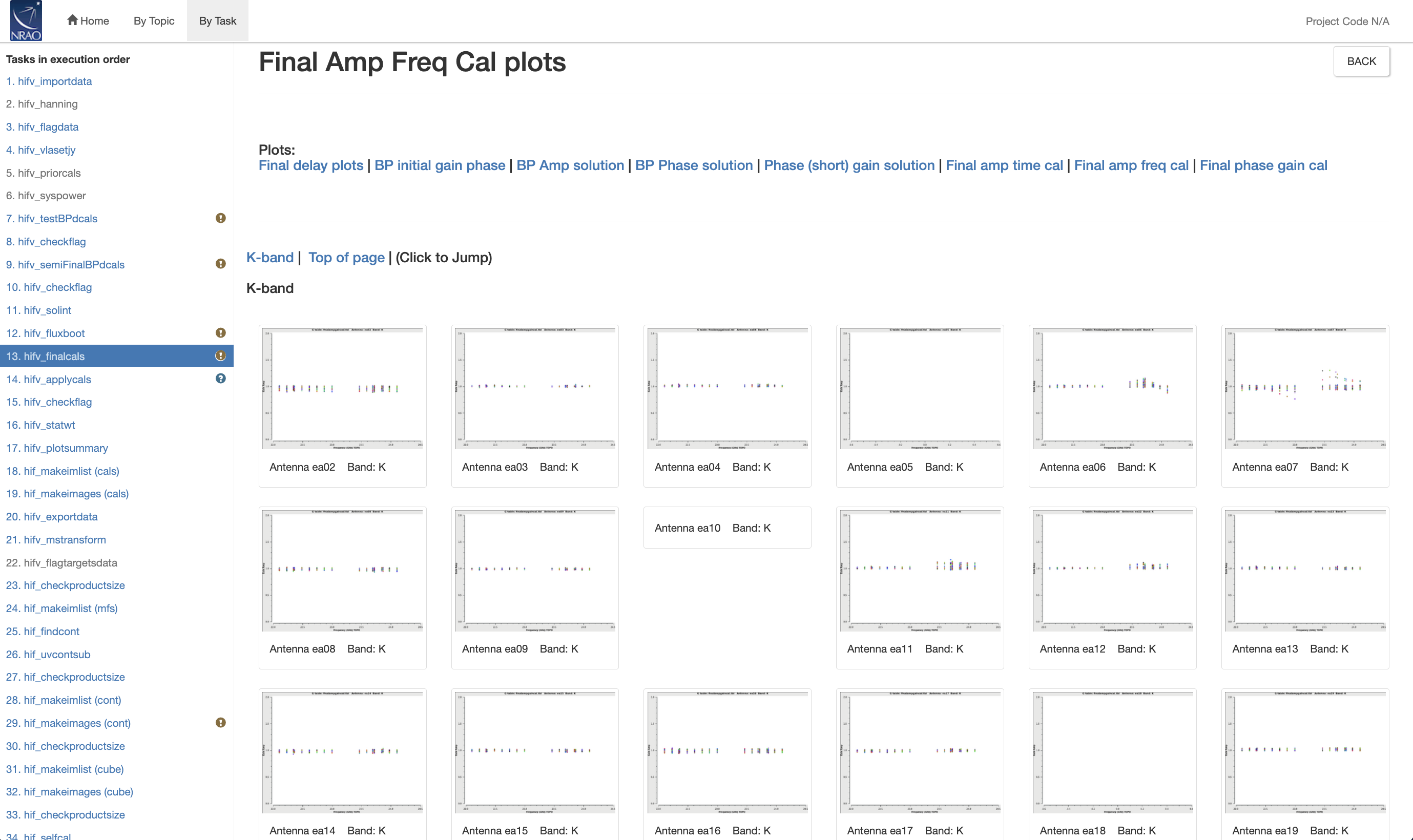 |
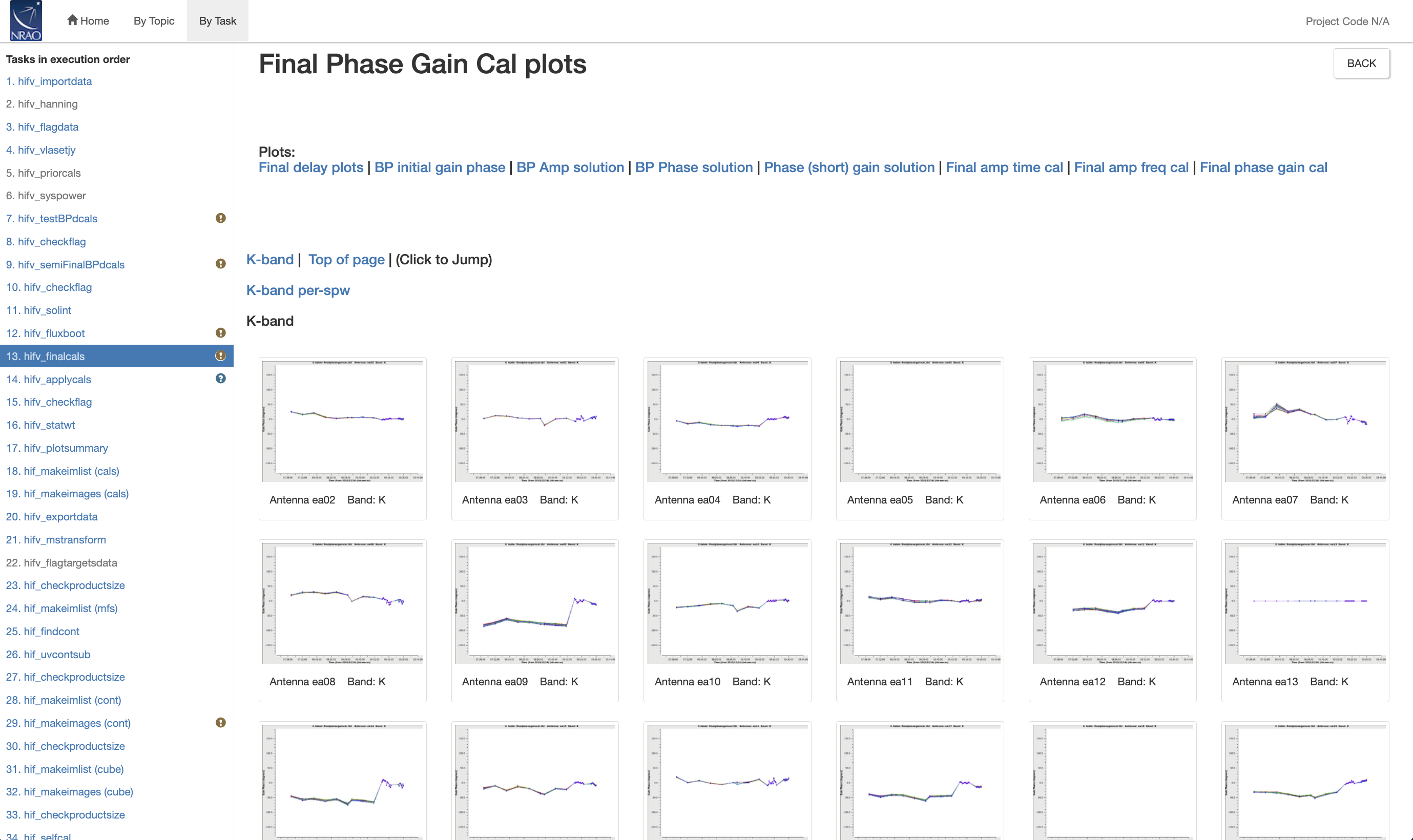 |
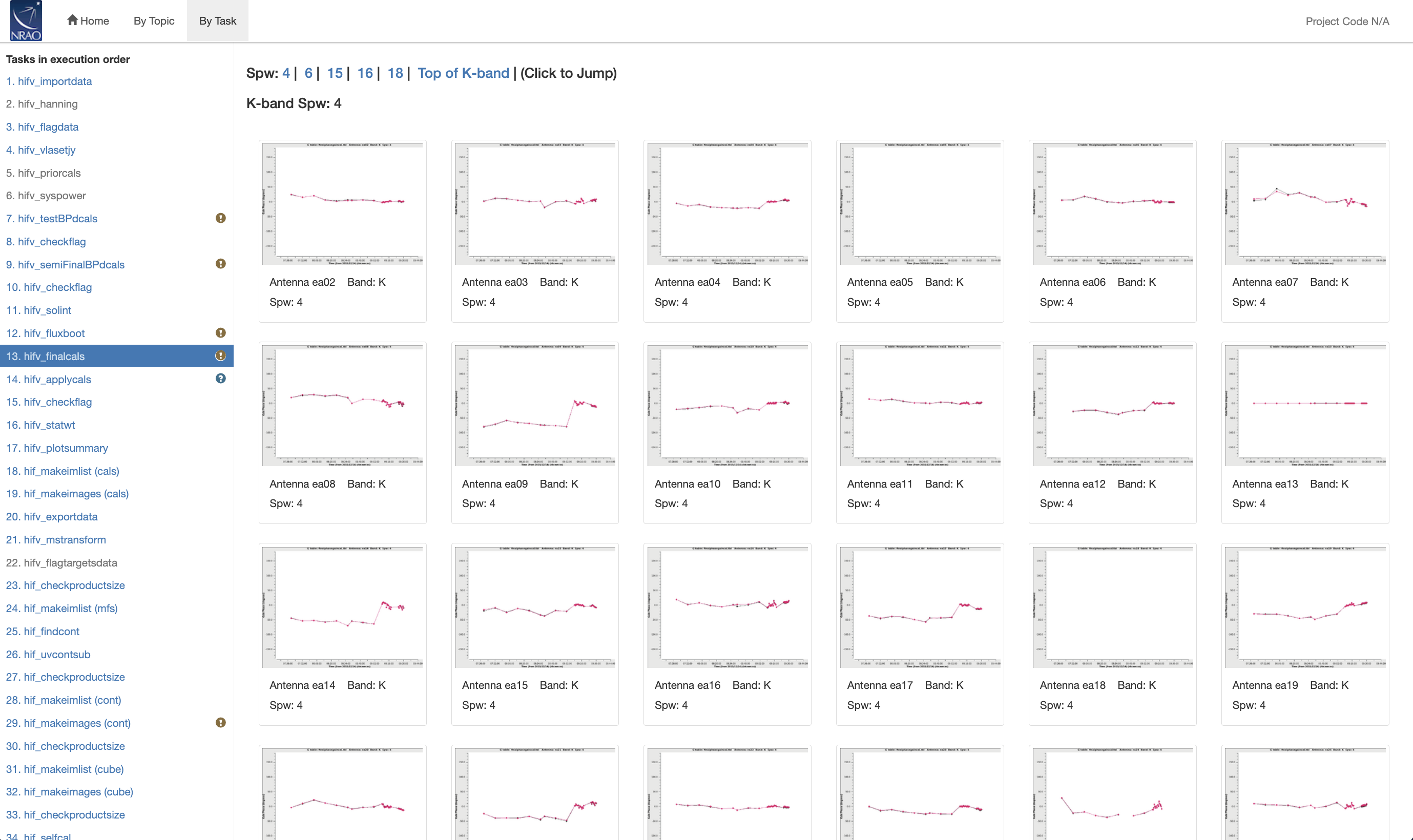 |
Our solutions look pretty good. No major problem is apparent: Delays are small (ea13 is obviously the reference antenna), the short phase solutions took out the smaller scatter or decorrelation, bandpasses are as expected and reasonably flat in the centers of the spectral line spws (the two colors are the LL and RR polarization products), phases are stable and only go up when the sources switch to the bandpass and flux density calibrators (Fig. S13-9), around 9:08 (also see the listobs output on the overview page).
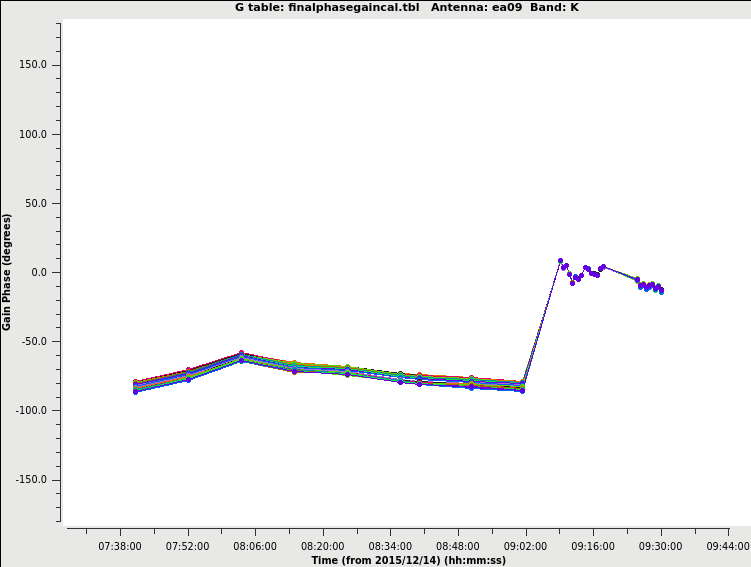 |
Around 8:36, a pointing calibration was performed, and some antennas clearly improved their gains (Fig. S13-10 for ea02 and ea12).
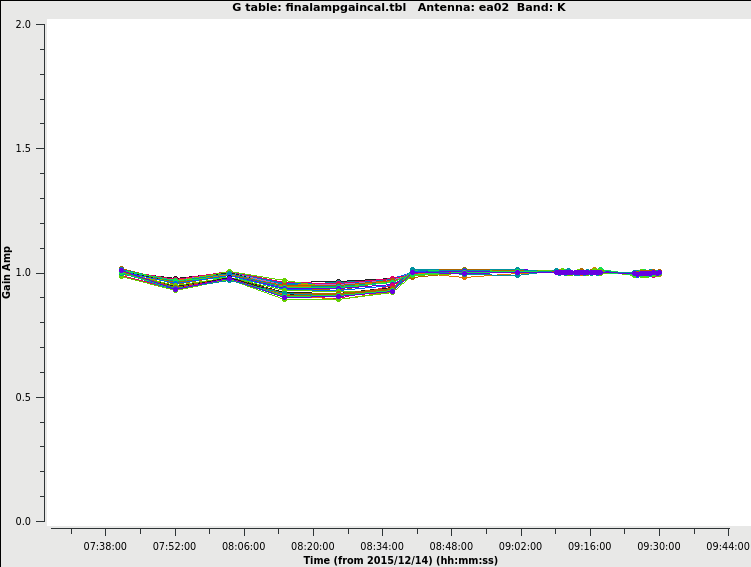 |
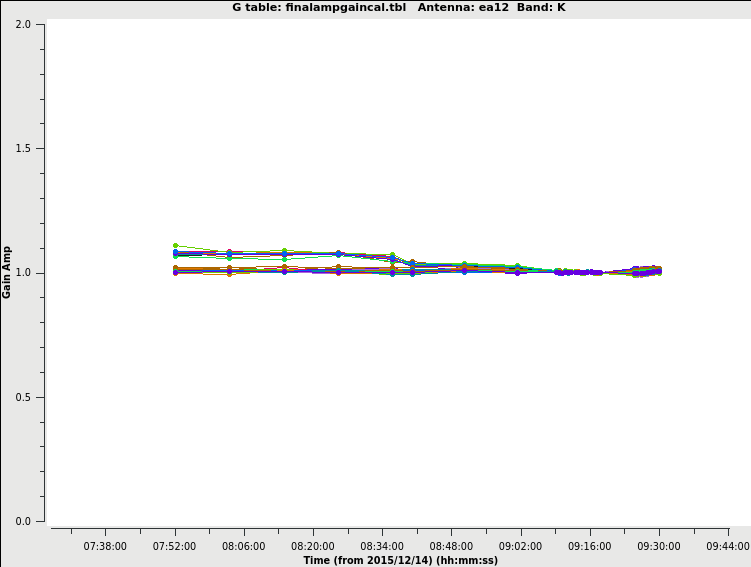 |
Ea06 and ea07 had some spread in the gains at the beginning of the observations. Their +/-0.2 gain variation at the beginning could be looked at in detail (Fig. S13-11) and potentially may require flagging, but it is a fairly modest deviation and only a couple of antennas, which indeed may have this behavior after all, for which we calibrate. It should be fine to keep the data.
 |
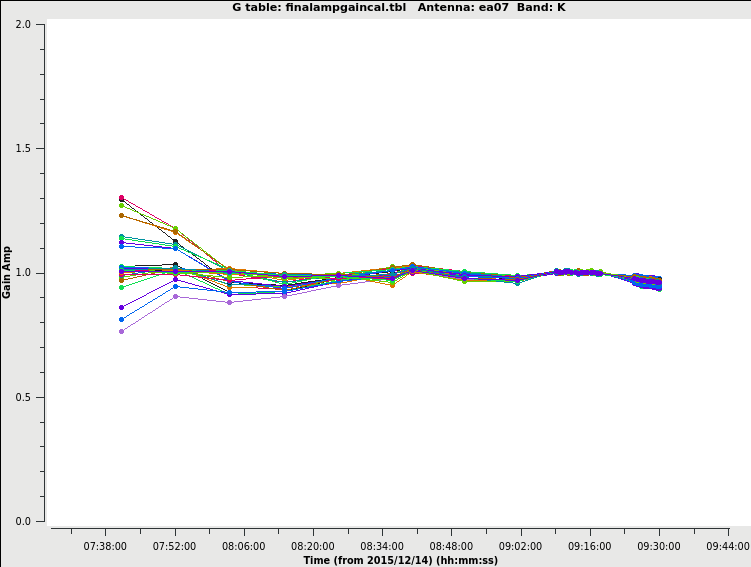 |
CHECK for: strong RFI as well as jumps in phase and/or amplitude away from spectral window edges. If there are phase jumps for all but the reference antenna, maybe a different choice for the reference antenna should be considered. Also watch out for extreme delays of tens of ns and for very noisy data. Note that carefully checking calibrator tables in this stage is of particular importance as they are the final tables that are applied to the target source. Phase (and gain) calibration solutions should be inspected in their temporal variations to be smooth and consistent for each calibrator.
QA: checks are performed for the presence of delay and bandpass solutions for all science spws and antennas. The fraction of failed bandpass solutions changes the score to 0 < score < 1 for 60% < failed solutions < 5%. The score is furthermore reduced by 0.1 for every antenna where delays exceed >200ns.
Stage 14. hifv_applycals: Apply calibrations from context
The calibration itself now concludes with the application of the derived calibration tables to the entire dataset. That includes all calibrators as well as the target sources. Note that there is no system temperature weighting of the calibration tables for the VLA (and the pipeline sets calwt=False in the CASA task applycal) since the switched power/Tsys calibration is currently not used.
In Fig. S14-1, we show the results of this step. The first table lists the calibration tables that are applied, and the fields, spectral windows, and antennas that are calibrated. The table also shows the field and spw mappings that were used as well as the interpolation mode (see applycal for the interpretation). For convenience, the final, actually applied calibration table names are available through the links in the last column. The second table provides information on the flagging statistics. Failed calibration solutions result in flagged calibrator table entries and eventually the data will also be flagged as no calibration can be derived for such data. The '?' in the task page refers to the additional flagging that was applied to the data in this stage.
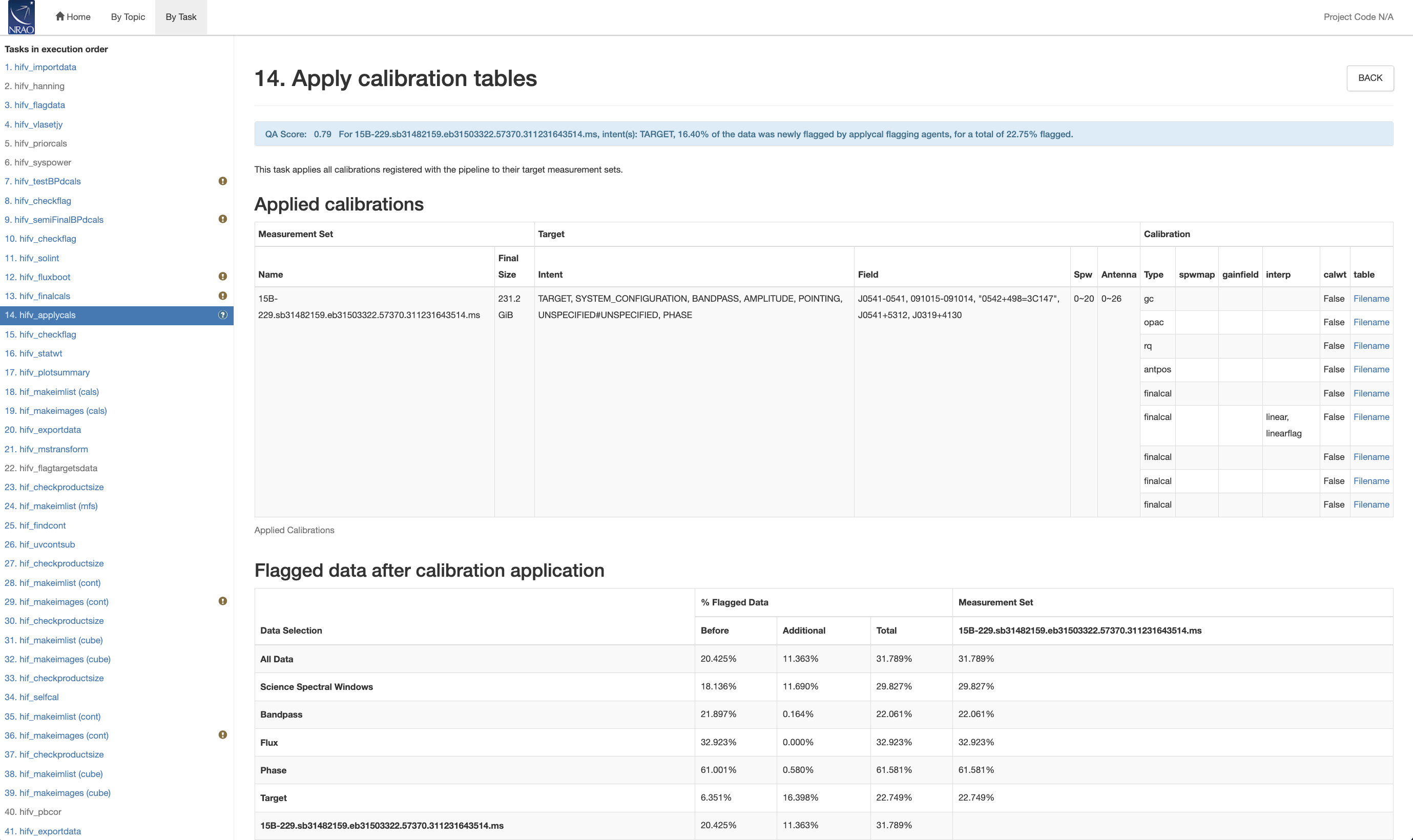 |
Note that this stage also shows the final MS file size after the creation of the additional MODEL and CORRECTED_DATA columns.
CHECK for: reasonable flagging statistics. If the flagging increased dramatically, some calibration tables should be examined for proper solutions.
QA: determined by the percentage of incremental flagging where 0 < score < 1 is the score range for 60% < fraction flagged data < 5%.
Stage 15. hifv_checkflag: Flag RFI on target using rflag
The rflag and tfcrop heuristics are now applied to the target to prepare it for imaging (Fig. S15-1).
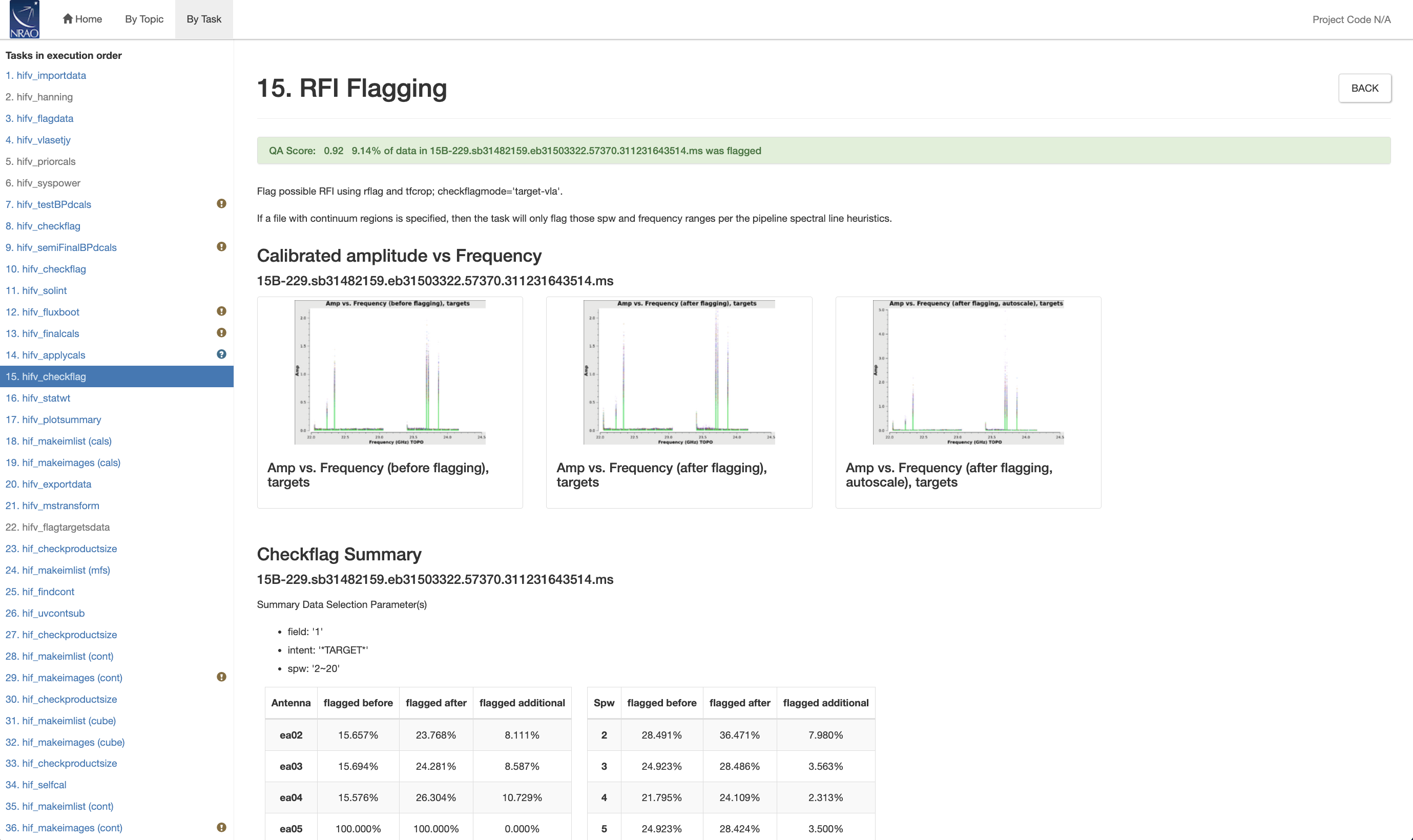 |
CHECK FOR: RFI removal for the target data through the diagnostic plots and data statistics.
QA: determined by the percentage of incremental flagging where 0 < score < 1 is the score range for 60% < fraction flagged data < 5%.
Stage 16. hifv_statwt: Reweighting visibilities
Since the VLA pipeline does not use the switched power calibration in determining data weights, there can be some sensitivity variations of the data over time due to changes in opacity, elevation, temperature (gradients) of the antennas, etc. It is usually advisable to weigh the data according to the inverse of the square of their noise. This is done via the CASA task statwt and will increase the signal-to-noise ratio of images (Fig S16-1a). Statistics for the computed weights, including highlighted outliers are shown on this page (Fig. S16-1b). Data with extreme outliers should be inspected.
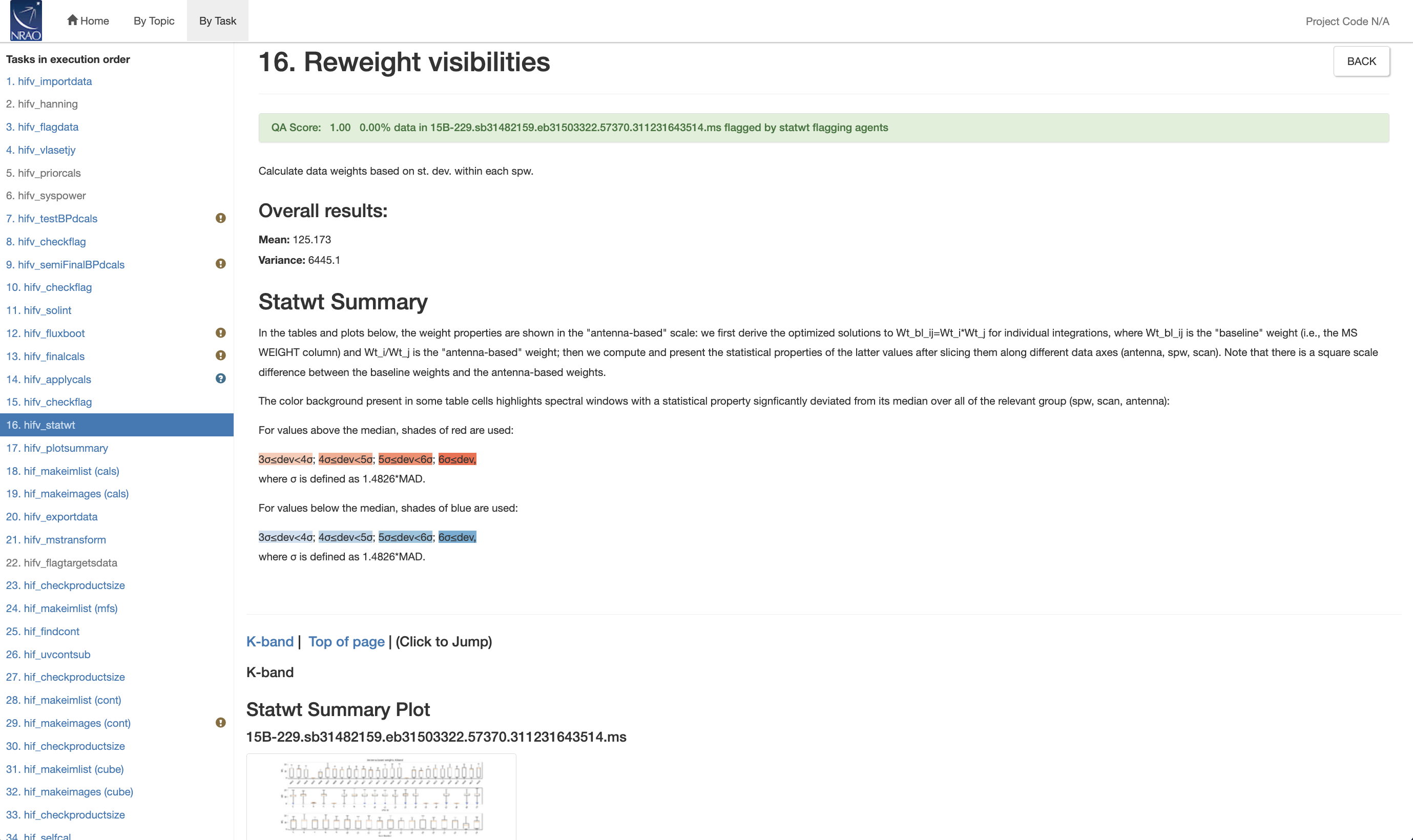 |
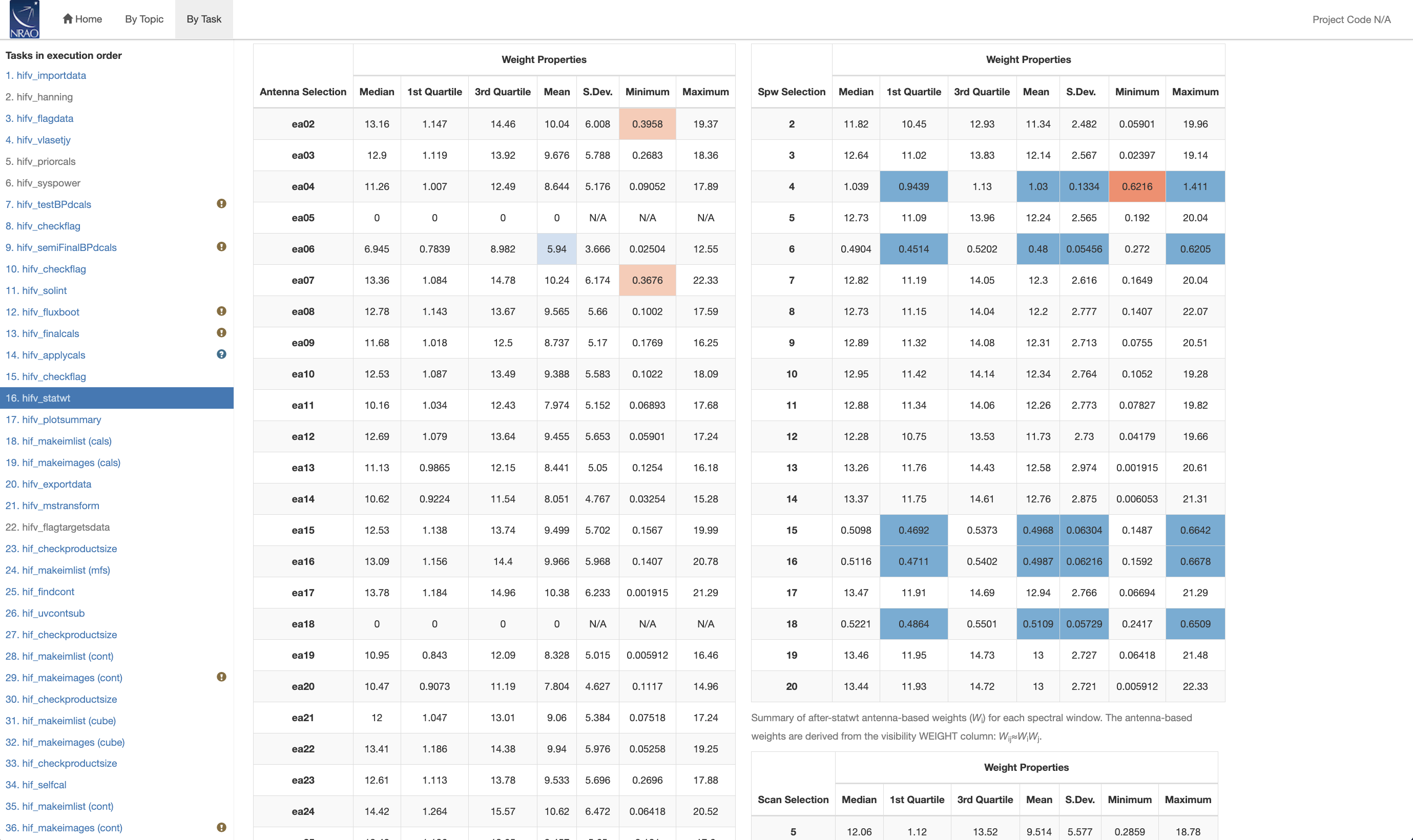 |
As explained in stage 8, flags will be calculated for all data, including spectral line spws, before they are reverted for spectral lines on stage 21 hif_mstransform. Strong spectral lines will therefore be removed for calculating the weights with statwt. The statwt results should therefore represent the correct weights based on noise.
CHECK for: mean and variance of the weights; the variance should be less than the square of the mean. Also: images that are created later should improve in their signal-to-noise.
QA: N/A
Stage 17. hifv_plotsummary: VLA Plot Summary
This task produces diagnostic plots of the final, calibrated data. These include: calibrated phase as a function of time for all calibrators, and amplitudes as a function of UVwave (UVdistance) for all science fields (incl. calibrators; Fig. S17-1); the amplitudes and phases as a function of frequency for the bandpass and phase calibrator(s) colored by antenna (Fig. S17-2); and amplitude against frequency for all science targets, colorized by spw (Fig. S17-3). Phases as a function of time for all cross-hands (RL, LR) of the polarization calibrators would also be displayed on this page if the observations were taken in full polarization (RR, LL, LR, RL).
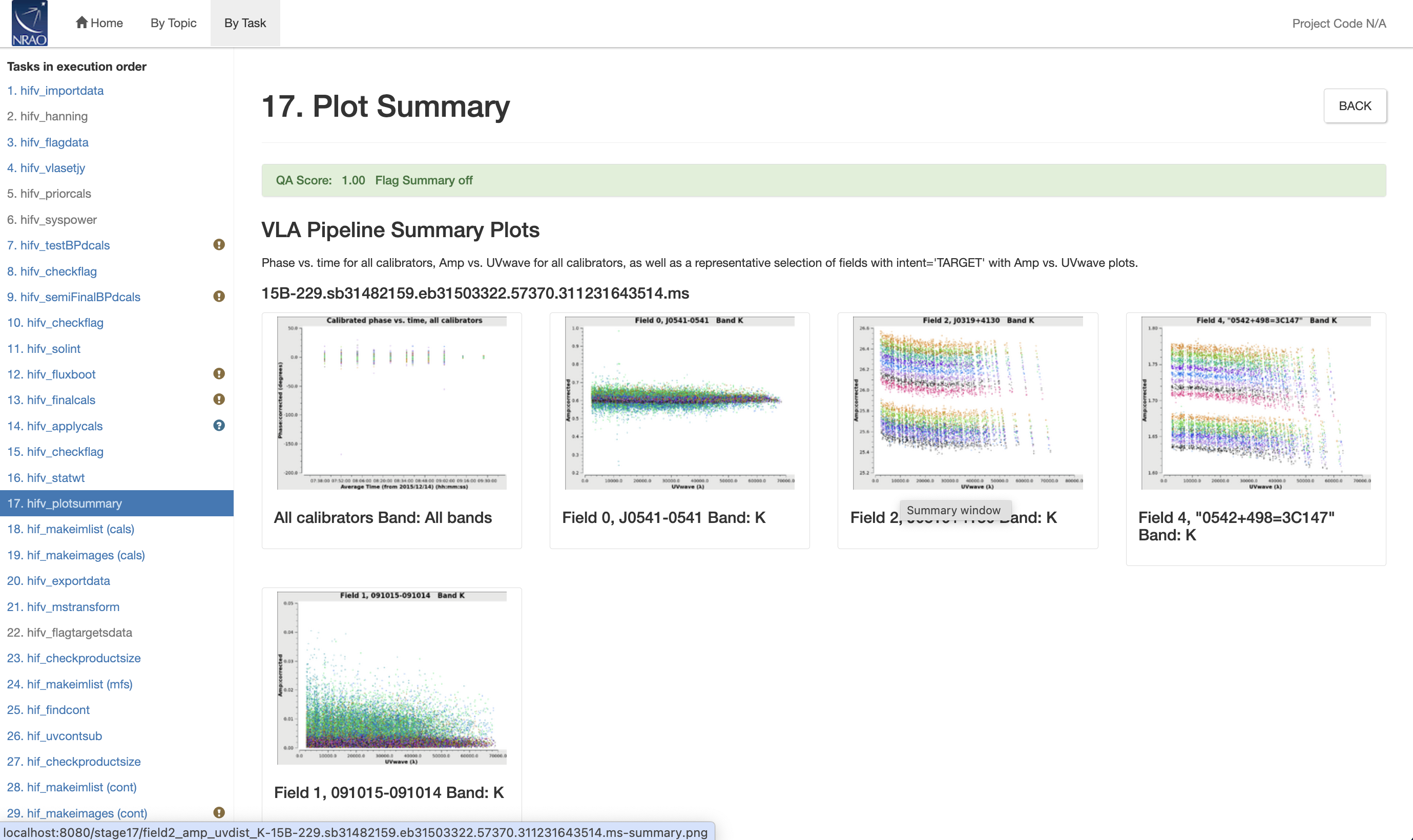 |
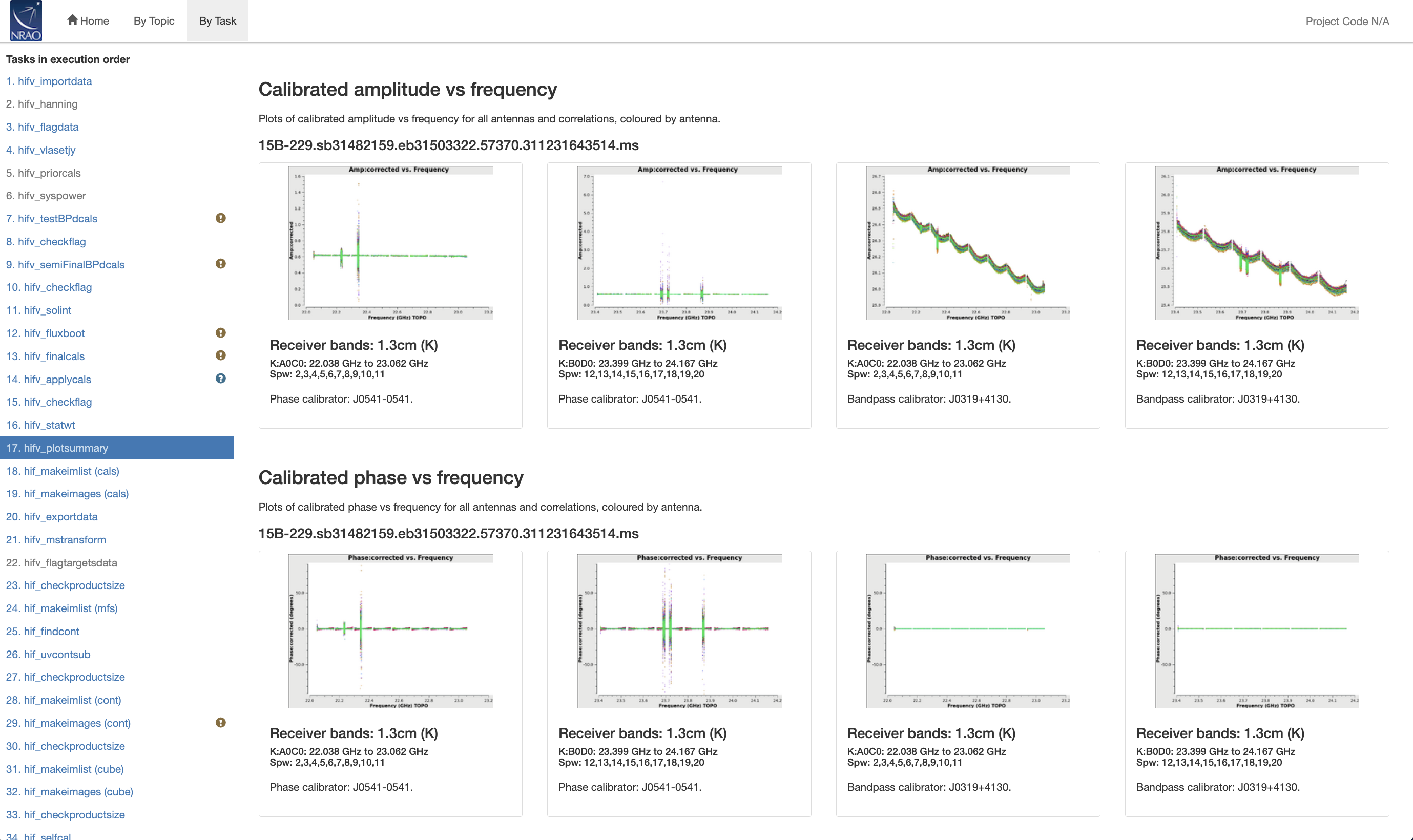 |
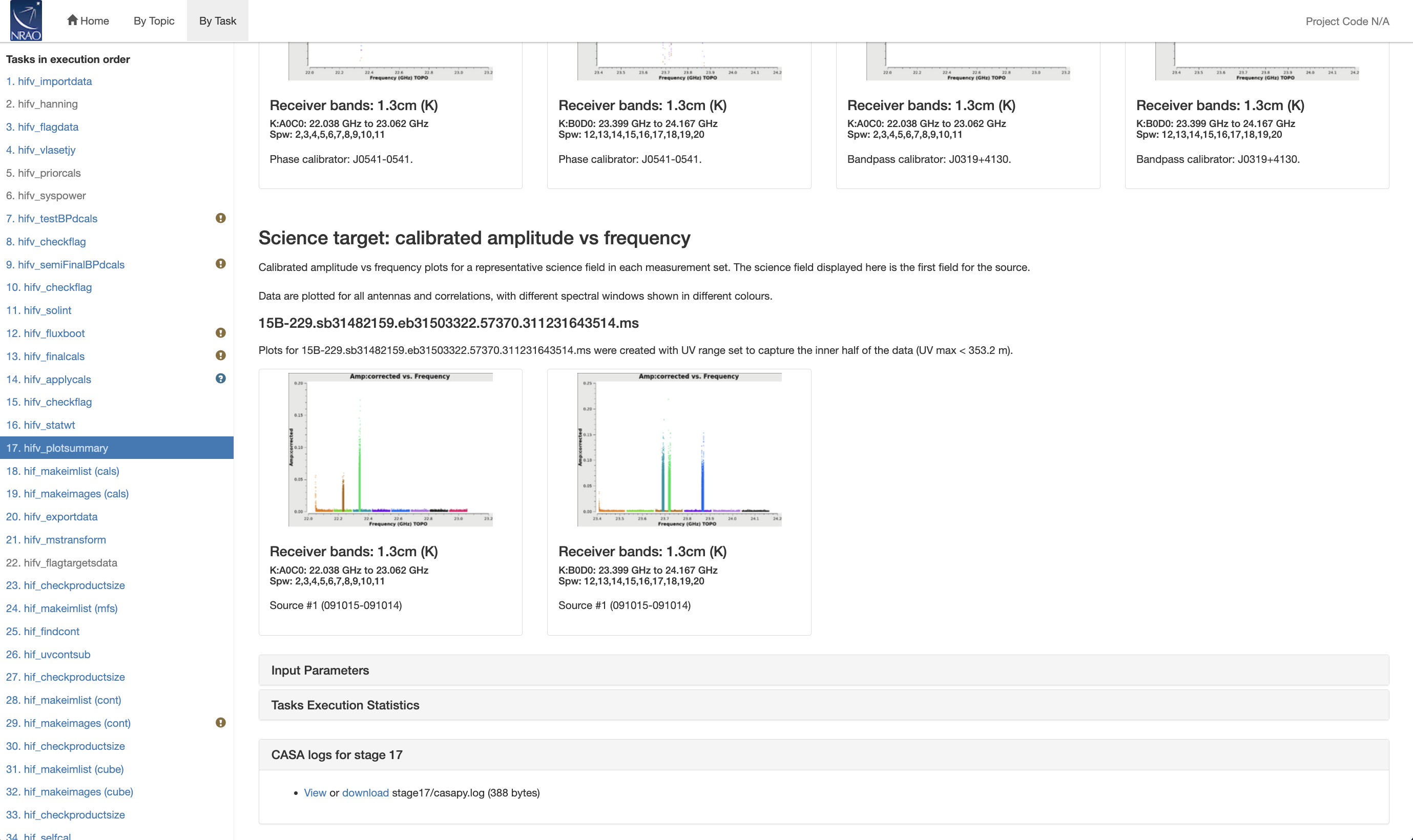 |
The uv-distance plots (Fig. S17-1) of the calibrators show that the complex gain calibrator is fairly point-like (J0541-0541). The bandpass calibrator (J0319+4130) has some extended structure as the increase of amplitudes at short spacing indicates, and the flux calibrator 3C147 is somewhat extended, but this is taken into account at the hifv_vlasetjy stage 4.
The amplitude vs frequency plots (Fig. S17-2) for the complex gain calibrator look good, flat, where the vertical features are again the spectral line spws, which have a somewhat higher rms per channel. The bandpass calibrator has some residual structure and a bit of RFI at the lower frequency. The wave structures come as a side effect of only the phase solutions from the long solution interval being applied to the final calibrator data, but does not affect the bandpass calibration as that is computed using the short solution interval.
The target plots in Fig. S17-3 are more difficult to interpret as they depend on the structure and position of the target source. No strong RFI or other artifacts, however, seem to be present.
CHECK for: outliers, jumps, offsets, and excessive noise.
QA: N/A
Stage 18. hif_makeimlist (cals): Set up parameters for phase calibrator & bandpass calibrator imaging
Finally, to check the calibration, diagnostic calibrator images are made for each receiver frequency band by combining all covered spws for calibrators with a PHASE or BANDPASS intent (note that if no calibrator with a BANDPASS intent is present, the FLUX calibrator will be used). For each image, this stage calculates basic imaging parameters such as pixel resolution (cell size) and image sizes (cf. Fig. S18-1), that are used for the imaging in the subsequent step. Note that all images are produced in the ICRF reference system (which is also the ALMA standard; ICRS this is very close to but not identical to J2000)
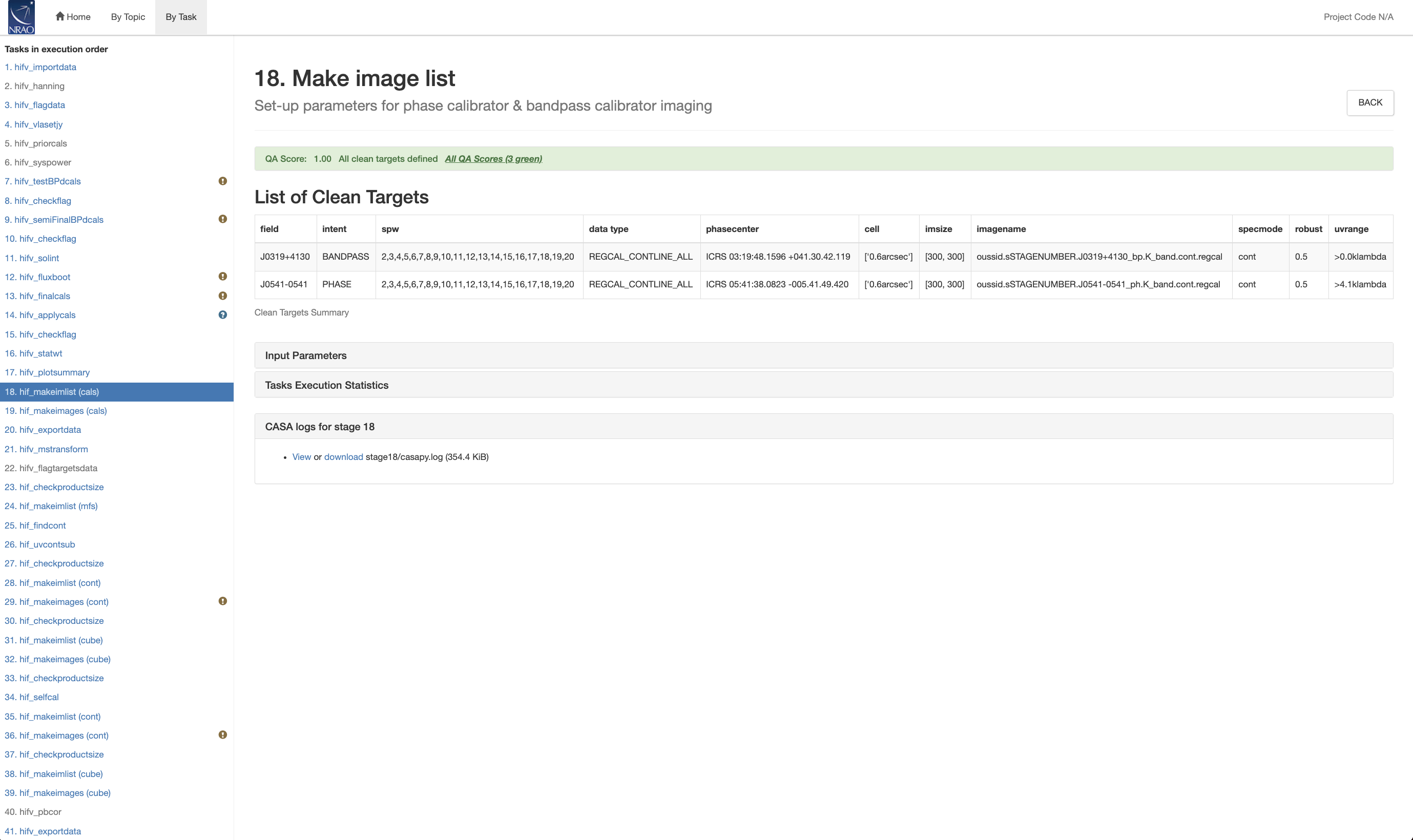 |
CHECK for: appropriate cell size for the images.
QA: N/A
Stage 19. hif_makeimages (cals): Make calibrator images
Based on the information from the previous hif_makeimlist stage, the calibrator continuum images are now created by invoking the CASA task tclean and made available in the directory in which the pipeline was executed (usually where the SDM is located). Images are produced for each receiver frequency band using the multi-frequency synthesis algorithm, i.e. in continuum mode corrected for spectral dependencies using the stretched uv-coverage as sampled by the observed channel frequencies.
Image properties are provided for each image (Fig. S19-1). They contain beam characteristics as well as image statistics.
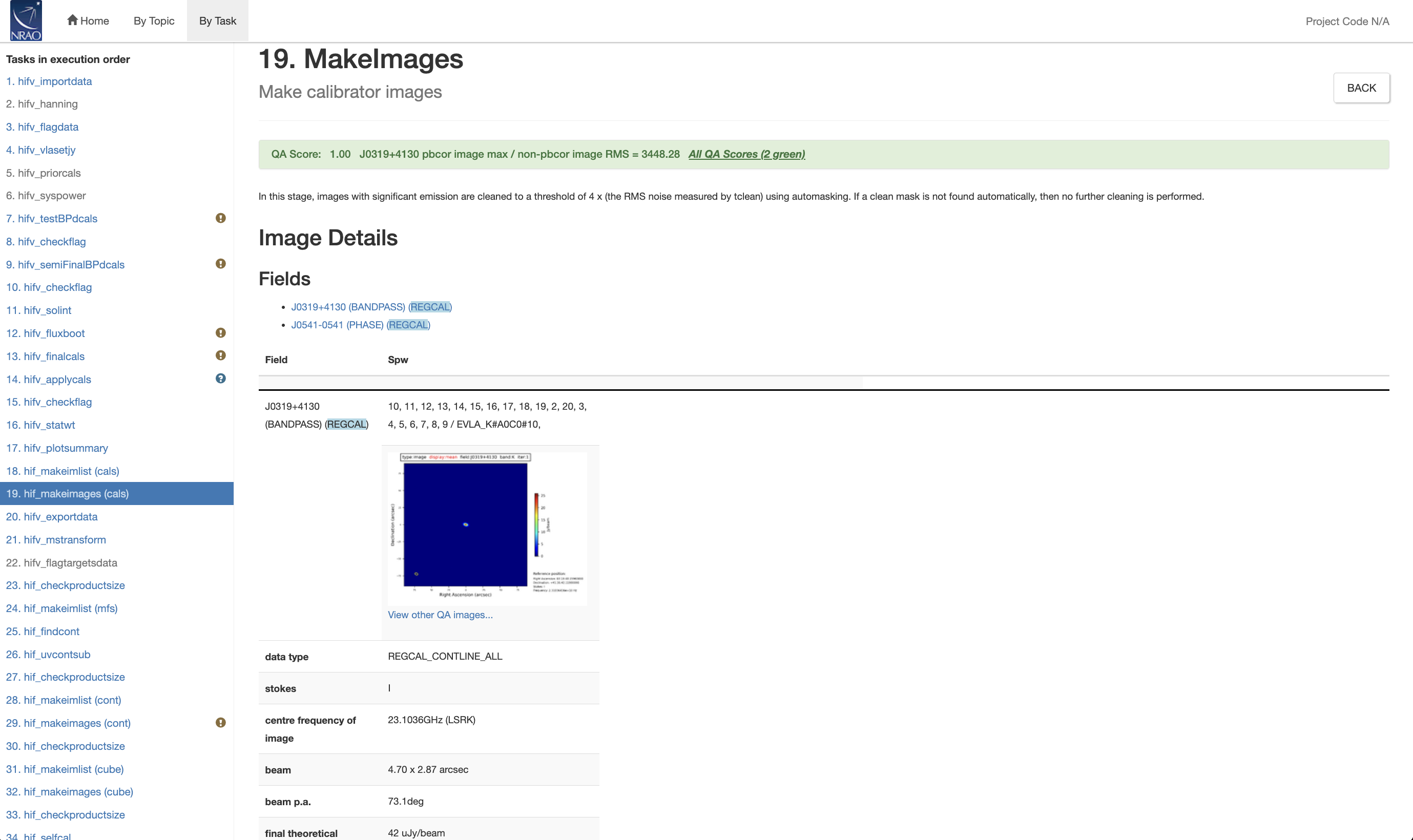 |
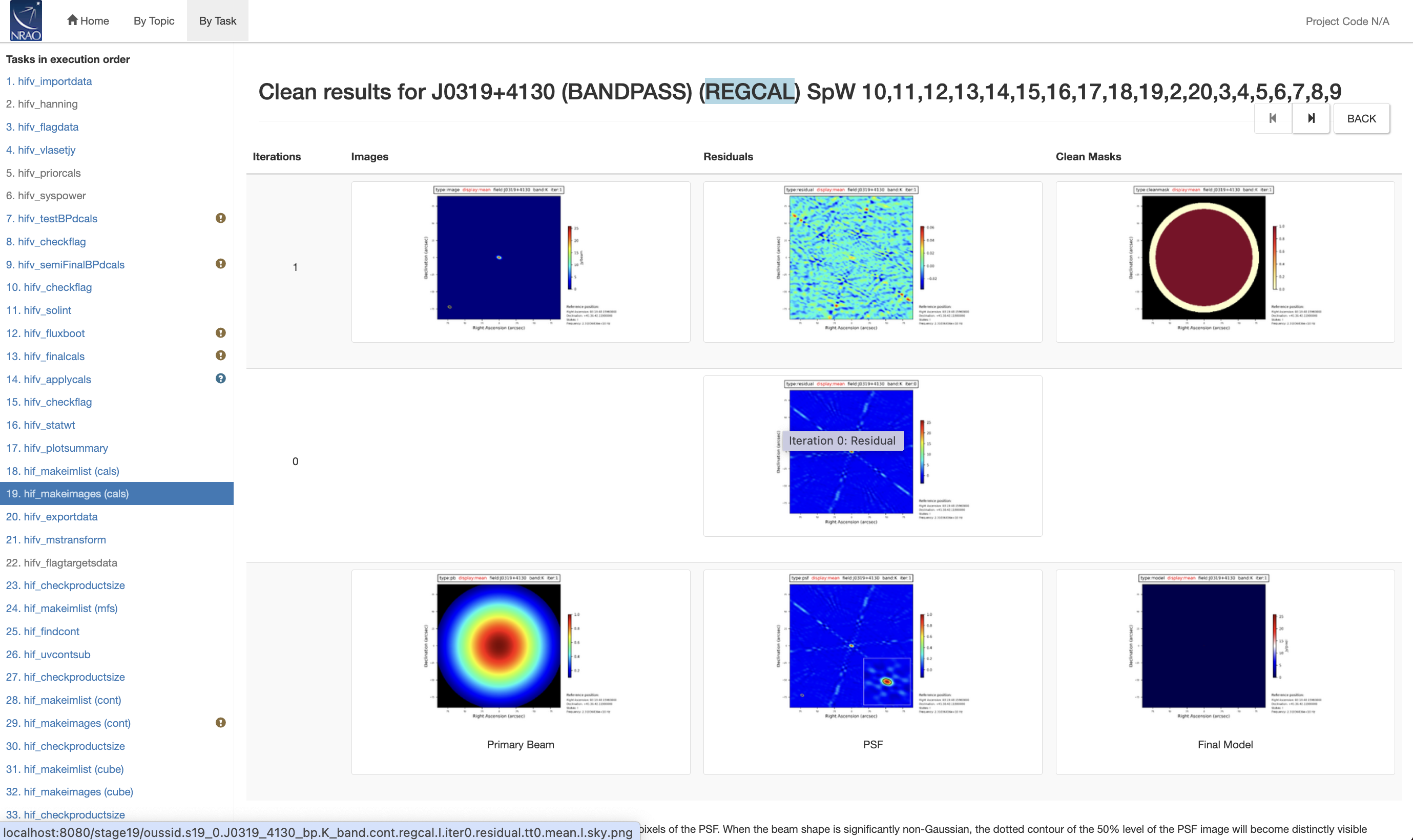 |
The full range of tclean products can be accessed by the link under the images: "View other QA images...". For the first field, an example is given in Fig. S19-2. The cleaning is performed in two stages, where the first stage is simply a dirty image, and the next iteration starts the actual deconvolution. For each iteration, the image and the residual are shown, together with a clean mask (here, the truncated primary beam). Other images on this page include the primary beam, the psf, and the final model.
This step concludes the calibration pipeline.
CHECK for: degraded images, strong ripples, calibrators that do not resemble the point spread function (psf). Such images may indicate RFI or mis-calibrated sources.
QA: a linear score between 0 to 1 is assigned for signal to noise ratios between 5 and 100.
Stage 20. hif_exportdata: Create data products to be archived.
This stage is only shown for data that were run through the NRAO production pipeline and will usually not show up during manual execution of the pipeline. It provides information on the data products that will be available in the archive. Weblogs and calibration files are bundled and zipped in addition to the flags (Fig. S20-1). Images are converted to FITS format. More information on the files and the restoration process is provided on the VLA pipeline homepage. If this task is present, it typically writes the products into the "../products" directory.
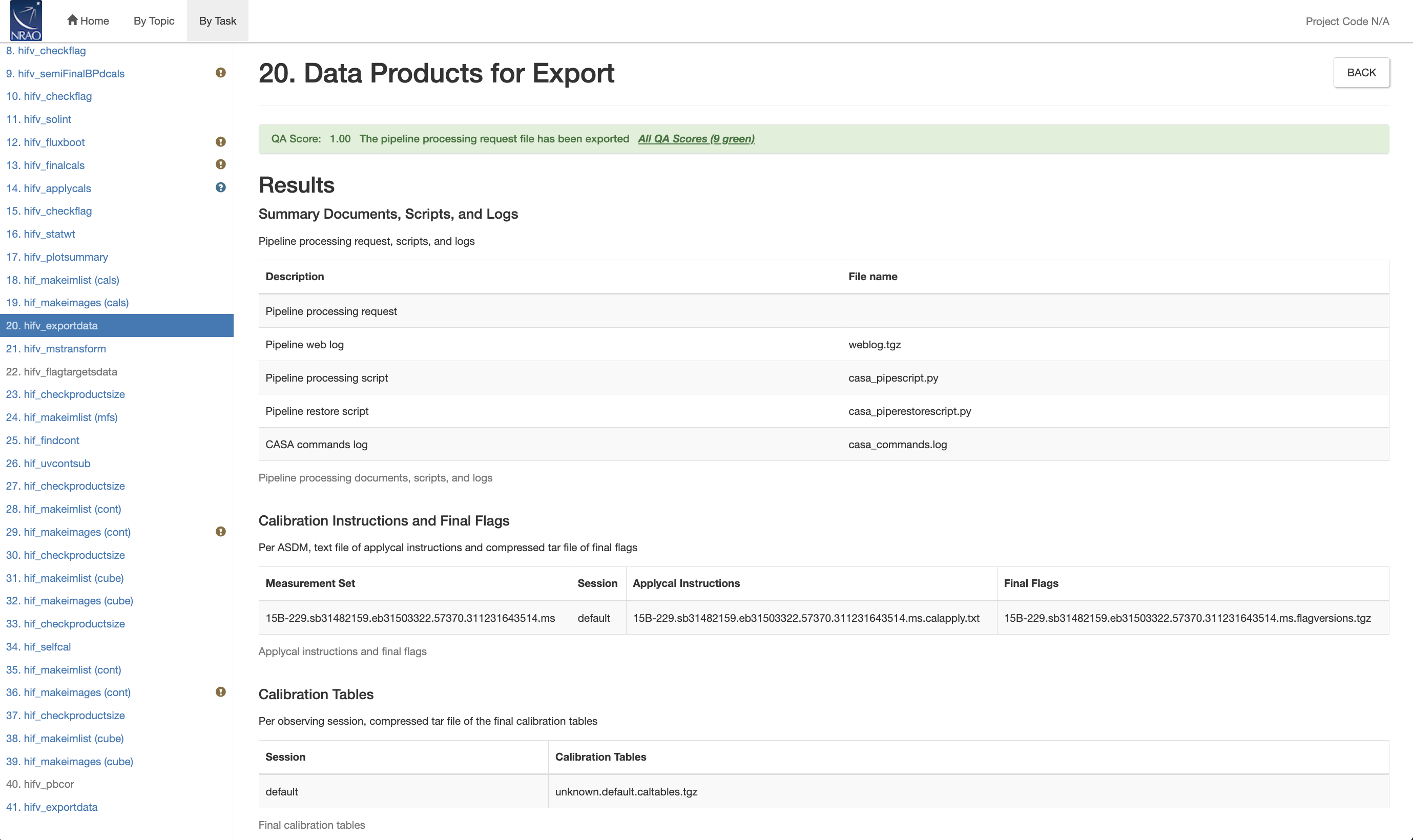 |
CHECK for: the generation of all the final products.
QA: N/A
Stage 21. hif_mstransform: Create MS for imaging.
This stage is the first step of the target imaging pipeline part. All 'TARGET' scans are extracted from the parent MS and written into a new MS (Fig. 37). In addition, spws that are identified as continuum or spectral line are separated into different files, too. At this stage, all flags that were applied to the target source spectral line spws from stage 8 hifv_checkflag and onward will be removed (the calibrators are expected to not contain spectral lines in any spws and the flags will be retained). Spectral line spws therefore should have the correct weights but will not have any flagging beyond those derived in hifv_flagdata and the ones that were applied through the calibration. Additional flags can be inserted for the target in the following stage 22 via a flag template.
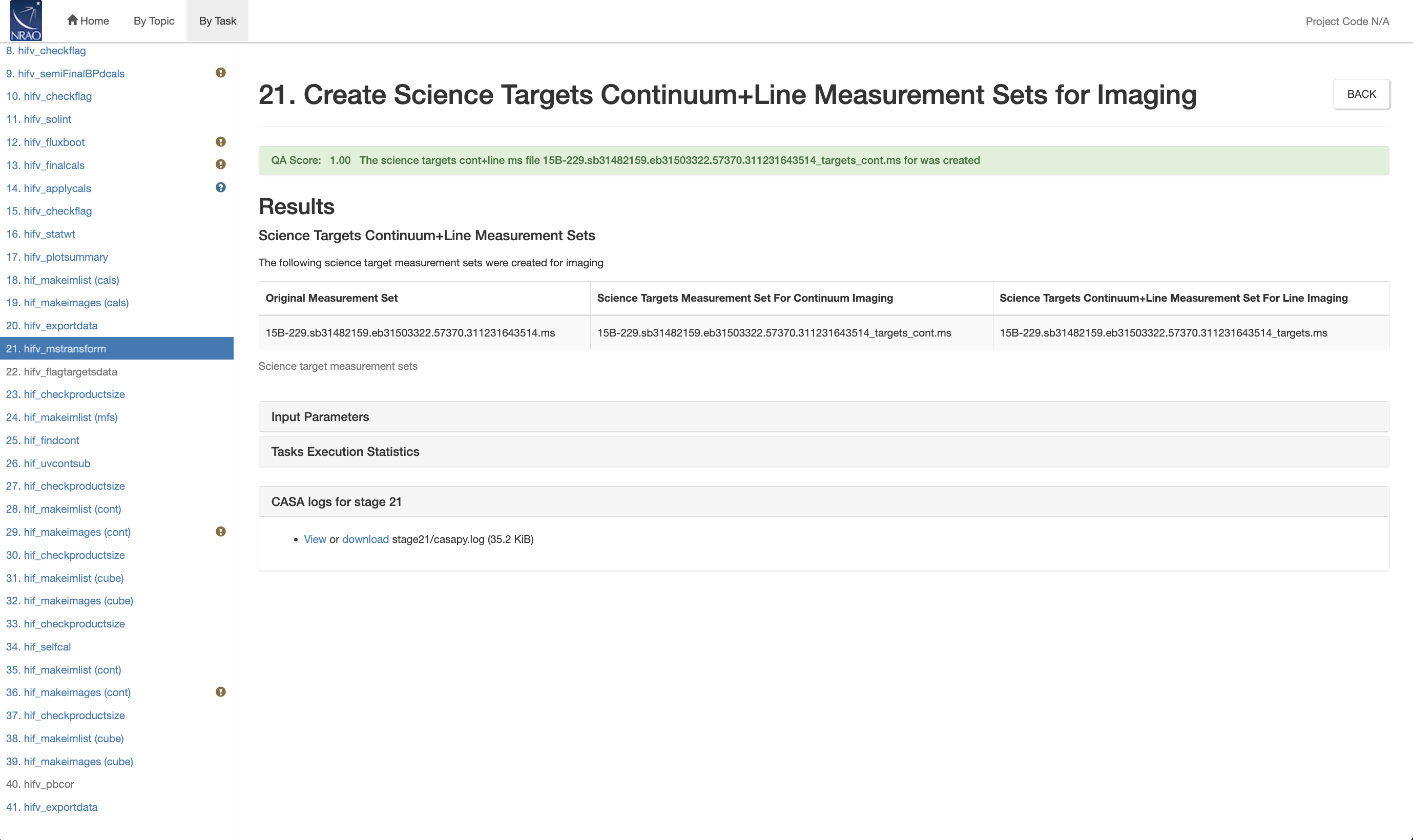 |
CHECK for: Separation of the correct spectral line and continuum spws. Make sure the flags are reverted for spectral line spws.
QA: The QA score is 1.0 if the new MS is created, otherwise 0.
Stage 22. hifv_flagtargetsdata: Flag the target
The pipeline is now attempting to flag the targets via templates that can be provided if the automatic flagging is not sufficient (cf. the VLA pipeline page). But for a regular run they are empty and not used (Fig. S22-1a). The page also provides a summary of the flags before and after flagging (Fig. S22-1b), which in our case shows no additional flags.
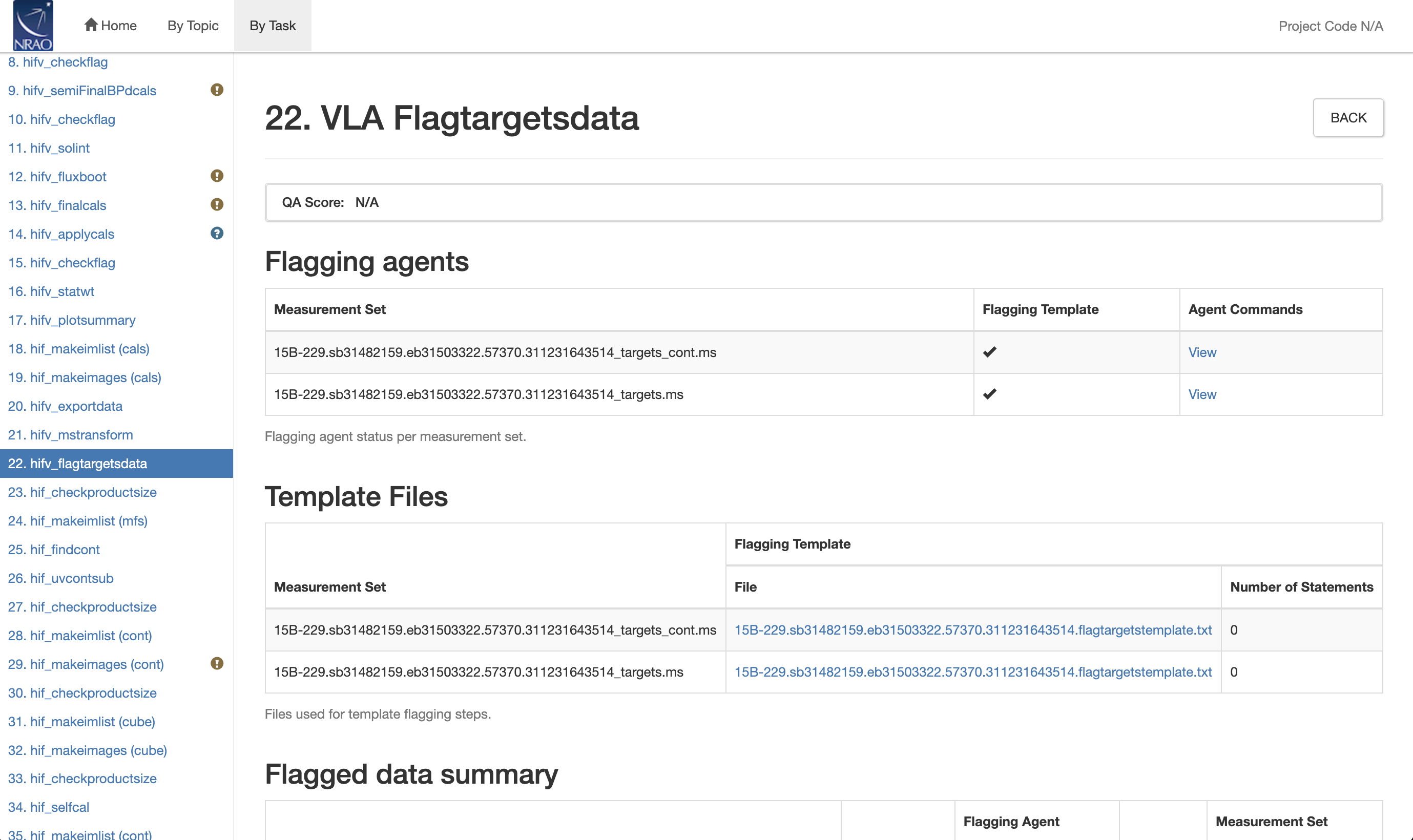 |
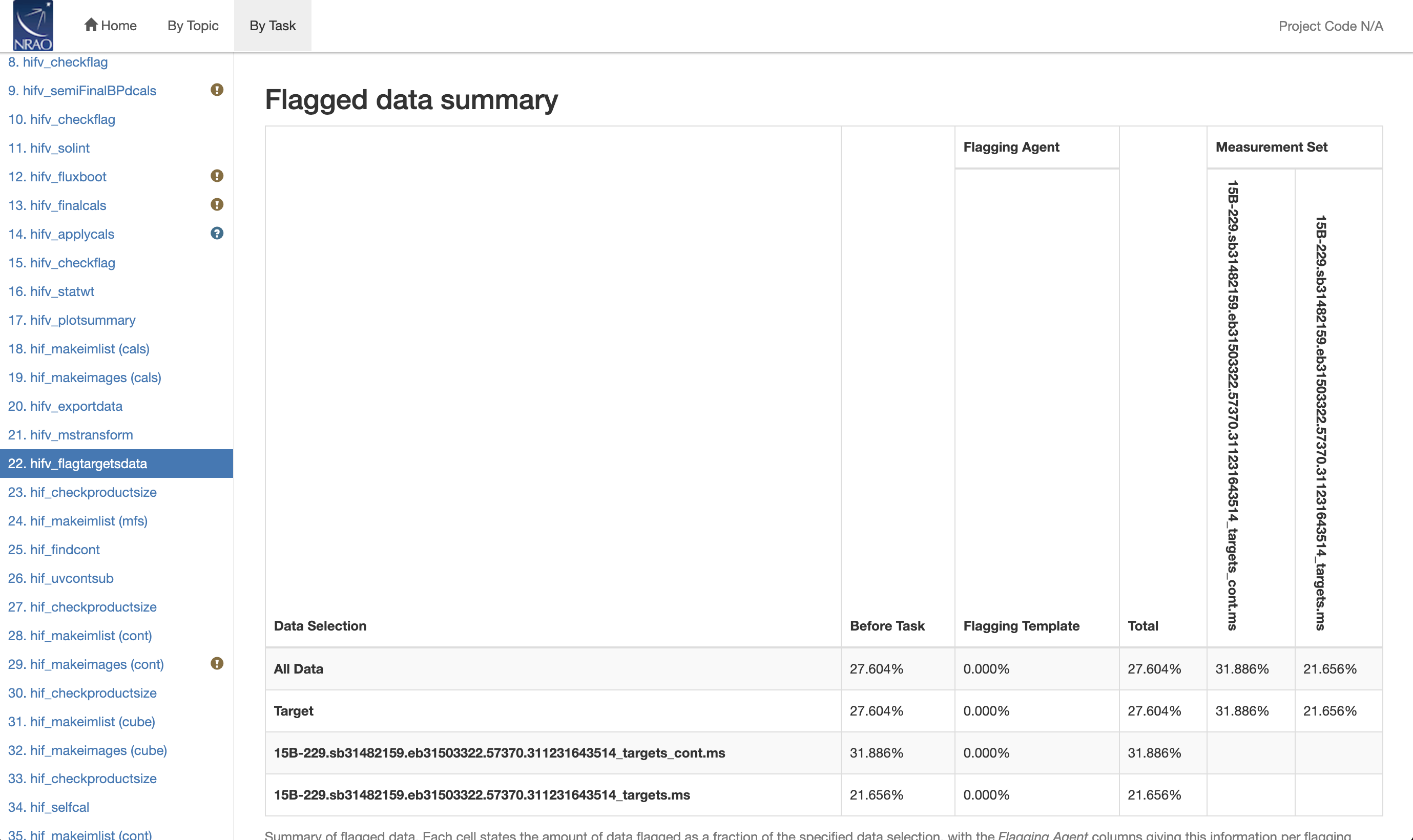 |
CHECK for: application of the provided flag templates.
QA: N/A
Stage 23. hif_checkproductsize: Check Product Size.
The hif_checkproductsize steps are in the pipeline to compute the sizes of images, which depend on spectral resolution, array configuration, and frequency. Some thresholds and mitigation are in place such that the images are still suitable for the NRAO archive (for more information, see the ALMA pipeline User's Guide which explains all thresholds and heuristics for mitigation). This step, here, is for cubes that are needed for hif_findcont.
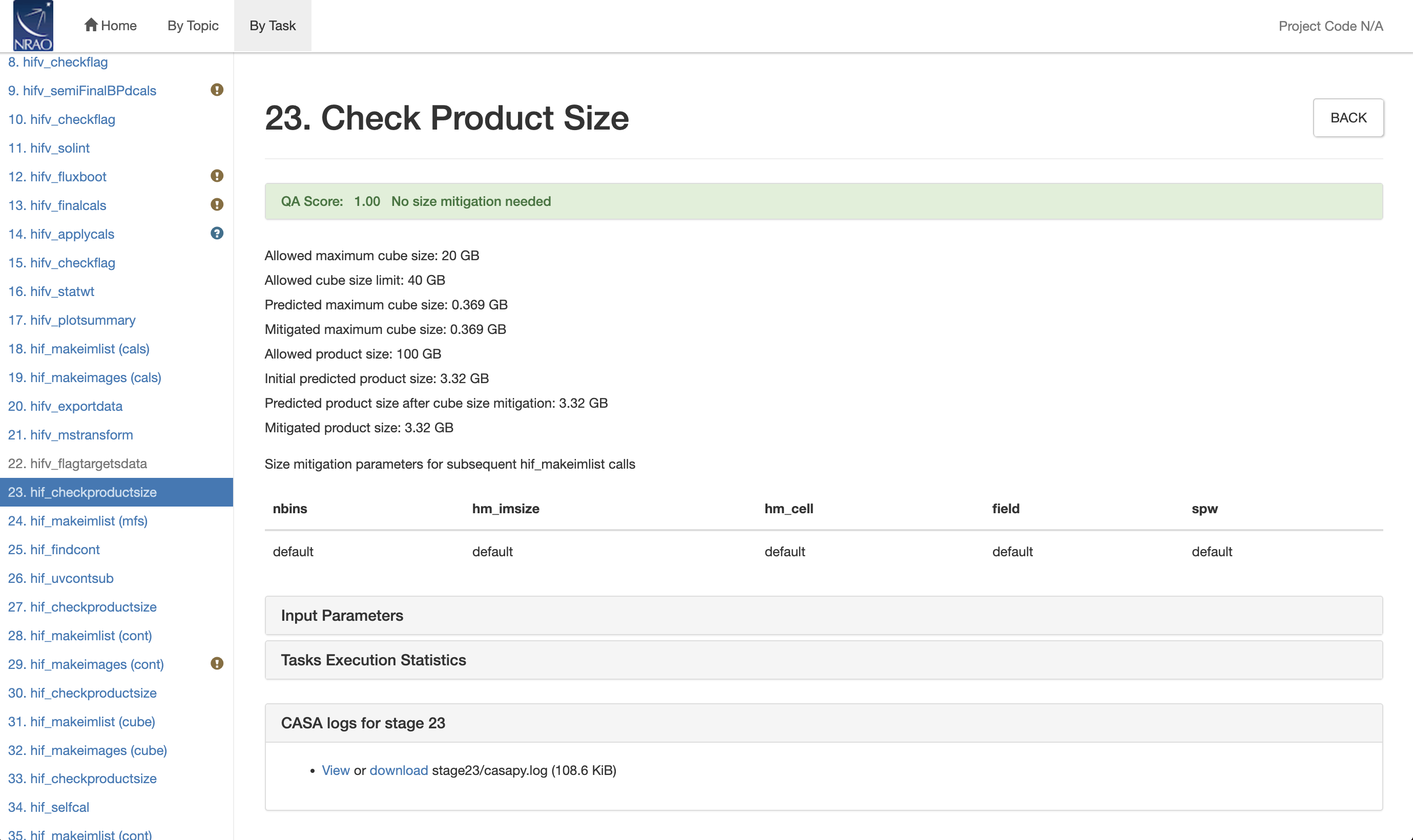 |
CHECK for: Mitigation of images.
QA: The QA scoring for this stage is 1.0 if there was no mitigation, 0.85 if mitigation was performed, or 0.0 if an error was encountered.
Stage 24. hif_makeimlist (mfs): Make image list; Set up cube parameters for findcont
If the data are continuum only and no spectral line spws are identified, this step will be present but labeled "N/A".
If the previous stage had limitations in the imaging parameters, they will now be used here. Otherwise, this stage itself is setting the parameters for the list of targets that will be imaged as spectral line cubes (now: including line and continuum); (Fig. S24-1). This stage specifically only sets up the imaging that is required for the following hif_findcont stage.
The image size aims to cover the inner primary beam for Ku and higher frequency and intends to reach the second null for X-band and lower (to include potential, bright sources that may still throw sidelobes into the main image). For A-configuration, though, images may be restricted by the 16384x16384 limit. Note that VLA Pipeline imaging only uses the standard gridder and is currently not applying special gridders like widefield or (a)w-projection.
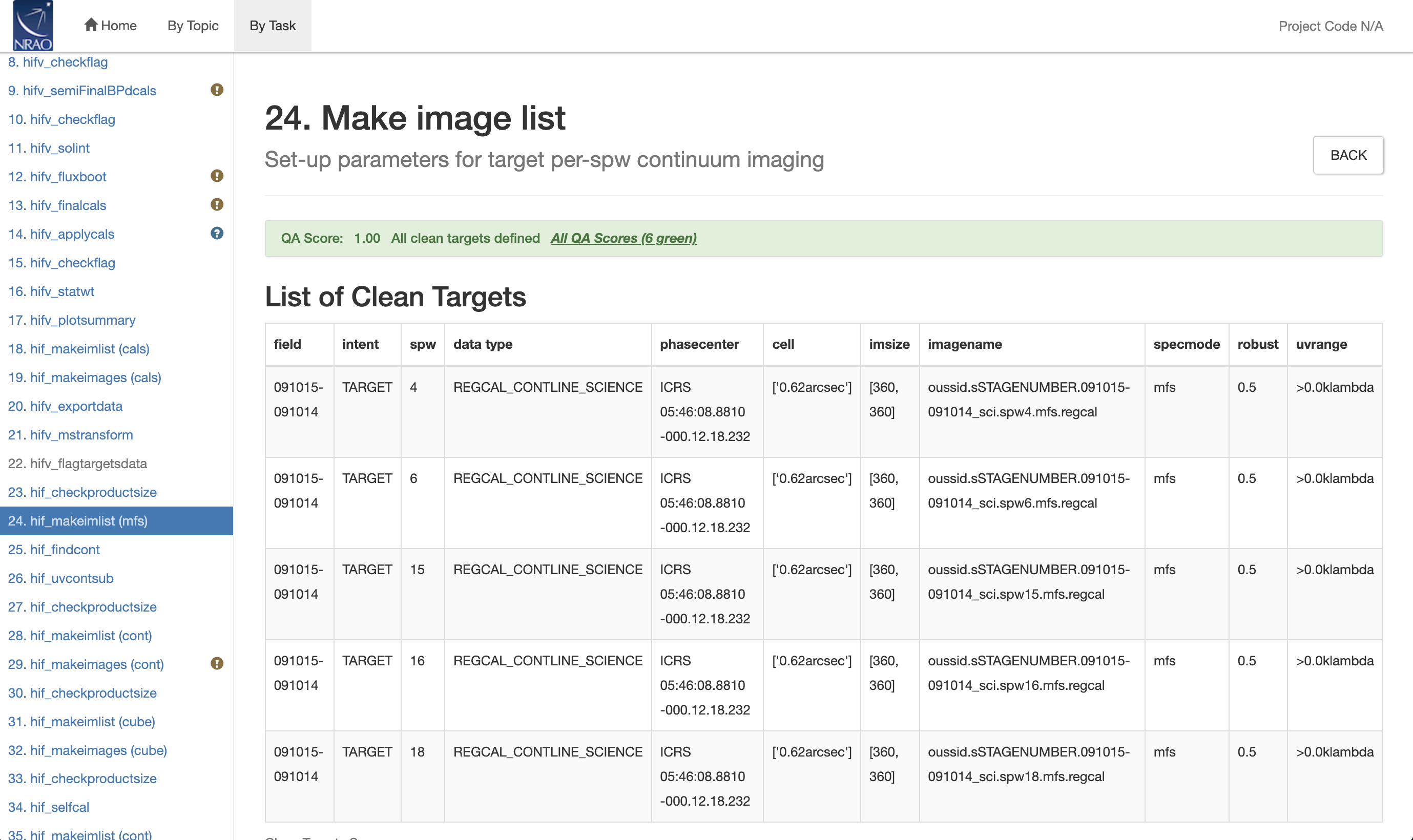 |
CHECK for: appropriate cell size for the images.
QA: The QA score is set equal to the fraction of the images in the imaging list compared to the total number expected.
Stage 25. hif_findcont: Find Continuum Channels in Spectral Line spws
If the data are continuum only and no spectral line spws are identified, this step will be present but labeled "N/A".
In the next step, the pipeline tries to identify the continuum channels in the spectral line windows. The ALMA findcont algorithm is used for this purposes: intermittent continuum+line cubes (specified in the previous step) are imaged, then the emission is masked (cf. Fig. S25-1, right). A spectrum is then taken per cube for these masked regions. Using this spectrum, thresholds are calculated for continuum detection. E.g. in Fig. S25-2, the blue line indicates the derived continuum-only channels. The emission around channel 220 is clearly a line, near channel 320 could be a line but may also simply be noise. The feature at the lowest channels is also not identified as continuum but is likely a bandpass artifact.
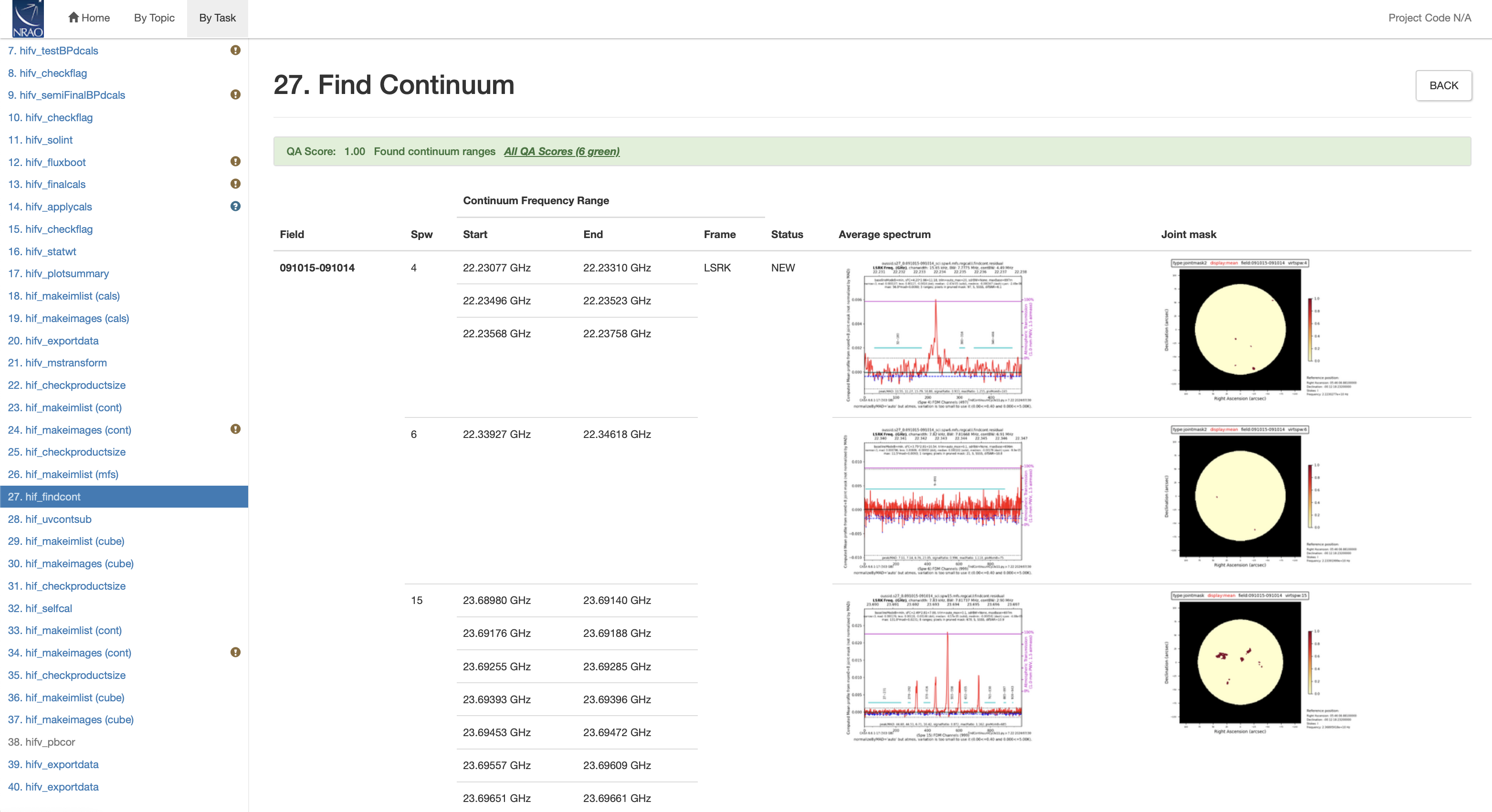 |
 |
For more information, see the ALMA pipeline User's Guide.
CHECK for: Appropriate detection of continuum channels. Lines, artifacts, RFI, etc. should not be included in the continuum channels.
QA: The QA for this stage is 1.0 if continuum frequency ranges were found for all spws, otherwise it is set equal to the fraction of spws for which a continuum range was identified, unless size mitigation fails, in which case the score is set to 0.0.
Stage 26. hif_uvcontsub: Fit and Subtract UV Continuum Model
If the data are continuum only and no spectral line spws are identified, this step will be present but labeled "N/A".
Following the identification of the continuum channels in the spectral line spws, the pipeline now uses that information to fit and subtract the continuum from the visibilities. The task uses CASA's uvcontsub task and typically fits a first order polynomial through the continuum channels. When the continuum channel distribution is very lopsided, the task will revert to 0th order. The residual will be treated as line-only data (even though some artifacts may still be present).
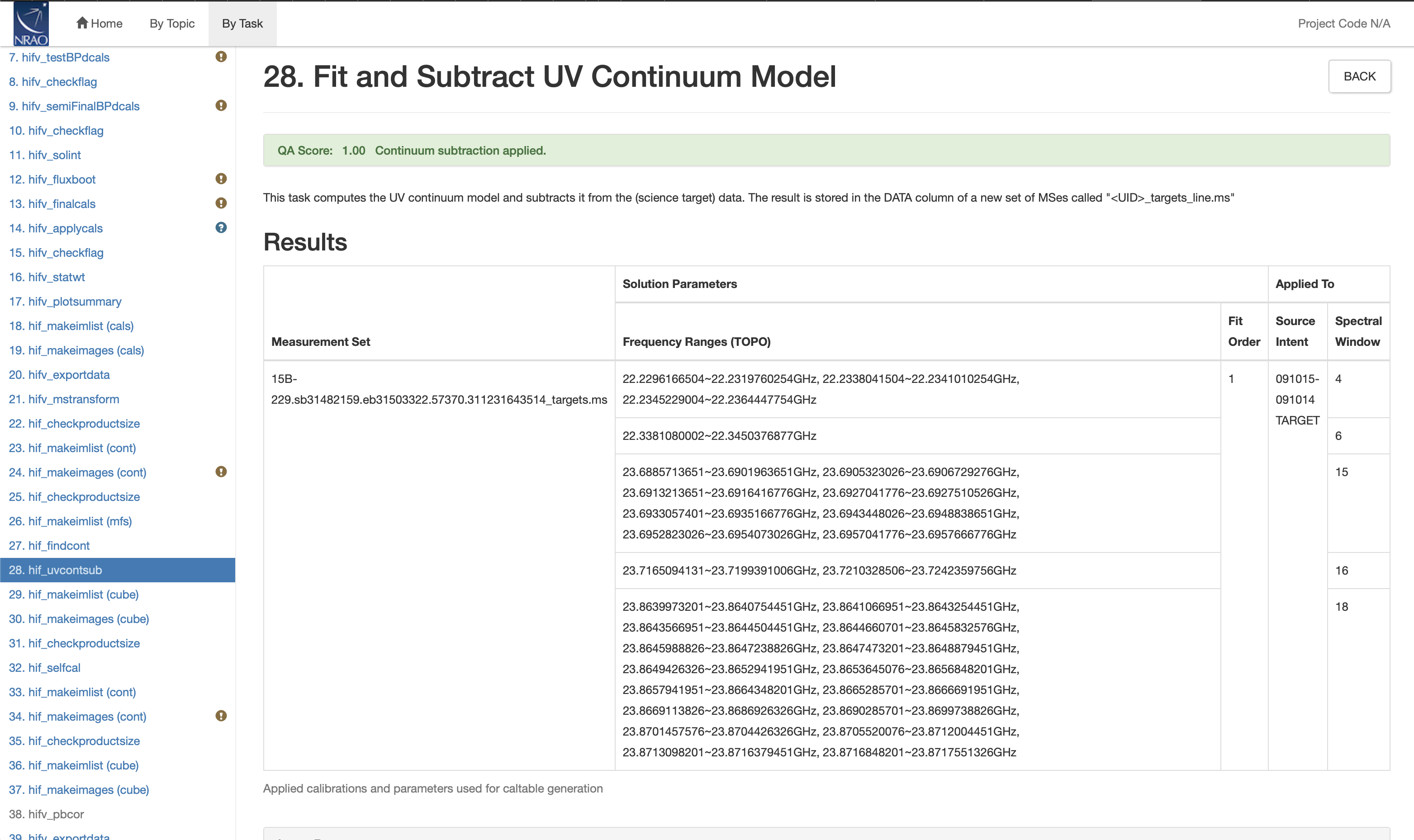 |
CHECK for: later, after imaging, check if the continuum subtraction looks reasonable.
QA: The QA score is 1.0 if a continuum fit table was created, otherwise 0.
Stage 27. hif_checkproductsize: Check Product Size: Continuum
This step calculates and potentially mitigates the size for the continuum images (see also stage 23).
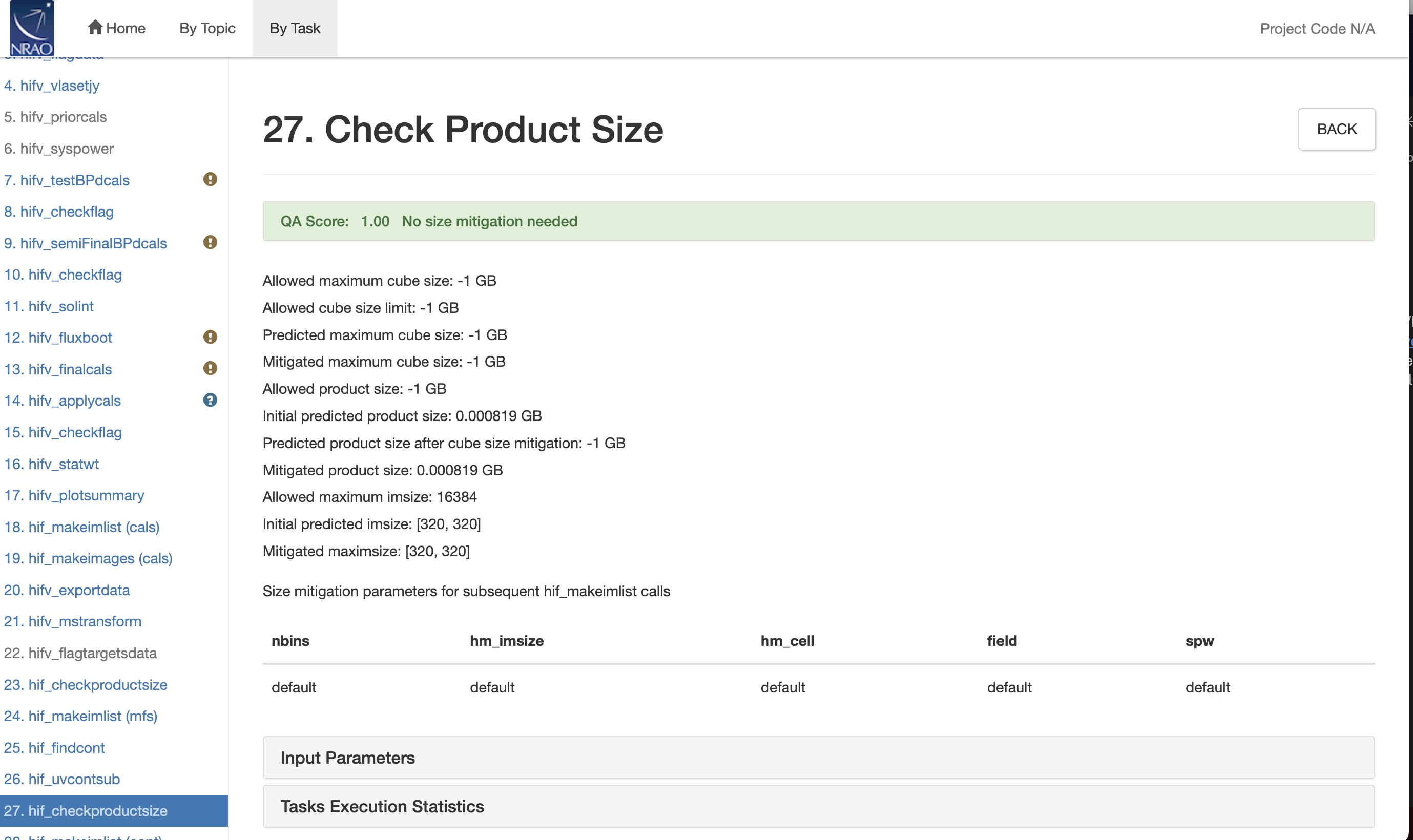 |
CHECK for: Mitigation of images.
QA: The QA scoring for this stage is 1.0 if there was no mitigation, 0.85 if mitigation was performed, or 0.0 if an error was encountered.
Stage 28. hif_makeimlist (cont): Make image list; Set-up parameters for continuum imaging
This makeimlist stage is to make a single continuum image for all continuum data, including continuum spws and identified continuum channels in spectral line spws (Fig. S28-1).
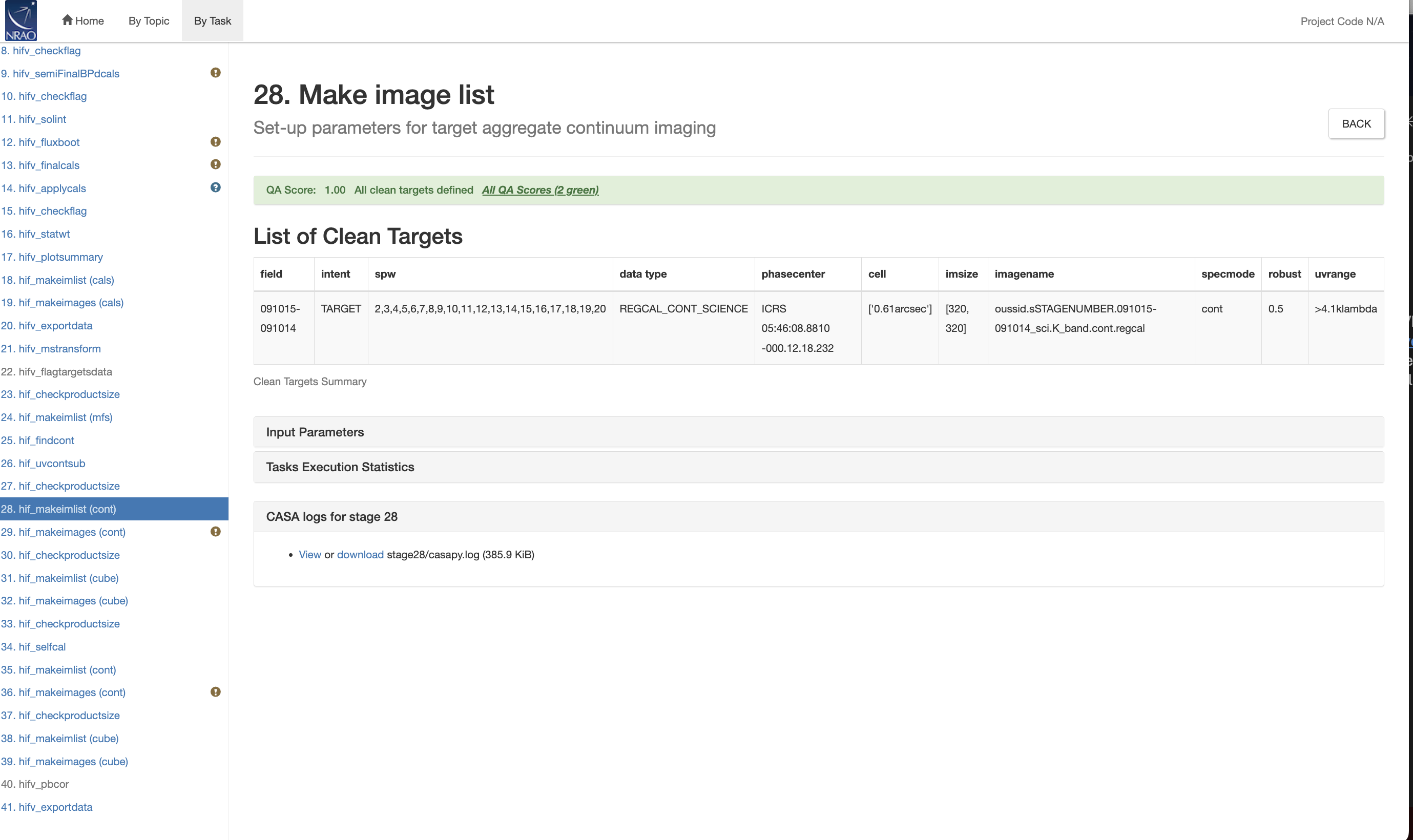 |
CHECK for: appropriate cell size for the images.
QA: The QA score is set equal to the fraction of the images in the imaging list compared to the total number expected.
Stage 29. hif_makeimages (cont): MakeImages; Make Continuum Images
The target images are now created by CASA's tclean based on the previously determined imaging parameters. Image statistics and properties are provided here (Fig. S29-1). Additional imaging products are also available, similar to those in stage 19. Since the images are more complex, there are three stages now. The 0th stage is the creation of the dirty image, and the two subsequent stages include automasking procedures at two different cleaning depths (Fig. S29-2).
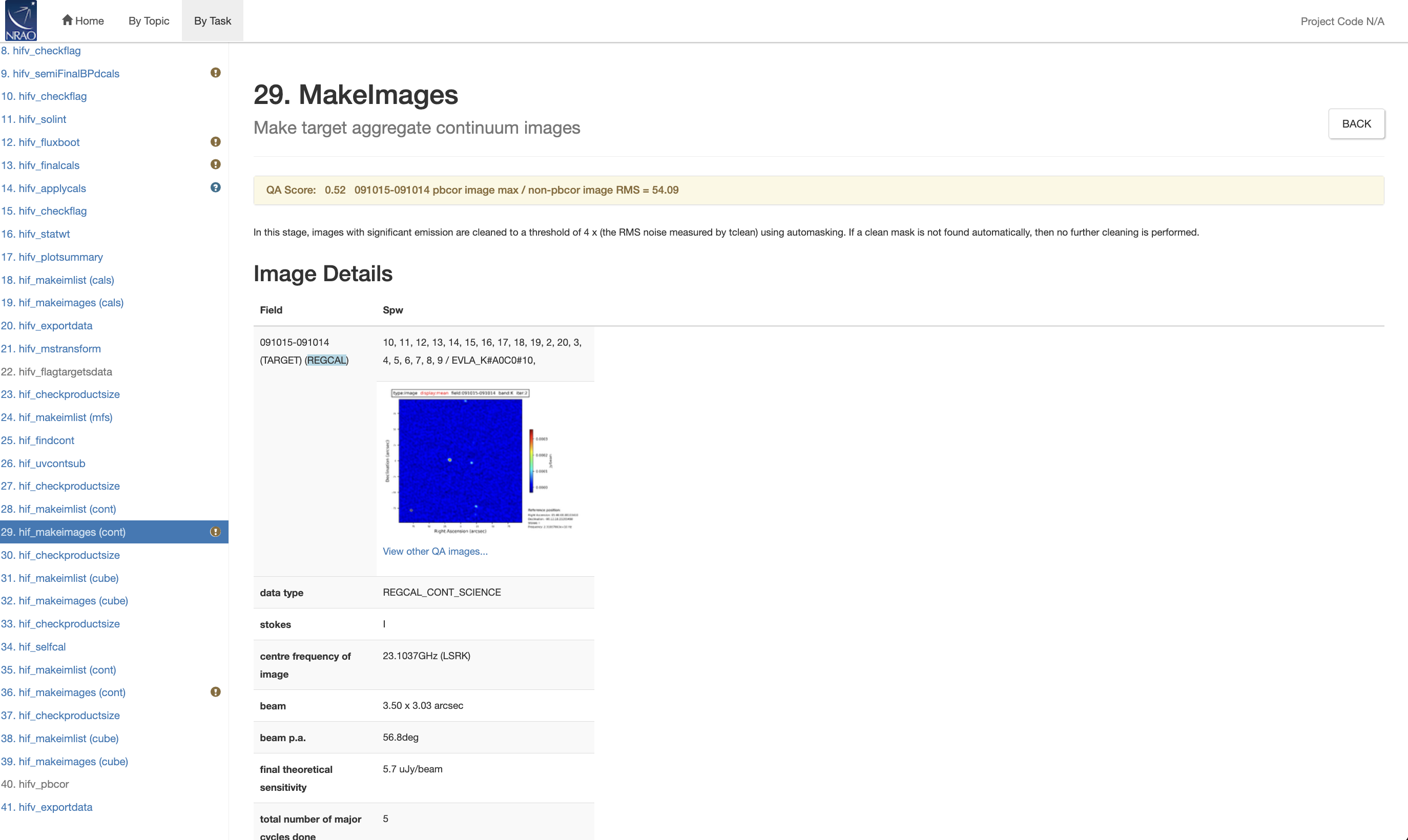 |
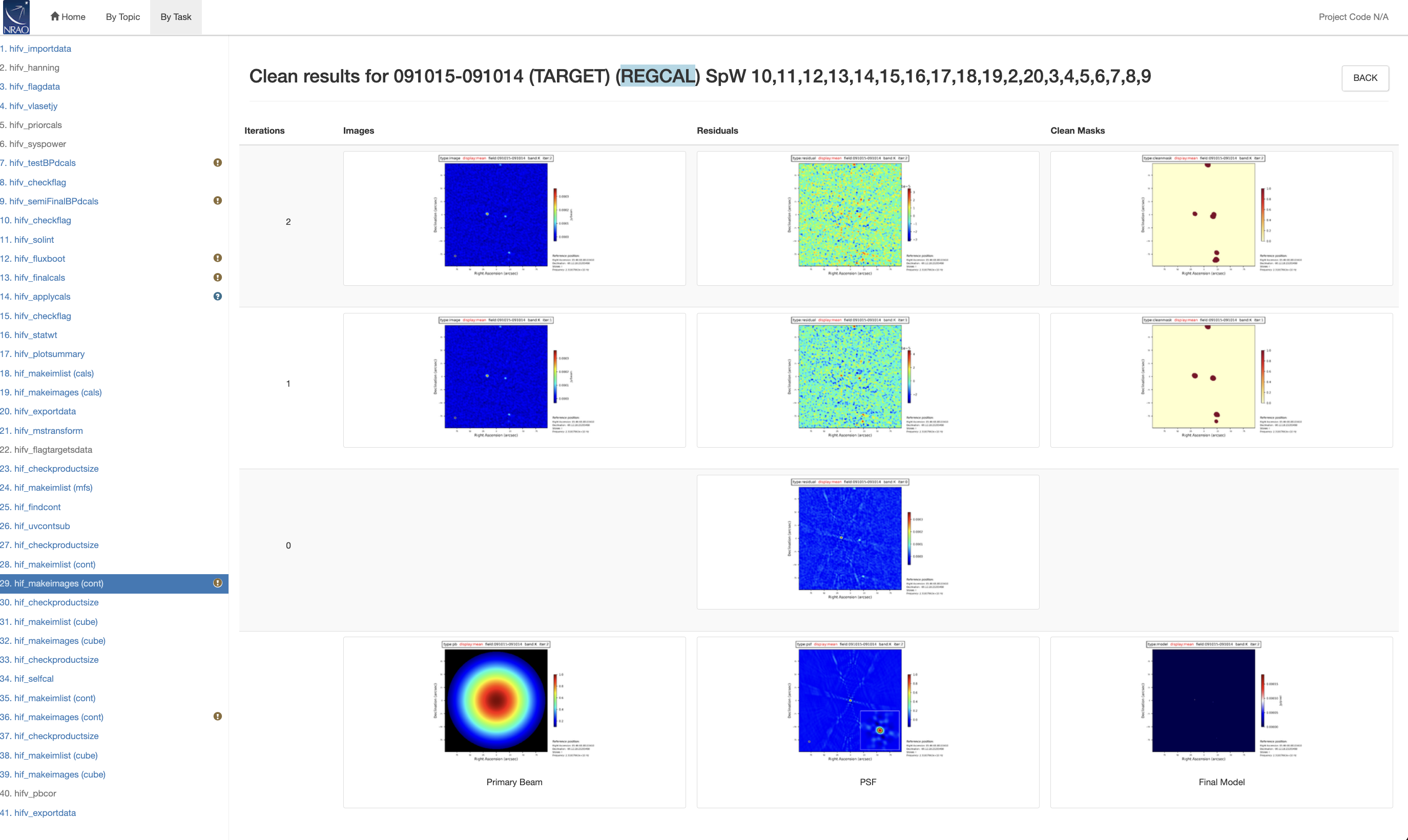 |
CHECK for: Image artifacts, missing short spacings, not fully deconvolved sources etc. Compare the theoretical noise with the actually achieved one. The science target may be faint and not well shown in the weblog images. On the other hand, stronger sources can amplify problems such as divergences, phase and amplitude errors. Use an image viewer to properly inspect the target image.
QA: a linear score between 0 to 1 is assigned for signal to noise ratios between 5 and 100.
Stage 30. hif_checkproductsize: Check Product Size: Spectra Line Cubes
If the data are continuum only and no spectral line spws are identified, a message will appear here.
The spectral line cubes are now checked for size.
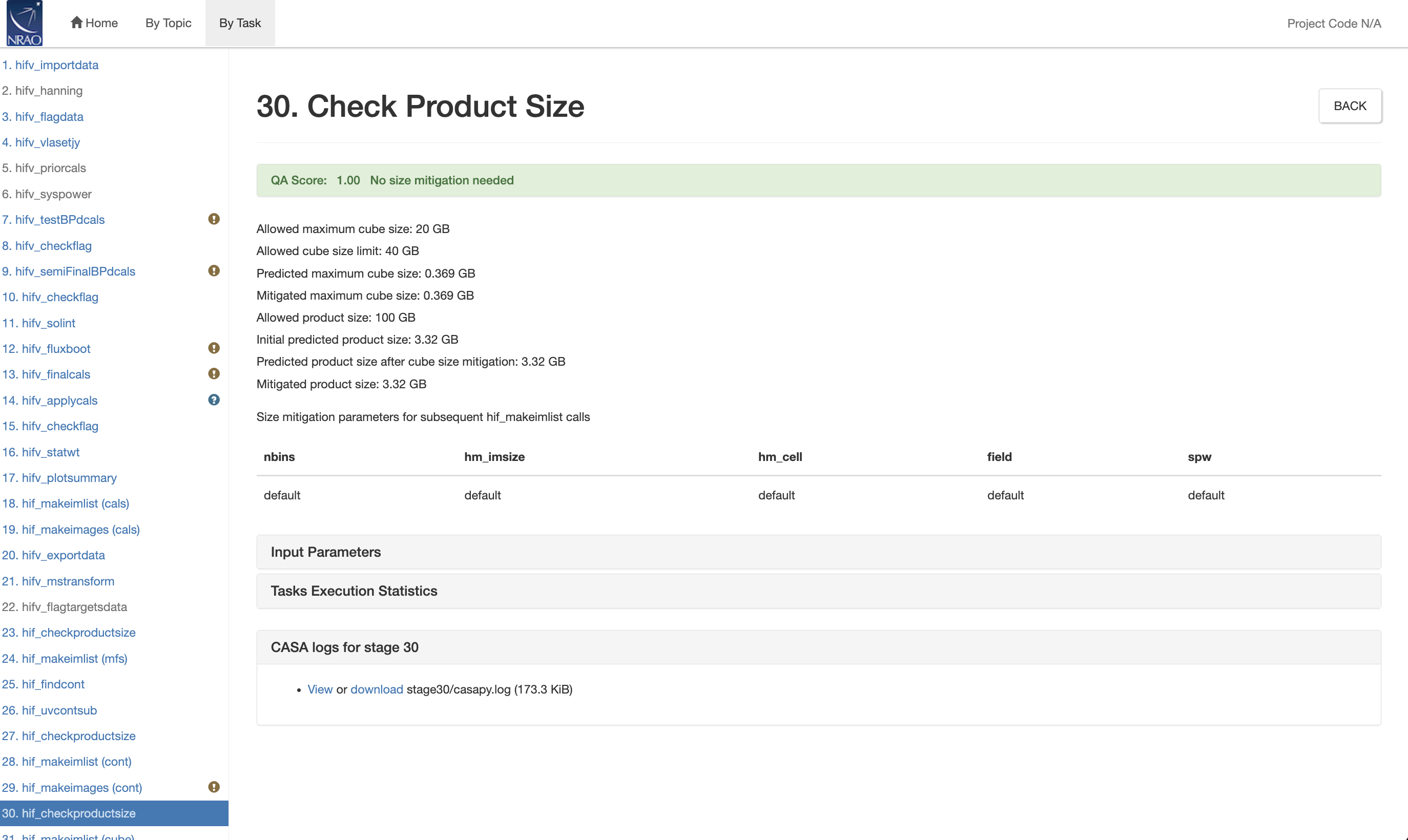 |
CHECK for: Mitigation of images.
QA: The QA scoring for this stage is 1.0 if there was no mitigation, 0.85 if mitigation was performed, or 0.0 if an error was encountered.
Stage 31. hif_makeimlist (cube): Make image list; Set-up parameters for target cube imaging
If the data are continuum only and no spectral line spws are identified, this step will be present but labeled "N/A".
Imaging parameters for the cubes are determined here.
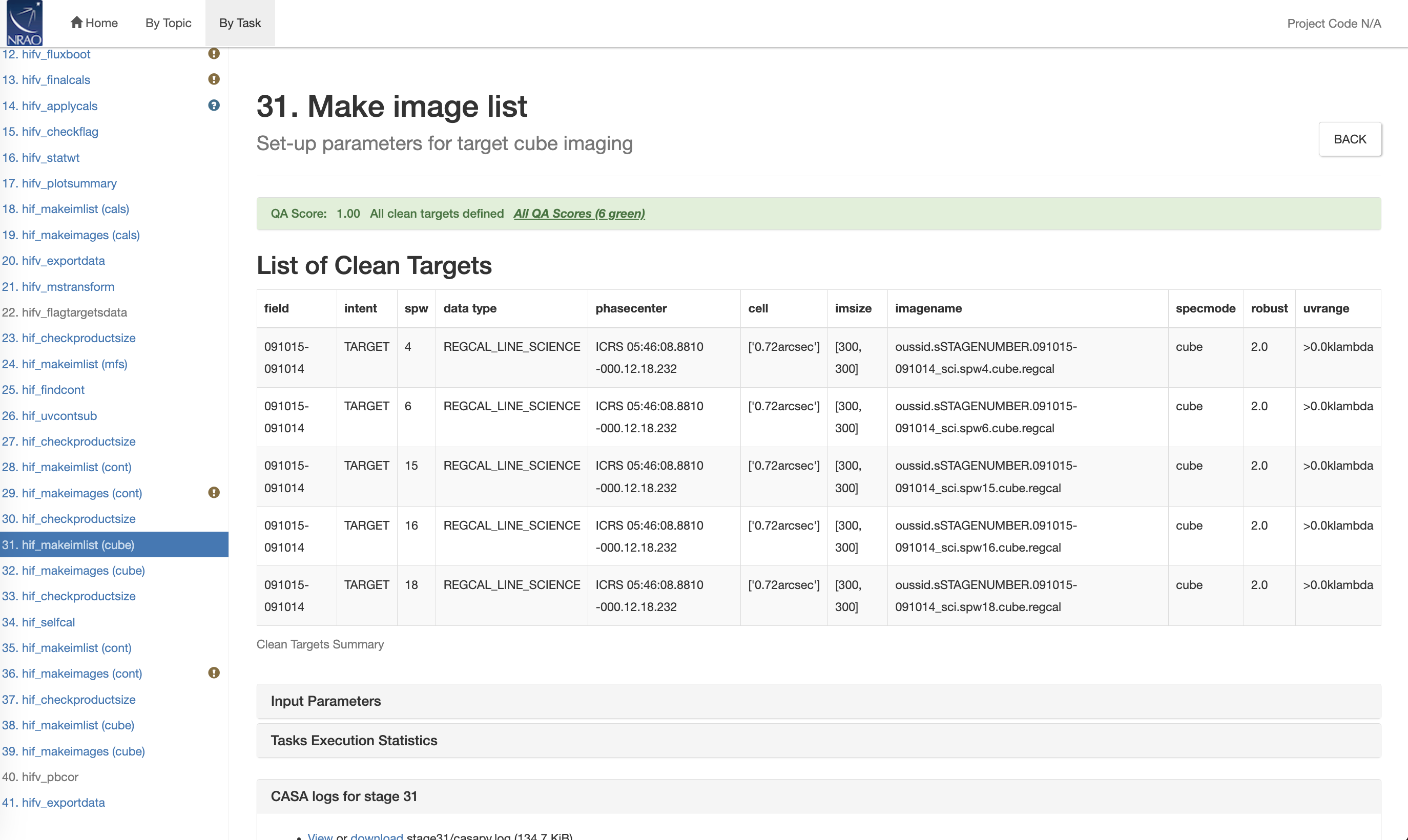 |
CHECK for: cell sizes, channel numbers etc.
QA: The QA score is set equal to the fraction of the images in the imaging list compared to the total number expected.
Stage 32. hif_makeimages (cube): MakeImages; Make target cubes
If the data are continuum only and no spectral line spws are identified, this step will be present but labeled "N/A".
It is now time to create the spectral line cubes using the parameters from the previous step. The representative images on this page are peak flux maps (Fig. S32-1; in CASA's immoments that is moment 8). Note that the pipeline does not know rest frequencies of spectral lines. Instead, it will use the center of a spw as the rest frequency for each cube. Therefore the velocities are indications only and are NOT the correct line velocities. The cube is also calculated for LSRK radio frames. The resolution corresponds to the channel width of the visibilities. The CASA task imreframe can be used to apply the correct rest frequency to each spw.
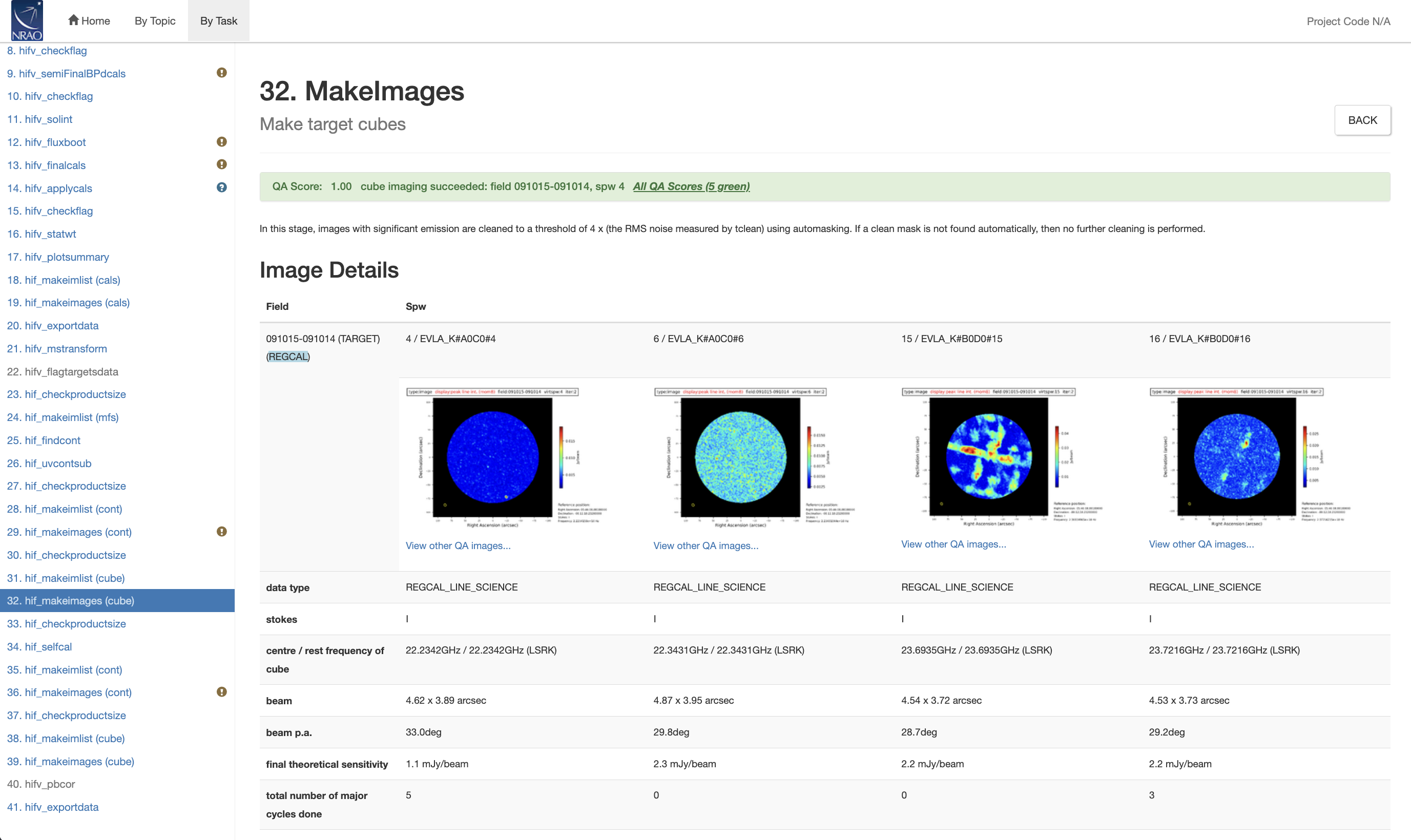 |
Clicking 'View other QA images...' provides more informational plots, e.g. the different cleaning stages, but also masks, spectra (from findcont), and integrated intensity images (moment 0). For large cubes, the beam is a function of frequency and the beam size versus channel is also represented in a plot. Deviations from a frequency dependency may indicate significant flagging for such channels.
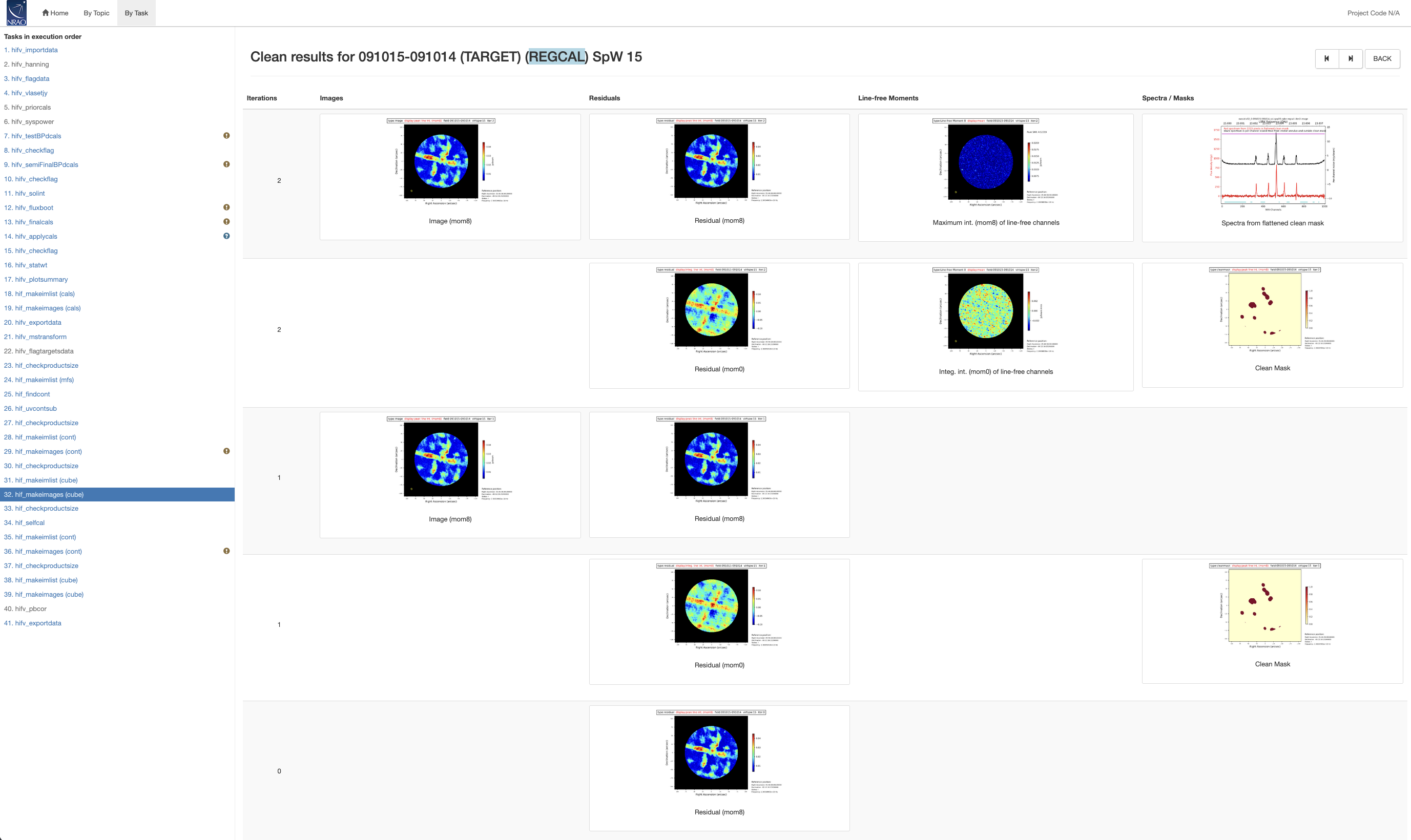 |
CHECK for: artifacts, image undersampling, deconvolution errors etc. In particular watch out for poor continuum subtraction, large restoring beams, or dramatic changes in the synthesized beam sizes. Inspecting the cubes in an image viewer is recommended.
QA: If spectral line spws and images are made = 1.0. If spectral line spws and imaging fails =0.0 and and exclamation point is provided.
Stage 33. hif_checkproductsize: Check Product Size
Before self-calibration is started, the sizes of the continuum mfs images is checked once more.
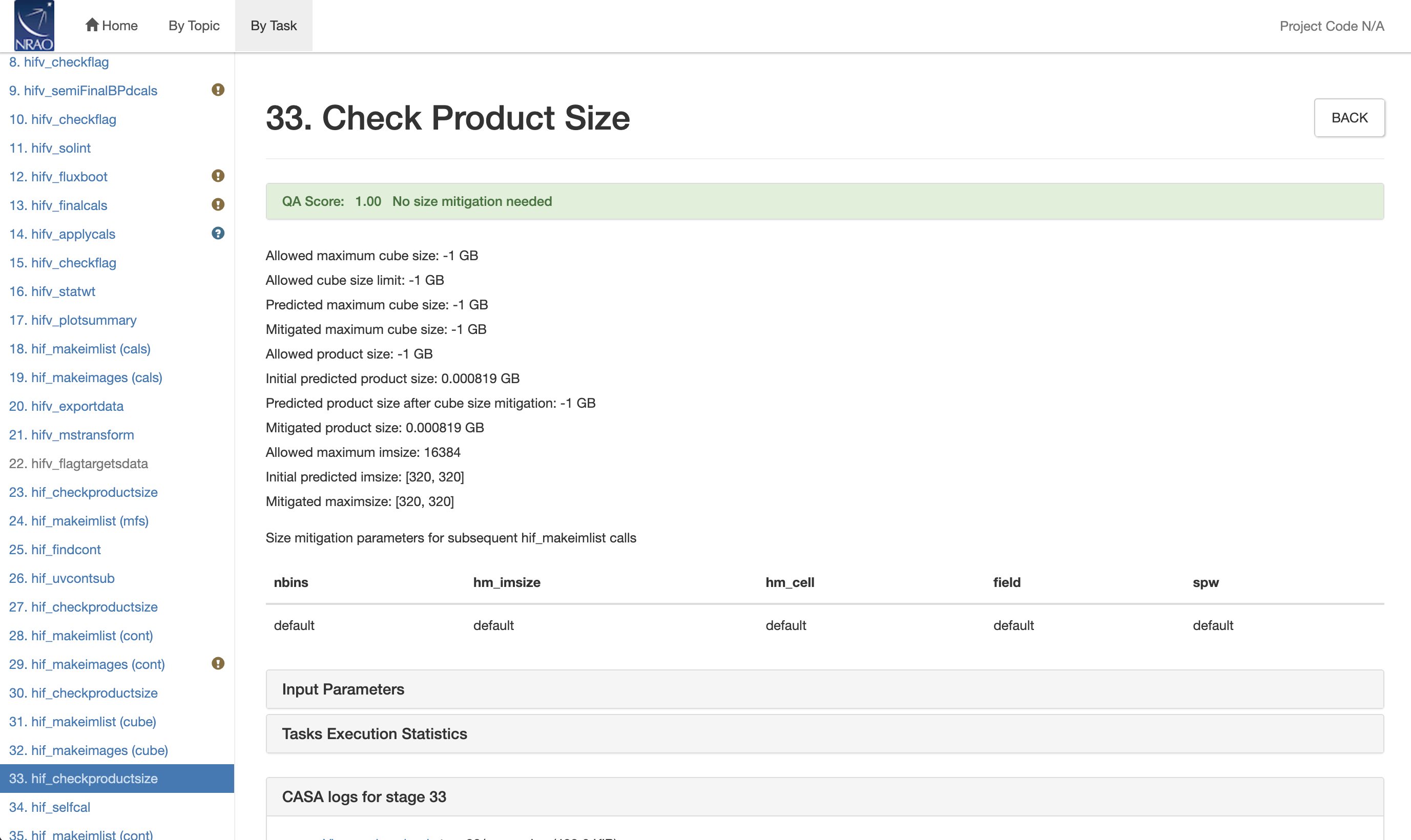 |
CHECK for: Mitigation of images.
QA: The QA scoring for this stage is 1.0 if there was no mitigation, 0.85 if mitigation was performed, or 0.0 if an error was encountered.
Stage 34. hif_selfcal: Self-Calibration using the science target visibilities
Based on the continuum images, phase-only self-calibration is now attempted on each target field (mosaic pointings will not be imaged together but treated as individual pointings). Self-calibration starts with solution intervals that span the entire MS "Execution Block" ('inf_EB'), followed by the time between complex gain calibrators ('inf'), and, when successful, derives solutions on smaller and smaller timescales until it eventually reaches the integration of each visibility or 'int'. After each iteration, imaging is performed and parameters such as the signal-to-noise ratio are checked for improvement. If there is no improvement or if other stopping criteria are met, selfcal will stop and provide the solutions for the last successful iteration.
In Fig. S34-1, a summary is provided, whether selfcal came to a better solution than the regular calibrated data (often called 'regcal' in the pipeline). Blue solution intervals were successful. In our case that was 'inf_EB' and 'inf'. As mentioned on the bottom line of this table, subsequent, smaller selfcal intervals did not improve the signal-to-noise ratio of the images and selfcal stopped.
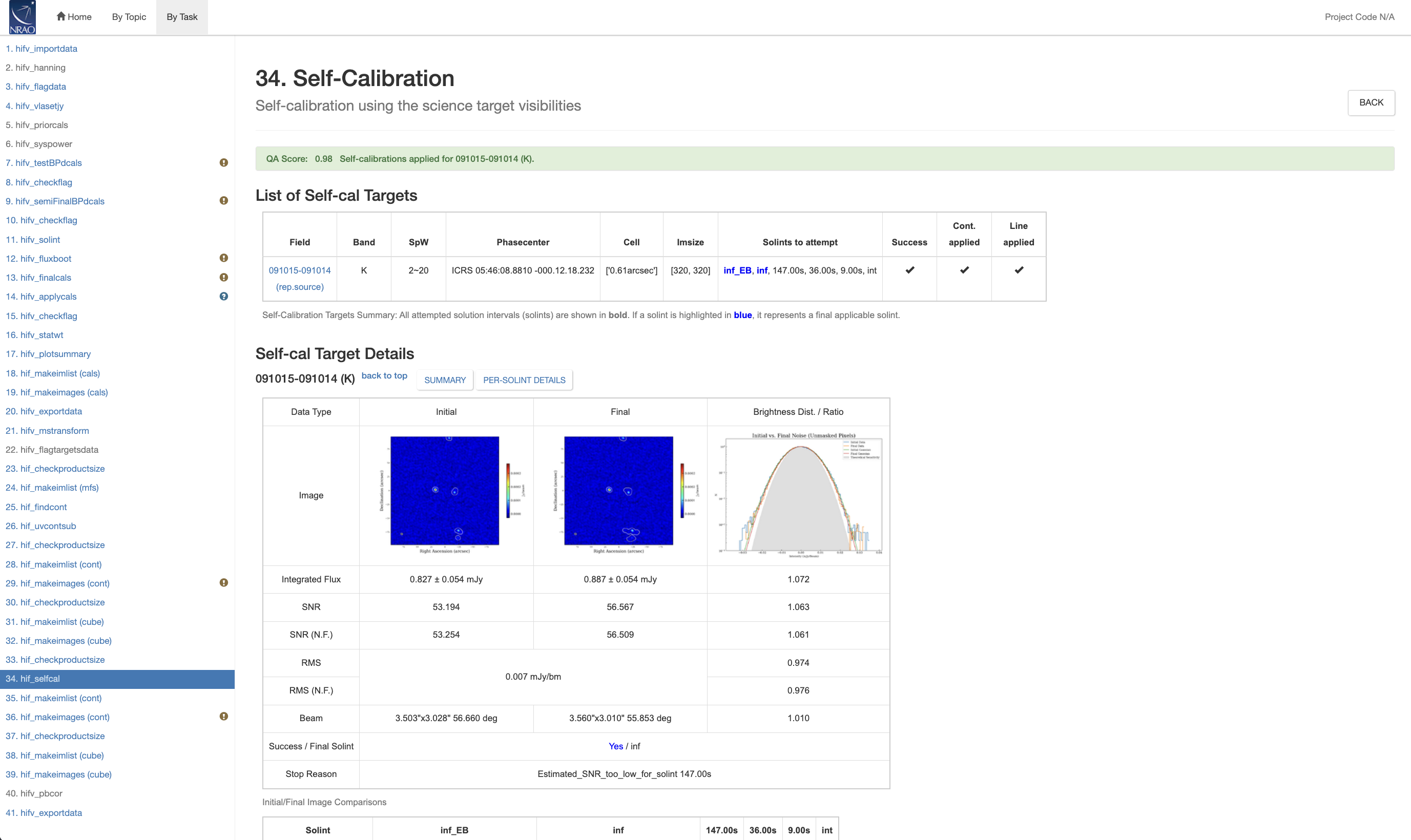 |
The third table (Fig. S34-2) shows the results of the individual iterations. As each step also includes flagging, a graph of flagged antennas is provided. The table 'QA plots' provides even more details, including the phase solutions as a function of time (Fig. S34-3).
(If the tables are not visible, press the "SUMMARY" and "PER-SOLINT DETAILS" buttons to bring them forward.)
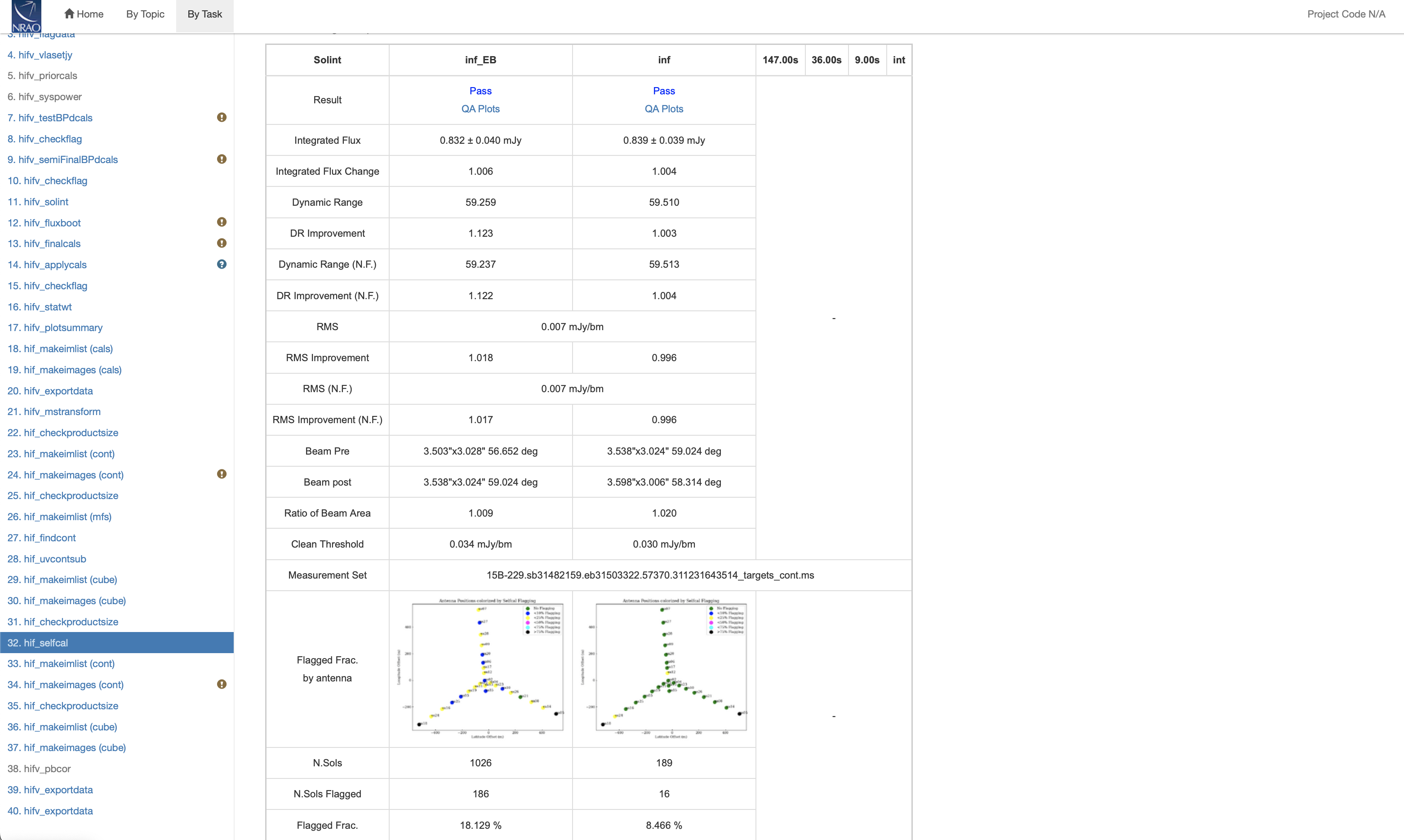 |
The "QA plots" links show additional detail, such as the image before and after selfcal, flagging statistics, and the graphs for the phase solutions as a function of frequency (for "inf_EB") or time (shorter solints) (S34-3).
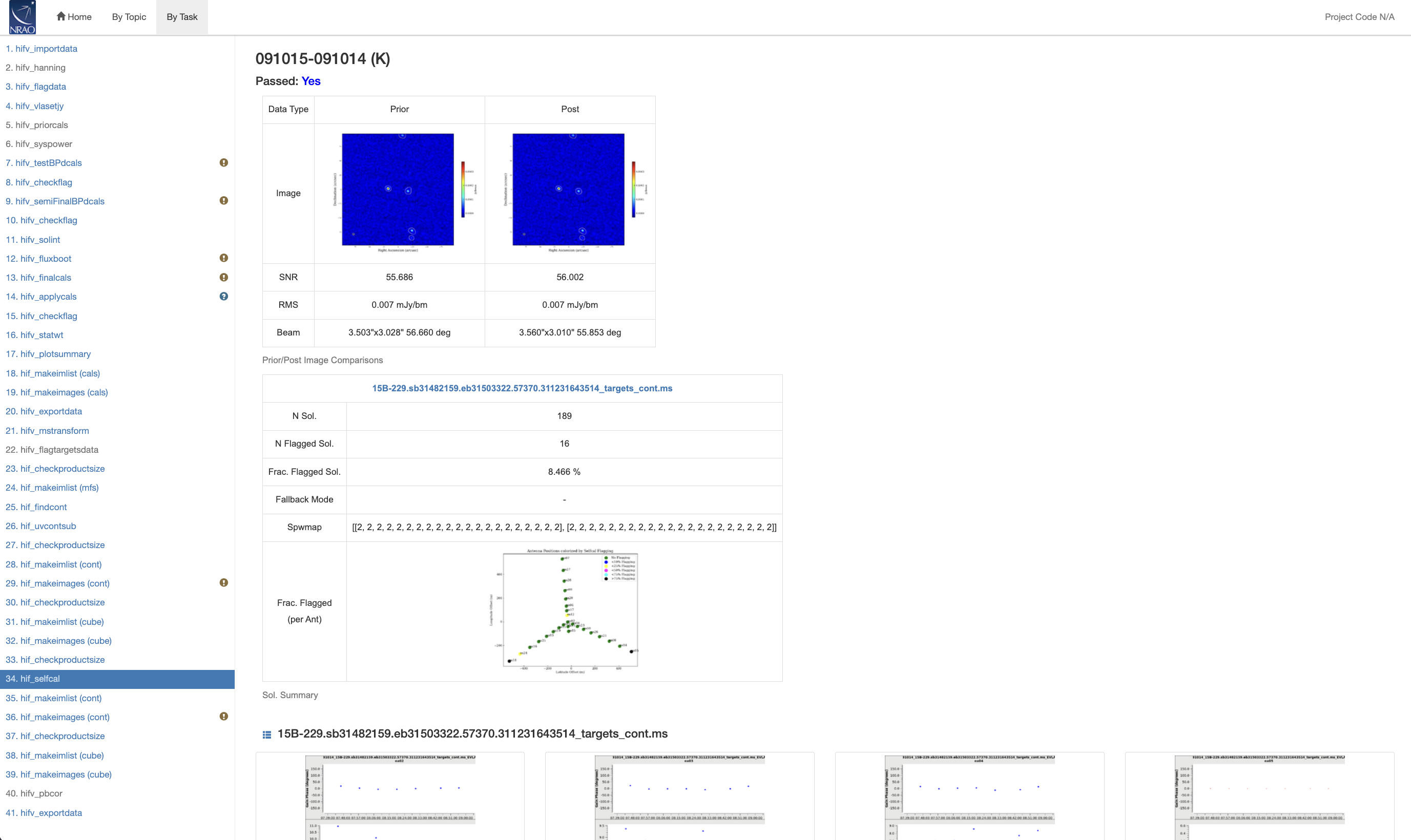 |
For more information, see the ALMA pipeline User's Guide.
CHECK for: improved images after each successful iteration. RMS should be lower, S/N higher, and image quality better. Also check the noise distribution plots for any abnormalities.
QA: The QA scores for this stage are assigned as follows: • QA=1.0 if self-calibration is not attempted because the estimated SNR is too low. • QA=0.99 if self-calibration is attempted, but does not succeed and is therefore not applied. • QA=0.98 if self-calibration is attempted, succeeds and is therefore applied. • QA=0.85 if self-calibration is attempted, succeeds and is therefore applied, but the RMS gets worse for at least one source. • QA=N/A if self-calibration is not attempted due to an unsupported mode (e.g. mosaics, ephemeris).
Stage 35. hif_makeimlist (cont): Make image list; Set-up parameters for target aggregate continuum imaging
If self-calibration failed, this step will be present but labeled "N/A".
Analogous to stage 28, this time for self-calibrated visibilities.
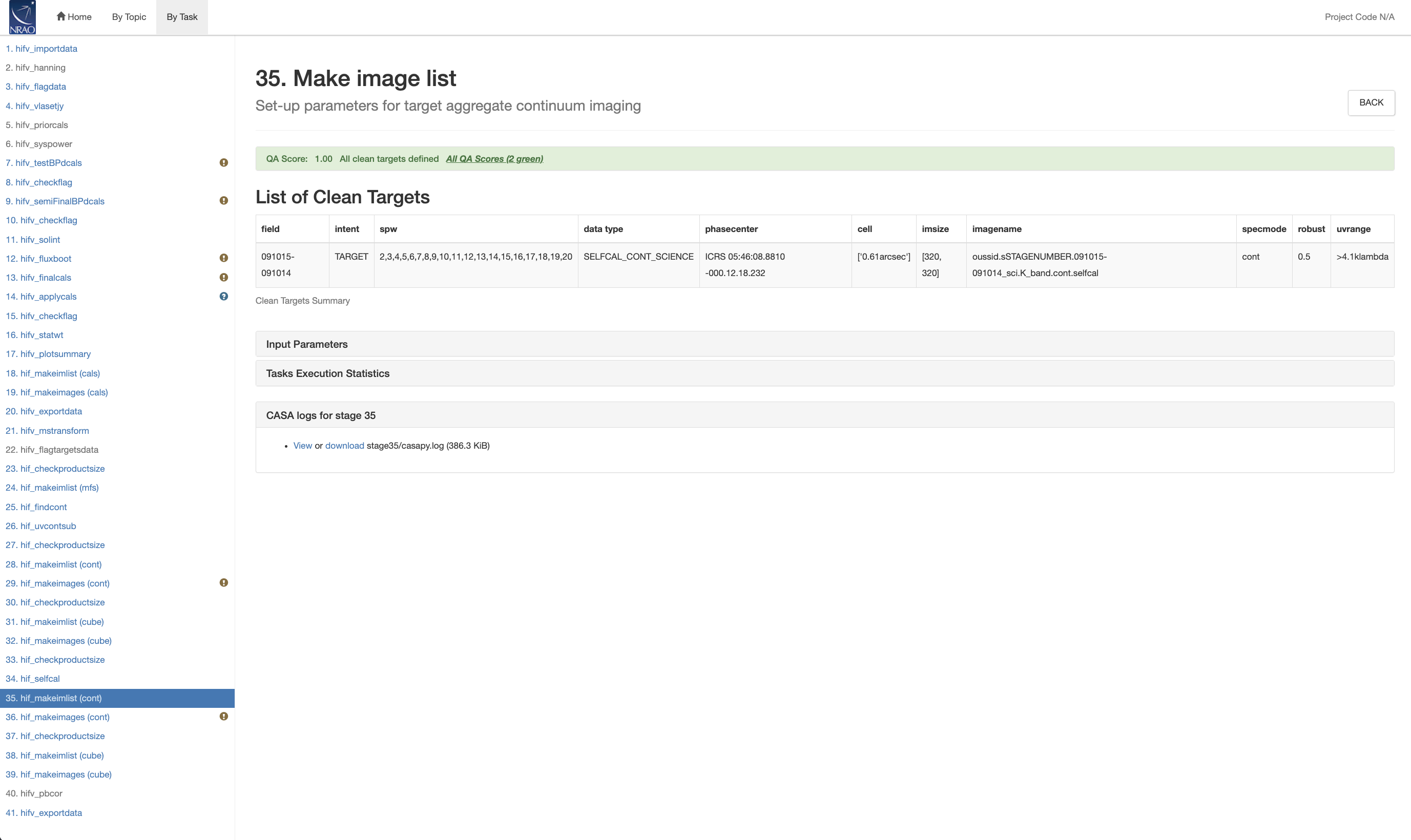 |
CHECK for: cell size, differences to stage 28.
QA: The QA score is set equal to the fraction of the images in the imaging list compared to the total number expected.
Stage 36. hif_makeimages (cont): MakeImages; Make target aggregate continuum images
If self-calibration failed, this step will be present but labeled "N/A".
Creation of continuum images like in stage 29, but using the self-calibrated visibilities. these are the final continuum images of the pipeline.
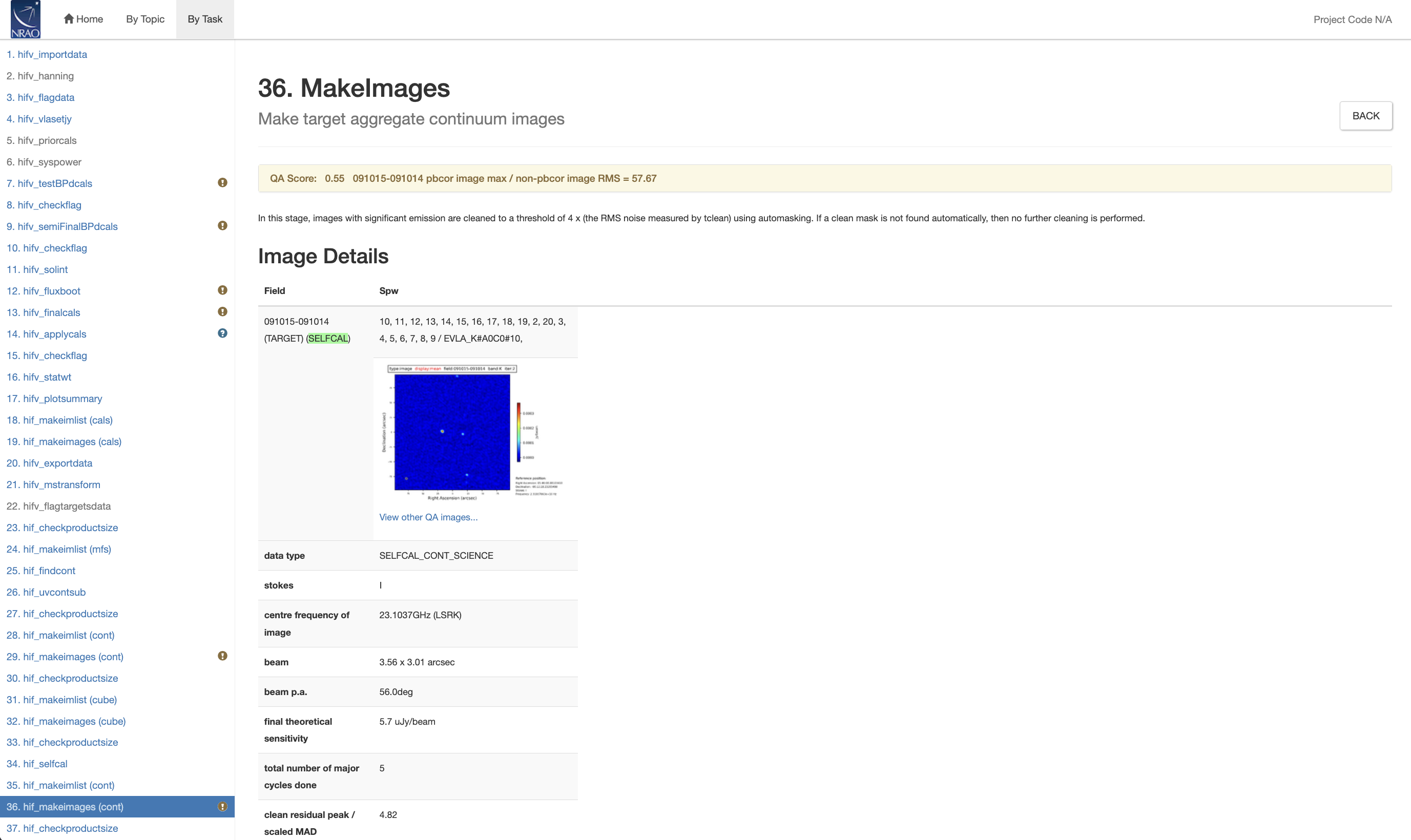 |
CHECK for: Improvements over stage 29. The improvements depend on the success of selfcal and may include reduced phase errors, larger fluxes, more pronounced structures, lower rms, and higher signal-to-noise ratio.
QA: a linear score between 0 to 1 is assigned for signal to noise ratios between 5 and 100.
Stage 37. hif_checkproductsize: Check Product Size
Yet another check for the final image cube sizes.
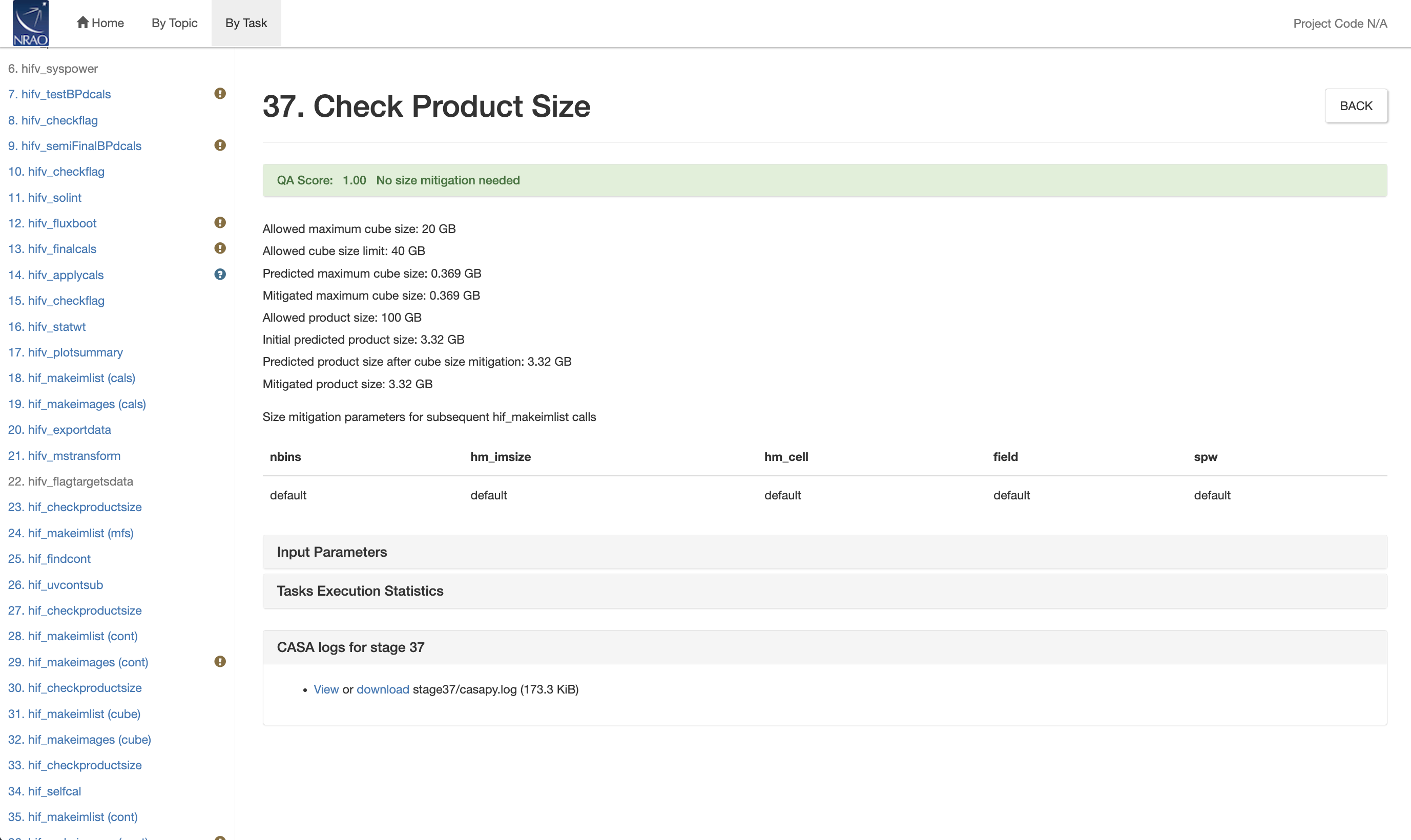 |
CHECK for: Mitigation of images.
QA: The QA scoring for this stage is 1.0 if there was no mitigation, 0.85 if mitigation was performed, or 0.0 if an error was encountered.
Stage 38. hif_makeimlist (cube): Make image list; Set-up parameters for target cube imaging
If the data are continuum only and no spectral line spws are identified, this step will be present but labeled "N/A".
If self-calibration failed, this step will be present but labeled "N/A".
The spectral line cubes are imaged again, this time using the self-calibration solutions that are transferred over from the continuum. The imaging parameters are re-calculated here.
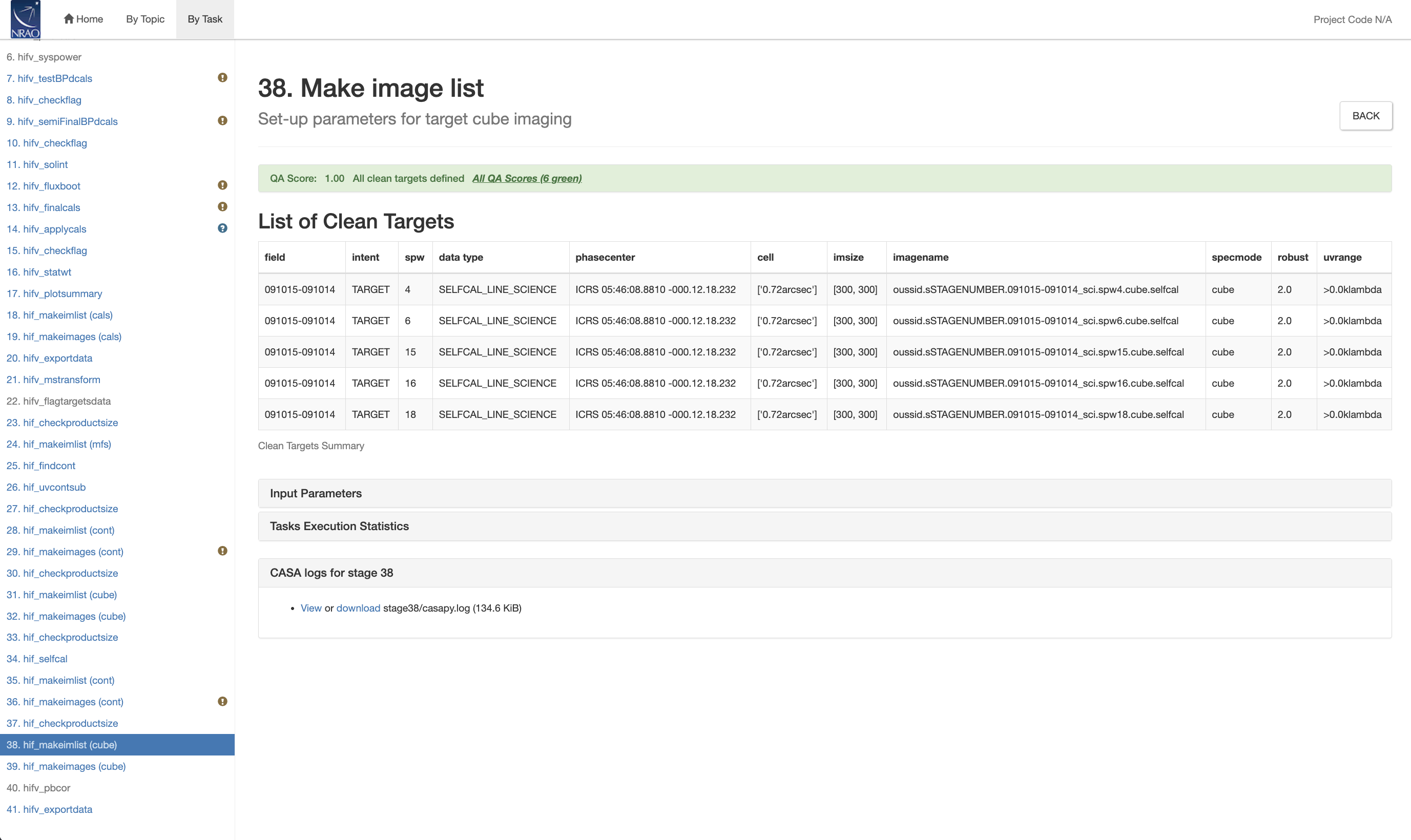 |
CHECK for: cell size etc.
QA: The QA score is set equal to the fraction of the images in the imaging list compared to the total number expected.
Stage 39. hif_makeimages (cube): MakeImages; Make target cubes
If the data are continuum only and no spectral line spws are identified, this step will be present but labeled "N/A".
If self-calibration failed, this step will be present but labeled "N/A".
These are the final spectral line cubes, using self-calibrated data. As in step 32, the representative image is a peak flux map and additional images can be found under the 'View other QA images...' link for each cube.
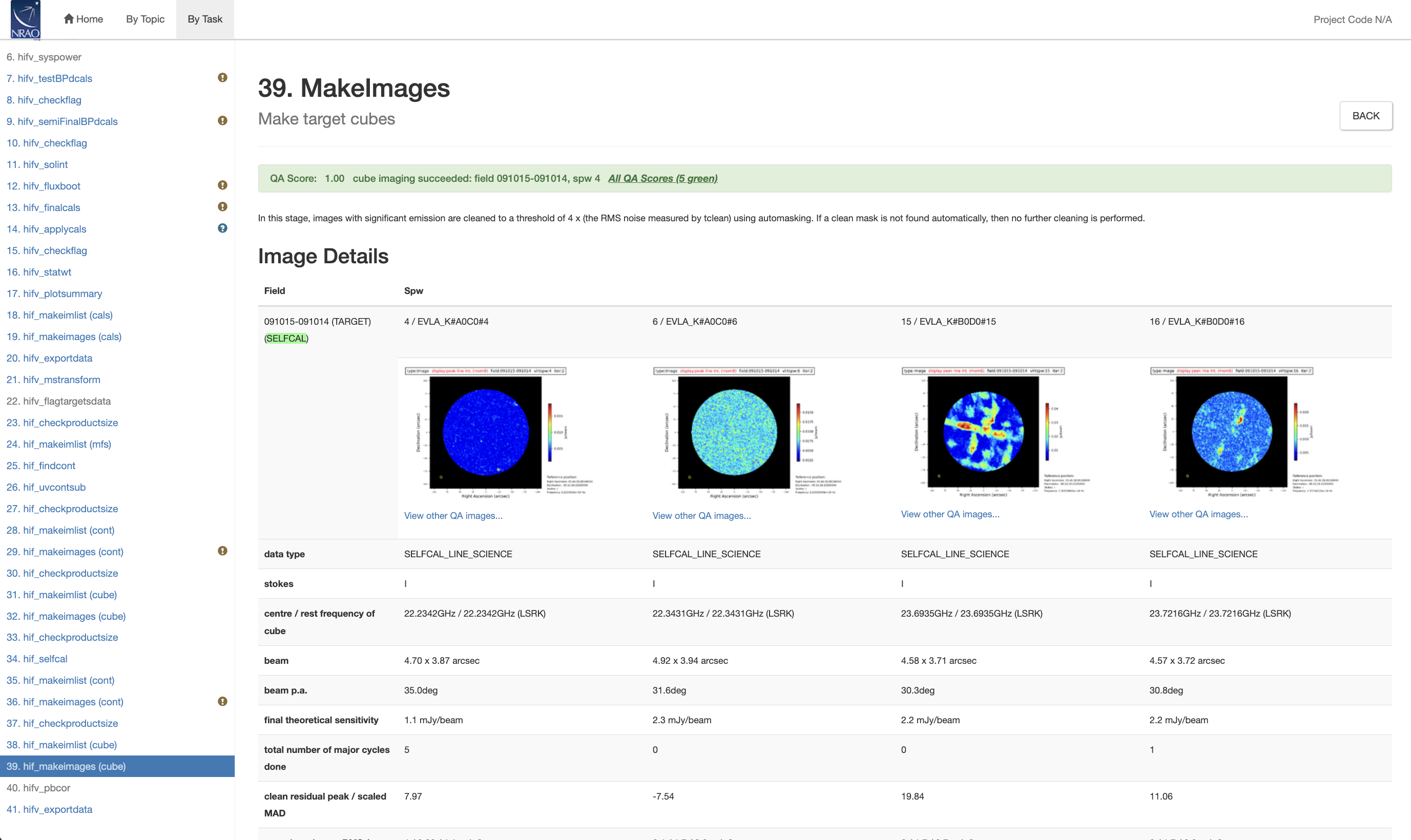 |
CHECK for: Improved image quality, rms, S/N, artifacts etc. over the results in stage 32.
QA: If spectral line spws and images are made = 1.0. If spectral line spws and imaging fails =0.0 and and exclamation point is provided.
Stage 40. hifv_pbcor: Primary beam corrected images
Spectral cubes are primary beam corrected at the time of their imaging in hif_makimages (cube). The continuum images, however, are accumulated over a much wider bandwidth. The primary beam is a function of frequency and this step hifv_pbcor does the proper calculations. Some final image statistics are provided.
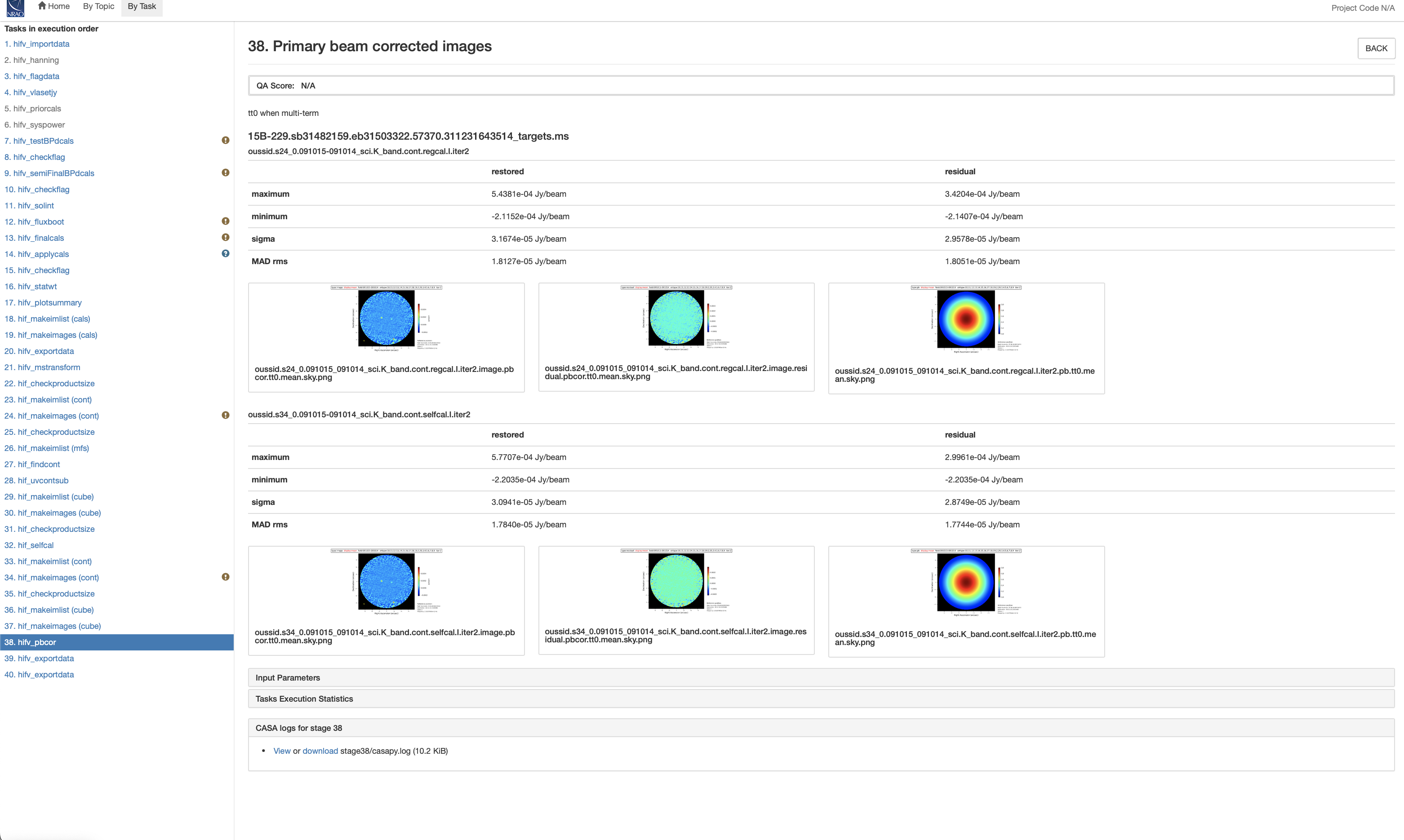 |
CHECK for: image statistics for unexpected values.
QA: N/A
Stage 41. hifv_exportdata: Data Products for Export
Exporting all the data for NRAO archival purposes, but it may also be useful for users, e.g. it converts images to fits. This overwrites the step 20, but if the imaging fails, step 20 is still a fall back for the NRAO archive. Not needed if the pipeline is run manually.
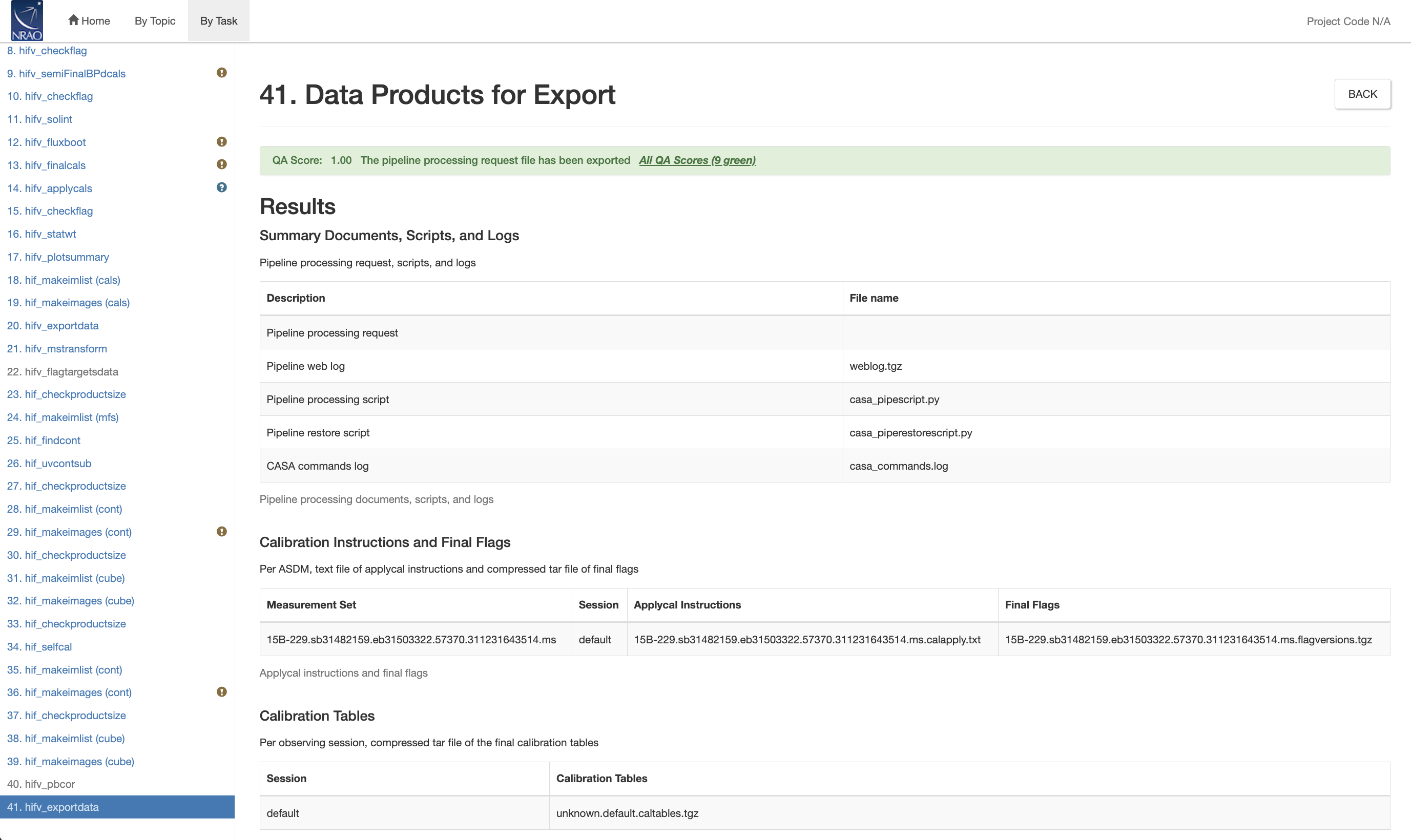 |
CHECK for: the correct set of products.
QA: N/A
Most recently updated for CASA Version 6.6.1 using Python 3.8